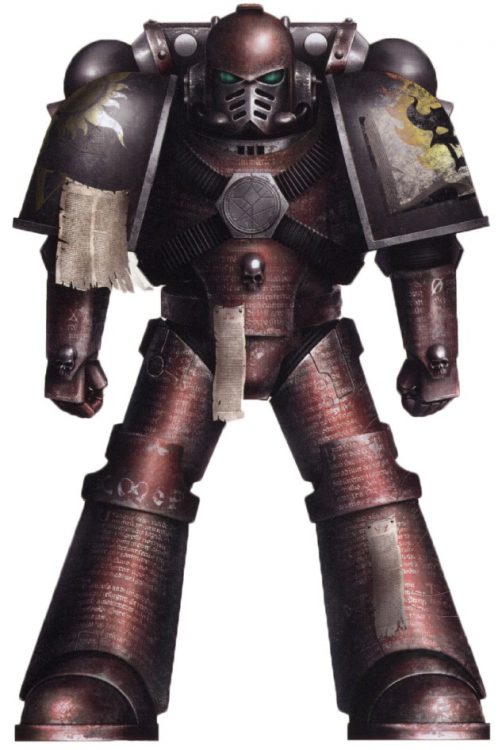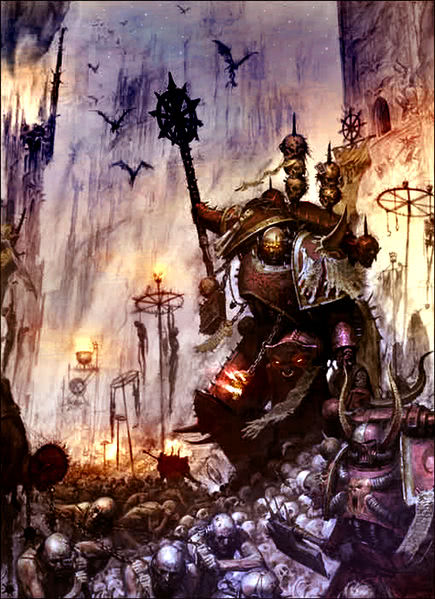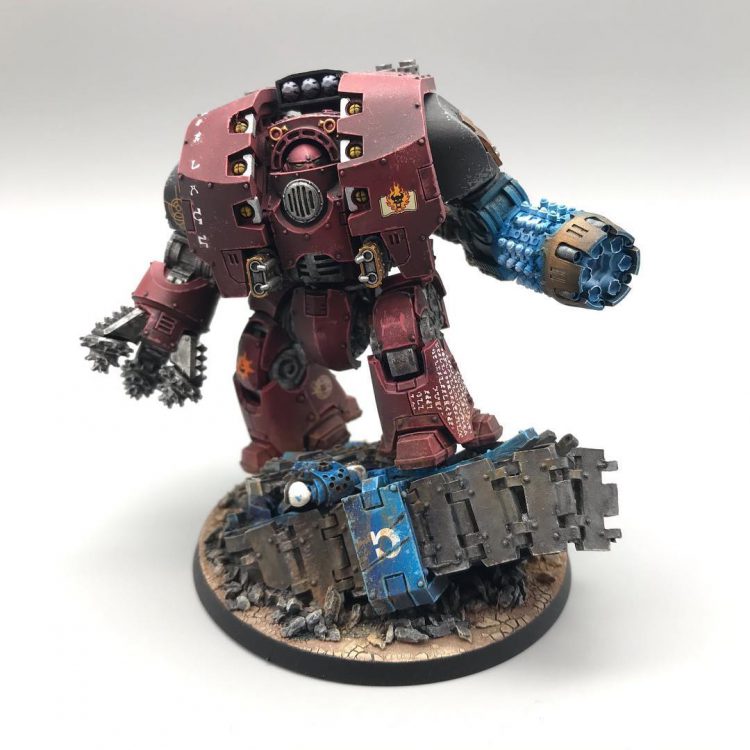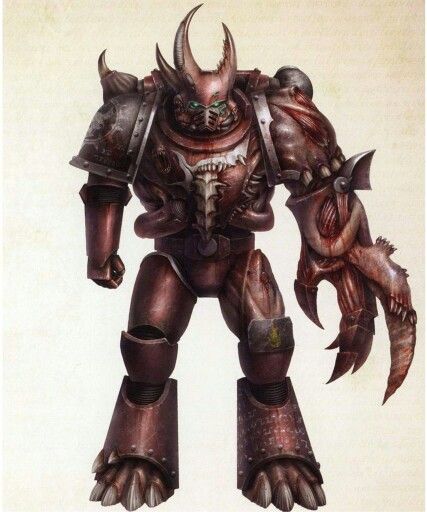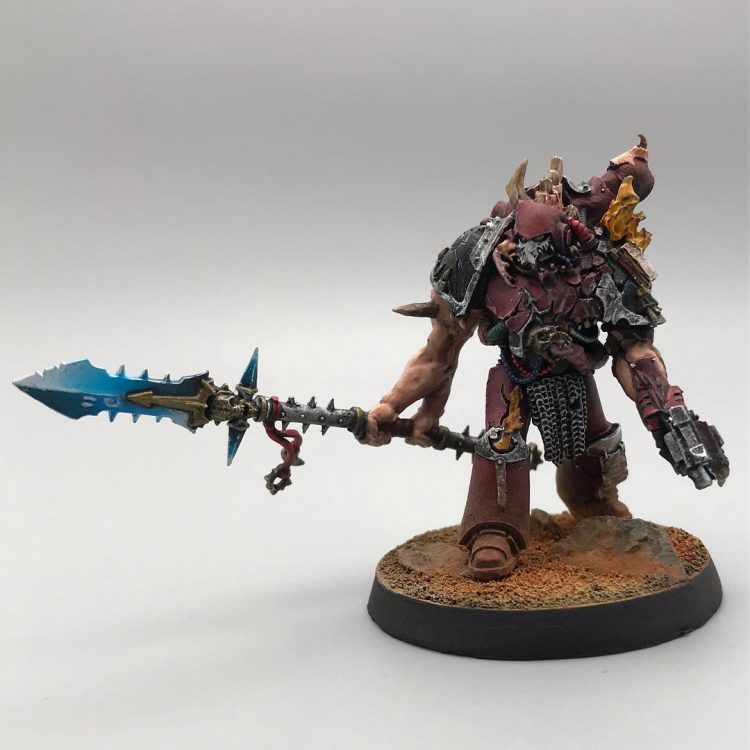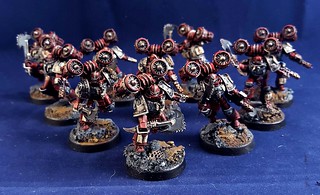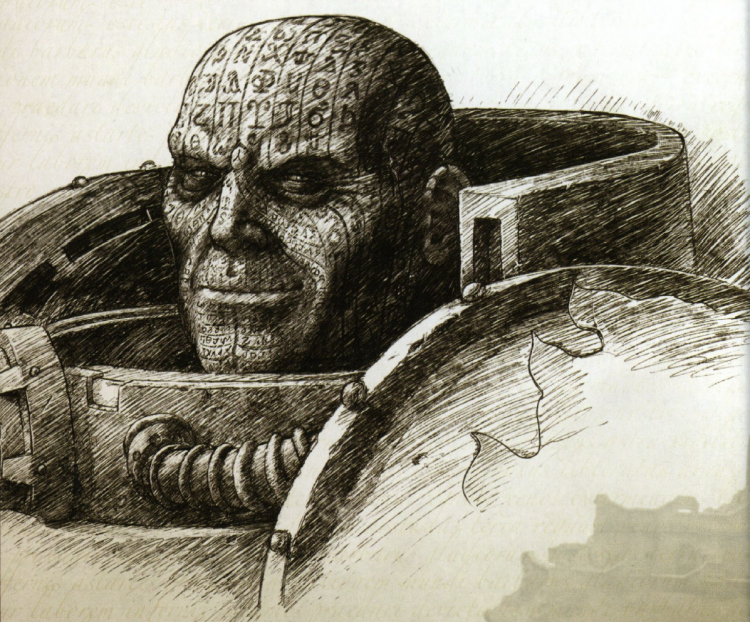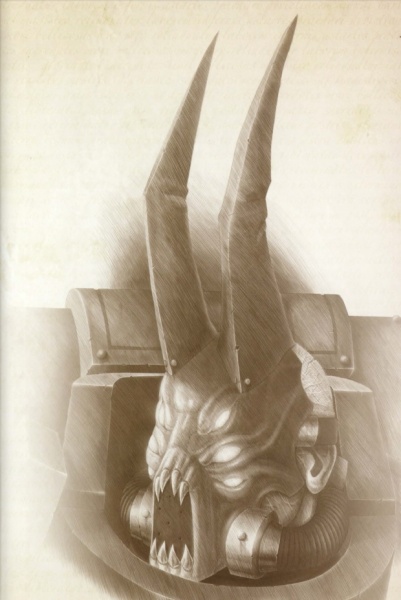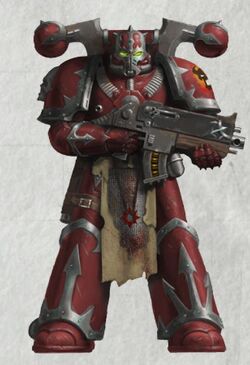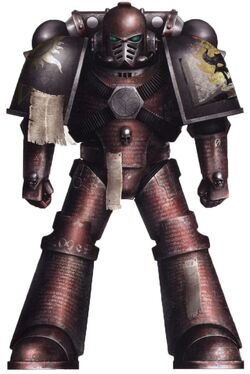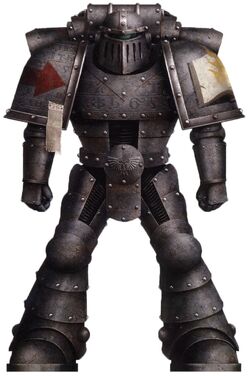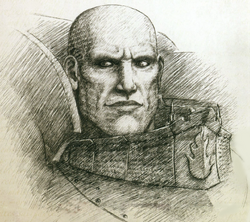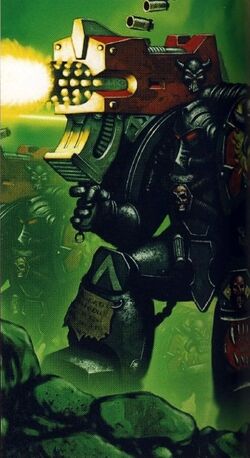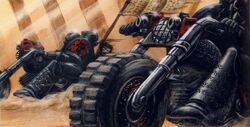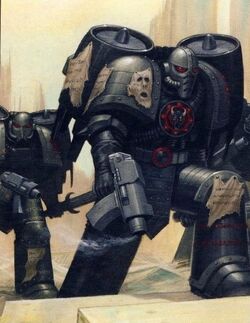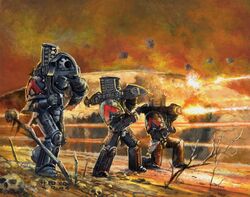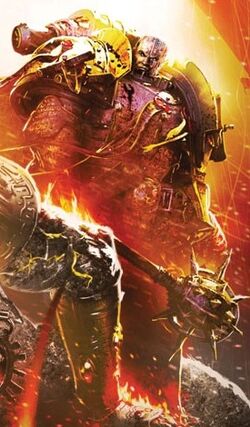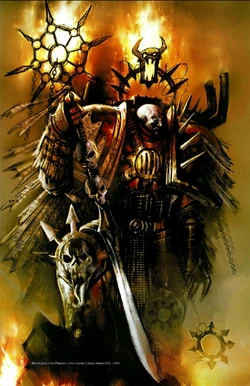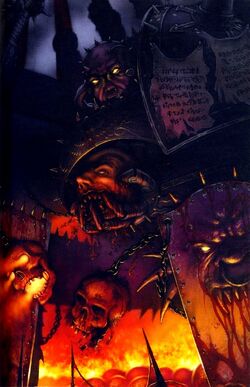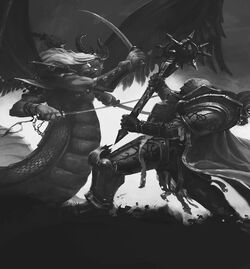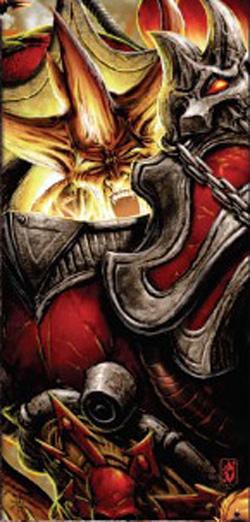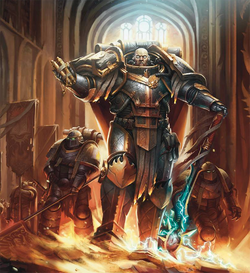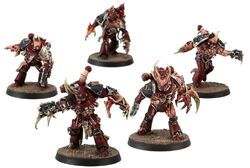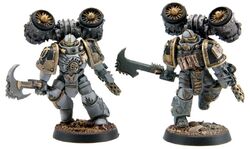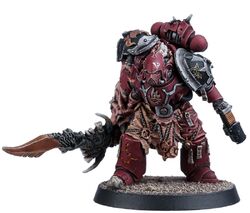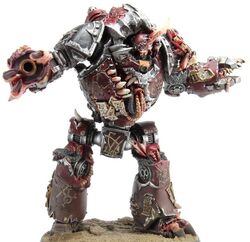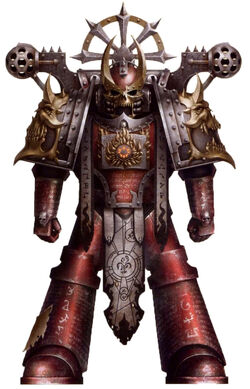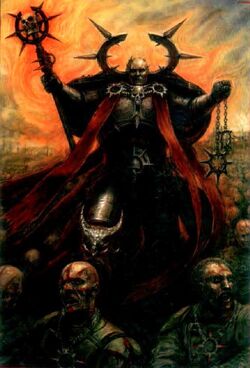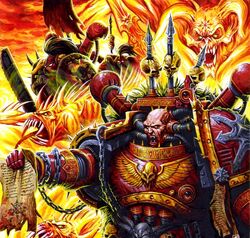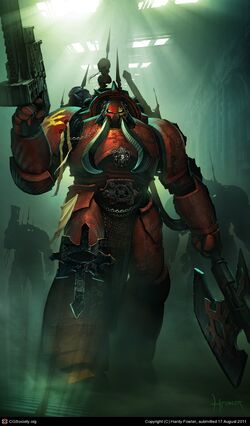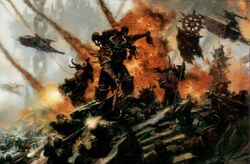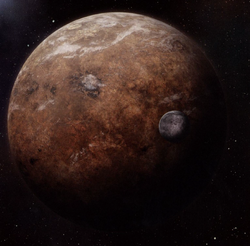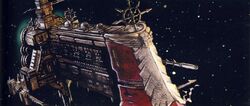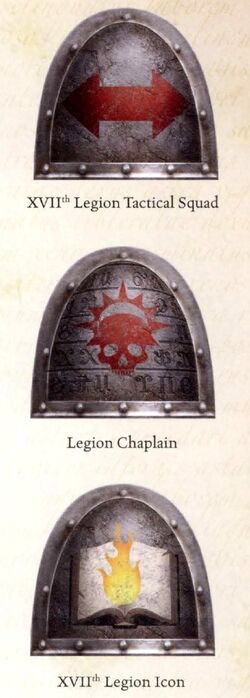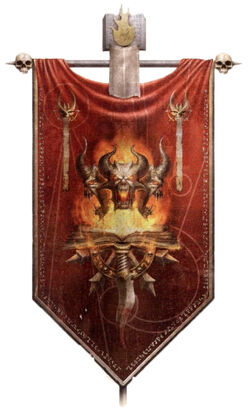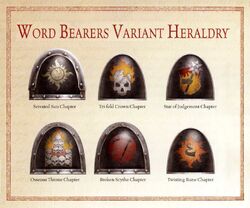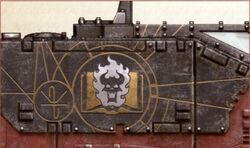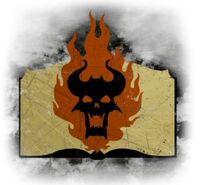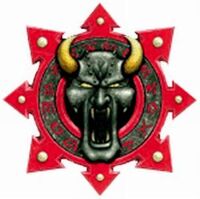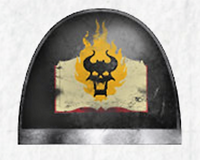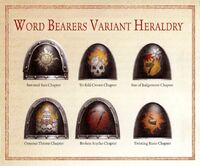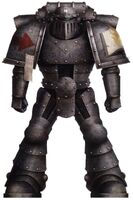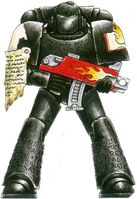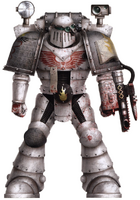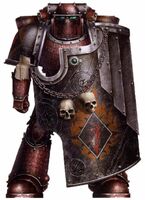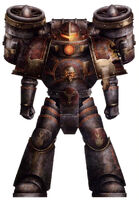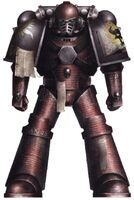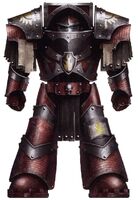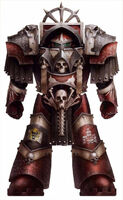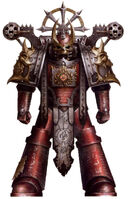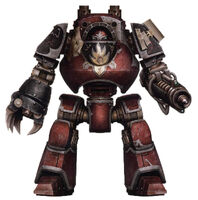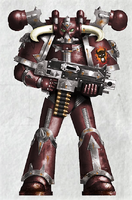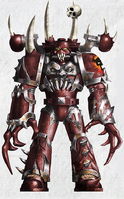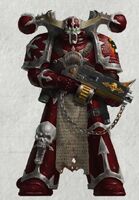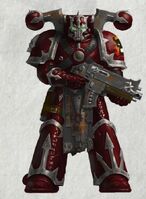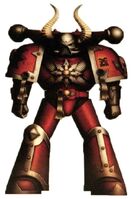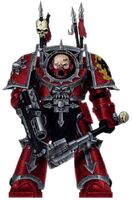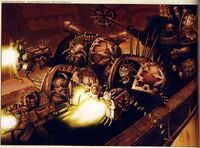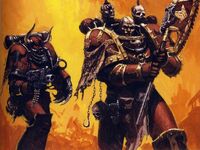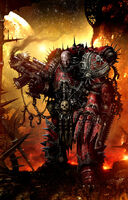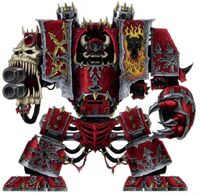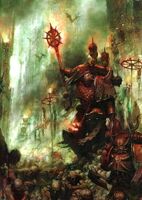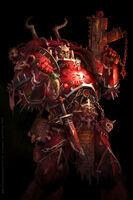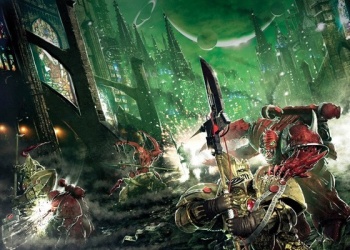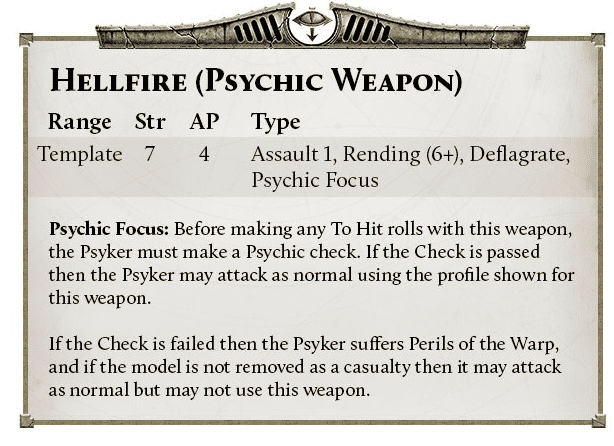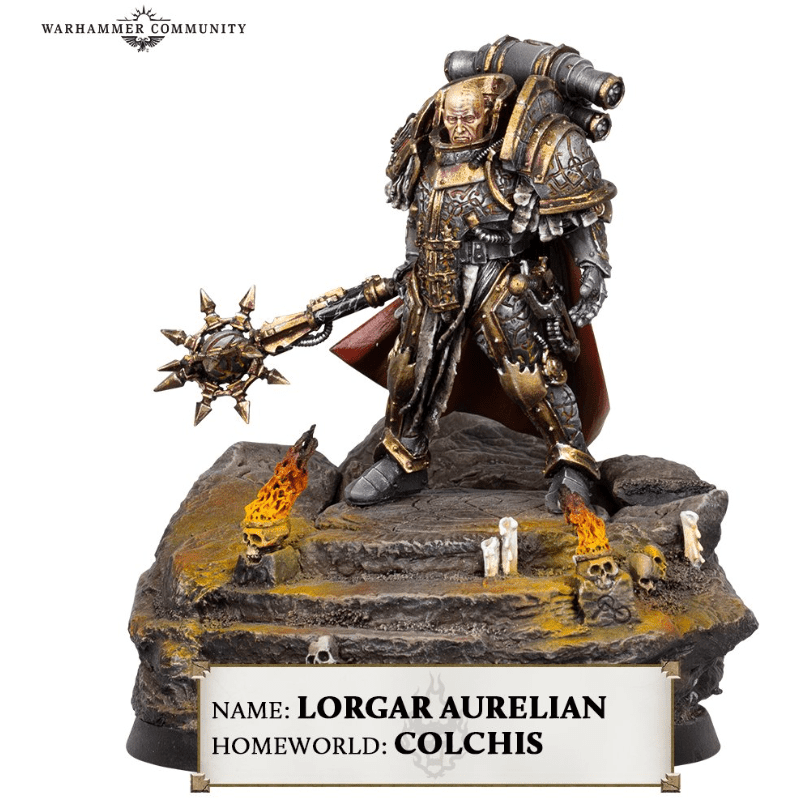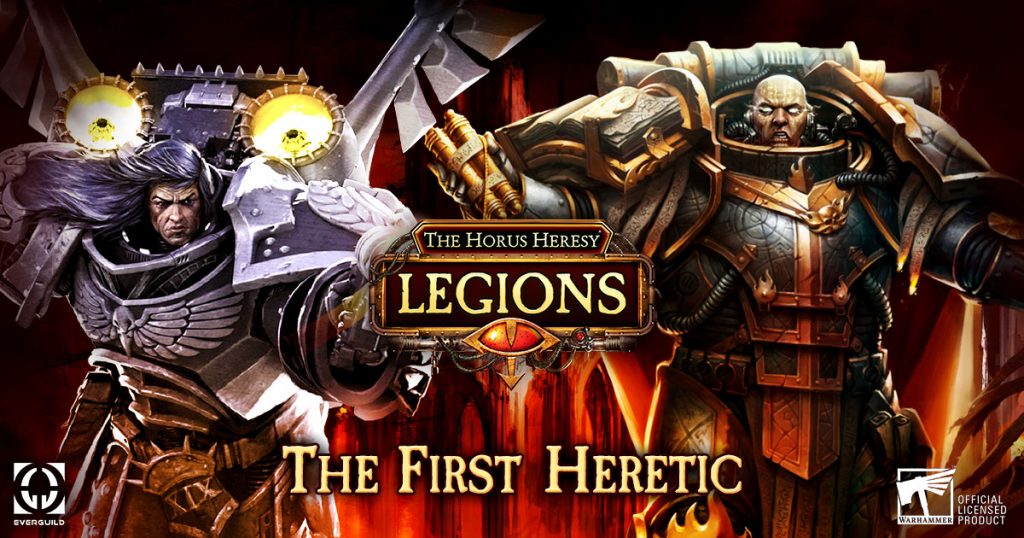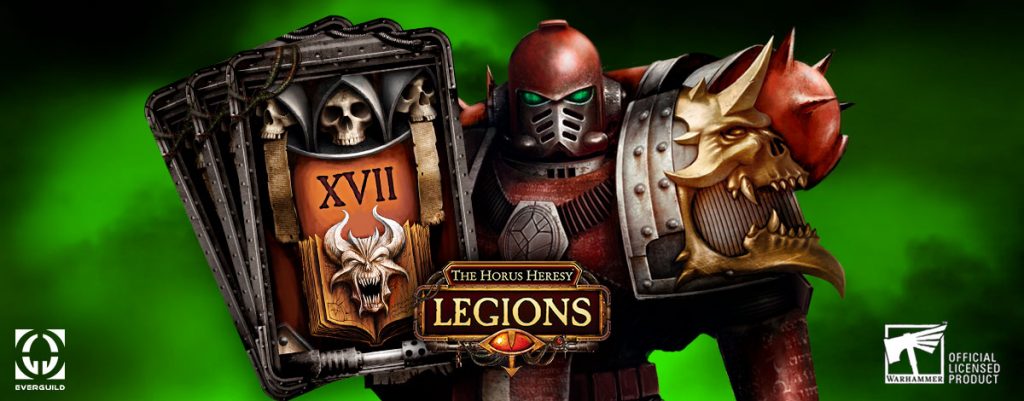The Space Marine Legions of the First Founding make up the core factions and conflict of the Horus Heresy. In this article – the third in this series – we look deeper into the background and the rules for the most iconic Heretics of all: the Word Bearers, who lit the flame that would burn the galaxy.
The First Heretics
“If there is a hierarchy of treachery, then the Word Bearers sit in its highest circle. Once the most devoted and rigorous of warriors, it was not enough that they fell, but they pulled their brother Legions into the abyss with them.”
The Word Bearers are the Seventeenth Legion Astartes, previously known as the Imperial Heralds, or the Iconoclasts. They were led by Lorgar “The Urizen”, also known as “The Aurelian”, a being who had such an unshakeable faith in the divinity of the Emperor that it led him to forsake everything and turn on the Imperium, bringing the Heresy crashing down on the galaxy.
Background
The Word Bearers were known at their Founding as the Imperial Heralds, and they held a unique role in the growing Imperium at the outset of the Great Crusade – they were to wage the ideological war, as well as prosecute vicious combat against the foes of mankind. Grim Astartes clad in black, bearing skull helms, would be dispatched to any worlds who resisted the Imperium for religious or superstitious reasons, and would deliver an ultimatum: “recant or be destroyed.”
If a world refused to accept the secular Imperial Truth, the Imperial Heralds would be responsible for tearing down their idols, burning their sacred texts, and purging incorrect thought from the subjugated populace. It may be their close involvement with the wychery and warpcraft practiced on these doomed worlds that helped hasten the fall of the Word Bearers; we will never truly know.
Lorgar himself had been raised as a Priest of the Covenant on the world of Colchis, an arid planet deeply steeped in religion and old gods. The Aurelian had risen to be a ruler of the world, and worshipped as divine by his people – yet he dreamed of the return of a golden “onegod”, which he prophesied would one day come to pass. When the Emperor arrived on Colchis with Magnus the Red, Lorgar knew his time had come, and his faith had been rewarded.
Lorgar quickly turned his legion into a blazing sword in the Emperor’s hand, sweeping across the galaxy at the head of the Crusade, each Imperial Herald a warrior of zealous fury and unshakeable faith in their Primarch and Emperor. These efforts had a dark side – some say Lorgar was throwing his Legion into warzones to “filter out” the older recruits through combat casualties, allowing him to swell the ranks with newer, freshly indoctrinated, Legionaries who would be more pliable to the Word of Lorgar rather than the Imperial Truth.
Whatever the reality, the Imperial Heralds were swiftly renamed the Word Bearers. Shortly after this, troubling news reached the Throneworld of Terra – Lorgar was openly espousing worship of the Emperor as a divine being, in direct conflict with the atheist teachings of the Imperial Truth.
Worse, they had taken the world of Khur and raised the “perfect city” of Monarchia, which was full of graven idols of the Emperor as a god, where the populace sang hymns of worship to His name.
The Emperor could not allow this to continue, and took His son Guilliman to chastise Lorgar for these foolish beliefs. In the Censure, Monarchia was levelled by the XIII Legion, and the populace reduced to ash. Lorgar and his Legion were forced to kneel before Guilliman and the Emperor, and accept that their belief was wrong, and the Emperor was no god.
Lorgar seemed to accept his humbling punishment, and fought ever harder afterwards in the name of the Emperor. However, with the benefit of hindsight, it is clear that the razing of Monarchia was the first domino to fall in the Heresy, and Lorgar would stop at nothing to prove the Emperor wrong, and that divine beings did exist among the stars.
During the Heresy
“For over four decades the XVIIth Legion wore the false face of loyalty and planted the seeds that would eventually bloom into civil war…”
After Monarchia, it is clear that Lorgar spent a significant amount of time systematically purging his own Legion of any dissenters – a slower, more methodical version of the betrayal at Isstvan III. He rapidly increased Legion recruitment to swell his ranks, and evaded the oversight enforced on him by the Emperor, in the form of an Adeptus Custodes sodality.
Not much is known about precisely how Lorgar fell to Chaos, but it is known that after the Censure he and some of his Legion went on a pilgrimage into the Eye of Terror, at the urging of his lieutenants Kor Phaeron and Erebus. When he emerged, it was at the head of a changed Legion, with horrifying possessed Gal Vorbak, and dark apostles openly preaching heresy.
Lorgar, with the help of Erebus, would oversee the corruption of Horus, and participate in the Drop Site Massacre. Most famously during the Heresy, the Word Bearers under his direction prosecuted the Calth Atrocity, betraying the Ultramarines at one of their jewel-worlds in the heart of Ultramar. The slaughter at Calth was used to kill a sun and birth the Ruinstorm, a warp-storm of unprecedented size which trapped vast numbers of Loyalists in the eastern part of the Galaxy.
Lorgar then orchestrated the ascension of several of his brother Primarchs to Daemonhood, and played the “orchestra” of the Warp to the benefit of the Traitor forces as they pursued their objectives. However, as the Heresy reached its climax, he found himself cast aside by his brothers – particularly Horus, whom he tried to lead a coup against before the attack on Terra. Rejected and alone, Lorgar fled into the Eye of Terror, where he remains to this day as a Daemon Prince.
Legion Special Rules
The Word Bearers benefit from the following Legion Rules:
- True Believers – Word Bearers roll 3d6 for Morale checks and pick the two lowest dice.
- Cut Them Down – Word Bearers must always make Sweeping Advances when possible, and must re-roll Sweeping Advance roll results of “1”.
- Charismatic Leadership – Any primary detachment from the Word Bearers Legion must take a secondary Compulsory HQ choice where this is allowed in the Force Organisation chart, and this must be either a Centurion or a Chaplain Consul.
To start with, True Believers is an excellent rule – you are unlikely to break and run as Word Bearers, which gives them a lot of reliable staying power and means in dicey combats where you’ve lost by a few points you have a better chance of hanging on.
Cut Them Down is interesting in that it forces you to Sweep, when I can’t think of a situation where you wouldn’t want to Sweep – but in any event, rerolling “1s” is nice, and means you usually finish your opponents off in close combat where you have emerged victorious.
Charismatic Leadership can be a bit of a pain, as it forces you to take a “tax” HQ. However, in the round, a Chaplain is usually a great addition to any force, and so I don’t think this is too bad all in all – and, in many ways, is very fluffy.
Legion Special Equipment & Upgrades
The Word Bearers have access to a wide range of unique upgrades, allowing for some real flavour to be added to any force.
One key thing to note is that Word Bearers have to be Traitors – all the options discussed below are Traitor only. Loyalist Word Bearers do not exist in the Heresy outside of lone individuals like the occasional Knight Errant.
- The Diabolist – a unique 35 pt upgrade for a Legion Centurion, the Diabolist gives the Centurion the Daemon special rule, with Preferred Enemy (Loyalists). It also grants access to Dark Channelling. This is an interesting upgrade, as Preferred Enemy is really strong in close combat, but conversely having Daemon can be a mixed blessing, given the new range of Psy-Arkana in Book 8 – it does, however, mean you cause Fear and benefit from Daemonology psychic Blessings.
- Dark Channelling – A 25 pt upgrade for certain squads (primarily Troops choices) if you have a Diabolist. This applies one of three random results to the entire squad – either they get Zealot (incredible! Basically a free Chaplain!), +1 Strength (also great – S5 Assault Squads and S6 power axes?) or Daemon (5+ invulnerable, Fear, and benefits from Daemonology – but you count as “destroyed” for VP purposes). This is, as you would expect from the fickle gods of Chaos, a mixed bag – don’t build your strategy around a certain result.
- Burning Lore – Any Praetor, Centurion or Chaplain can take this upgrade for +30 pts, turning them into a Level 1 Psyker with access to Biomancy or Telepathy. For Praetors, Biomancy can be potent – a decent upgrade all round.
- Tainted Weapon – You can swap any character’s power weapon with one of these, which is Specialist Weapon and Instant Death. It’s a bit niche, as it has no AP or Strength bonus, but I have been on the receiving end when wielded by Gal Vorbak against Ogryns – very nasty!
As you can see, the Sons of Lorgar have a really wide range of possible upgrades, many of which augment and amend existing unit types in interesting ways. Personally I would lean towards Burning Lore as a strong option to take, and if you are going to go for Dark Channelling I would take it on everything or nothing.
Legion Rites of War
The Word Bearers have access to two unique rites of war – The Dark Brethren and Last of the Serrated Sun
The Dark Brethren
This Rite is intended to evoke the cults and warp worship which took over the Word Bearers as they fell to Chaos, and emphasises use of warpcraft and Daemons.
To take this Rite you have to take at least one Diabolist – not too big of a “tax” as they give you Dark Channelling anyway. You can also only have one Heavy Support choice in your primary detachment, which is a bit of a blow but something you can work around (a Leviathan Dreadnought or Sicaran Arcus are good “all rounders” here). There are also no allied Legions or fortifications allowed, and any ally other than Daemons (e.g. Solar Auxilia) are “Desperate Allies”. Again, this is not a crippling restriction, as you probably won’t be using these anyway.
The bonuses you get are powerful. Daemons can be taken as allies (the Red Books say Codex: Chaos Daemons, but you should now read this as Daemons of the Ruinstorm), and all independent characters gain Preferred Enemy (Loyalist Space Marines), which really boosts their combat potential.
There are, however, some unusual “benefits” – the Signs & Portents rule means you pick a single Troops choice and roll a D6 – on a 1-3 all enemy units get Preferred Enemy against it, and on a 4-6 that unit gets Preferred Enemy against all enemies. Don’t pick anything too important, as a 1-3 is very bad! I personally have had an unlucky Word Bearer opponent roll poorly on this rule for a large unit of Assault Marines, and this allowed me to take them apart with ease.
Finally, you have Hell follows with Them – Perils of the Warp wounds suffered by the enemy have Instant Death. This is great for dealing with enemy psykers, and will make your opponent more cautious about using Santic powers against your Daemons, due to the higher risk of a Perils.
All in all this Rite is not a “must-take”, but it has some nice benefits and makes for a fluffy force if you use Daemons of the Ruinstorm alongside your Legionaries.
The Last of the Serrated Sun
This Rite of War is probably one of the most unique in the game, and I absolutely love it on paper – sadly I have never seen it used in practice! If I was going to collect Word Bearers, this is what I would go for.
Gal Vorbak can be taken as Troops Choices, and get access to Drop Pods and Anvillus Pattern Dreadclaw Drop Pods as Dedicated Transports, which they must take. Any other units who can get a Rhino instead can instead get a Drop Pod. You’re unleashing howling horrors of the warp via a “steel-rain” drop pod attack – what could be better?
Well, when any Drop Pod or Dreadclaw lands, enemy units within 12” of the final landing zone have to take a Pinning Check. This means, realistically, you’re going to be forcing a ton of Pinning Checks on enemy units as you deploy your forces – and if anyone fails one, they’re a juicy target! Don’t forget Dreadclaws also have a chance to damage things around them with Fire Sweep as they land as well.
The limitations here are, unfortunately, quite stringent – all infantry units have to deploy by Deep Strike, either in a Drop Pod, teleportation or a Flyer (no jump packs). You can’t take any fortifications or allies either. The “hidden” issue to consider is that Gal Vorbak cannot score – so loading up on too many of them means you won’t be able to score objectives.
However, if you think about it, drop enough Gal Vorbak in, and you won’t need to worry about scoring…
Legion Special Units
Just as a preliminary note – the Word Bearers currently have the most special units and characters of any Legion. You can really go wild with these!
Mhara Gal Tainted Dreadnought
This… thing is unique – a half-melted, corrupted, daemonic Dreadnought with “fire-blackened armour running like molten wax”. The model for this is absolutely stunning, albeit complex to paint – a mixure of flesh, bone and ceramite which takes some colour planning before you tackle the project.
To start with, the price tag for this unit is steep – 305pts before you start to upgrade it. However, it has a bevy of special rules, and in Zone Mortalis it is probably too good to be allowed.
First of all, it has the Daemon rule – this means you can buff it using Daemonology powers, with the double-edge to this sword that Santic powers and Psy-Arkana could hurt you. It also has It Will Not Die, and 4 Hull Points, with WS7 – so better all round then a normal Contemptor right off the bat.
Next is Shroud of Dark Fire – the corrupt antomantic reactor of the Mhara Gal causes it to be engulfed in warp-tainted flames at all times. This reduces the strength of heat, fire or plasma based weapons by 1 (good luck using combi-meltas against this – outside of Melta range they’re glancing on 6+ on the front arc), and anything with a Toughness of less than 7 or a front AV of less than 13 fighting this takes -1 to hit in close combat.
And on top of that, if it explodes, its S6 AP5 in a seven inch (“Massive”) blast with Soul Blaze. This makes the Mhara Gal a terror in close combat, as the usual Contemptor-killers like Cataphractii are swinging on 5+ to hit it, and a lot of the “usual” anti tank weapons are blunted.
Then you have Accursed – the Mhara Gal, as a Daemon, causes Fear at -2 to the check. It also means it never scores, but this is not much of an issue. The problem with this rule is that Daemons and/or Psykers and/or units which get given any Blessings within 6” of the Mhara Gal suffer a S5 AP2 Ignores Cover hit – friend or foe. This makes you have to keep this thing on its own – as a lot of your own forces are going to be Daemons and/or Psykers!
Finally, the big one – The Earth Recoils. This allows the Mhara Gal to completely ignore terrain, and move through obstacles up to 1” across without penalty. This means you cannot block this beast off, and in Zone Mortalis it will just stroll across the battlefield to annihilate whatever is in its way. I have fought it once in Zone Mortalis, and found my mighty unit of Imperial Fist Terminators with Stormshields were hewn down like chaff – a humbling experience.
Its weapons are even unique as well – its power claw is a standard Dreadnought Close Combat Weapon on paper, but it has the horrifyingly good rule Ghost Razor – reroll successful Invulnerable saves from this weapon. If you want to clear out Firedrakes, this is how you do it. Its boltguns even cause Blind!
The Mhara Gal then has access to a unique Plasma Cannon which forces any unit who has taken a casualty from it to take an instant Morale Check at -1 Leadership.
Now that I have written all this out, I do have to ask myself – why would you not take this? It can’t be dropped in by Drop Pod, so generally has to walk across the field, but overall it is a real unholy terror, and cannot be ignored. The price is high, but you really get what you pay for!
Gal Vorbak Dark Brethren
These are “the” iconic Word Bearers unit – Heresy-era Possessed marines, and in my top 3 of Horus Heresy models. These sons of Colchis looked into the Eye of Terror… and it looked back at them.
These can be taken in squads of up to 10, and start at a unit of 5 for 200 pts. This is very good value – they come with Rending, Deep Strike, Rage, Stubborn and the Daemon special rule, which gives them a good base for strong close combat performance. The basic Dark Brethren have 2 wounds each, S, T, WS and I 5 on top of that – they will outperform basic Marines in every way. The Dark Martyr does one better, with 3 Wounds and the ability to take a S10 Power Fist.
Just watch out for the fact they only have a 3+ save – the Daemon invulnerable isn’t great at 5++ – and they can be doubled out by Demolisher cannons and Dreadnoughts in close combat. Rending is also good, but won’t guarantee kills against 2+ save units, so pick your battles. They also can’t score, but you aren’t going to be camping objectives with these.
I would definitely find room for these in any Word Bearers army, and probably run them quite cheap – give the Dark Martyr Artificer Armour and a Power Fist, and put them in a Land Raider or Dreadclaw.
The Ashen Circle
Like some other units, the Ashen Circle have benefited from a set of FAQ “playtest” rules. Everyone uses these, so pick them up on Warhammer Community.
Under these rules they start at 145 pts for 5 Ashen Circle, who have Assault Marine stats with WS5 – so not bad – along with hand flamers and S5 AP3 Axe-Rakes which strike at initiative and at +1 to Sweeping Advance rolls. These are outstanding for their points, and allow you to absolutely cull basic enemy troops.
On top of this, if the unit Deep Strikes then units within d6” suffer a S3 AP5 hit – average – but also they can always use Hammer of Wrath, even if they used their Jump Packs to move. This adds up to a very hard hitting combat unit, and the Sergeant can take phosphex bombs as well, which makes them all round very threatening on the table.
I think a squad of ten of these can find their way into any Word Bearers army – and their models are outstanding on top of that.
Legion Special Characters
High Chaplain Erebus – Child of the Primordial Truth
Erebus needs no introduction – he is the First Heretic, and the true architect of the Horus Heresy – his teachings are what corrupted Lorgar, and his theft of the Anathame triggered the events which led to the fall of Horus on Davin.
On the battlefield, Erebus starts with a basic Praetor statline, with some special rules layered on top. Conveniently, he counts as both a Diabolist and a Chaplain for the purposes of Rites of War and similar for Word Bearers, so he represented a significant points saving in this regard – and he comes with Burning Lore for additional Psychic powers. He also unlocks Daemon allies and Dark Channelling without the need for anything extra in this regard.
Lastly, if he is the Warlord, all enemy units within 12” must use their lowest Leadership value, not their highest – this can be quite nifty for attacking units containing Characters and forcing them to flee.
Overall, he is never a bad choice for a Word Bearers army, as all of his abilities segue with generally all the good choices for this Legion – whether it is large numbers of Dark Channelling troops, Daemon allies, or using one of the Rites of War.
Kor Phaeron – First Captain of the Word Bearers
Curiously, Kor Phaeron is a First Captain who isn’t a Space Marine – he’s only Toughness 3!
Unfortunately in the Horus Heresy this is a massive handicap – plenty of weapons have Strength 6 or better, so you are risking your Warlord (the Jealous Command rule means he will be the Warlord, unless Lorgar is present) to things like Volkite Culverins, Autocannons, etc.
Overall Kor Phaeron is… merely OK, even if you set aside the poor Toughness. His Cataphractii Terminator Armour gives him 6+ Feel No Pain, he has a pair of Lightning Claws with a One Use hand flamer (average – he will struggle against enemy characters with 2+ saves and only has 2 Attacks base), and unlocks Dark Channelling. When Kor Phaeron is on the field, Word Bearers Legionaries also have +1 Leadership, to a maximum of 10. These are all alright, but aren’t going to set the world on fire or mitigate the poor Toughness.
All in all, I would not recommend him unless you are going for a fluffy list – you’ll still have to take a Chaplain alongside him, he’s rubbish in combat, and you’re just going to be handing Slay the Warlord to your opponent.
Zardu Layak, The Crimson Apostle
Another fantastic model by Forge World – and a character with mysterious origins. Zardu Layak is a possessed, mutated herald formerly of the Ashen Circle, with an insectoid head and daemonic banner.
On the tabletop he has Centurion stats, but Toughness 5 and Daemon – a nice bonus. Beyond the stats, the true meat to this character comes from a range of equipment and special rules which set him apart from the pack.
To start with, he is a Level 2 Psyker – very helpful – and his Force Stave, while merely AP4, gives him +2 Strength and allows him to reroll one failed psychic test per game. If he’s the Warlord, then you can take Ashen Circle as scoring troops (great!) and must give them Dark Channelling (which is also great – extra Strength or Zealot? hello!). You also get Daemons of the Ruinstorm as allies, which is another very nice bonus.
On top of all this, he counts as a Diabolist for the purpose of Legion rules and Rites of War, and grants Dark Channelling with a +1 modifier. The latter actually isn’t great – it makes the Daemon result more likely, as opposed to the arguably “better” Preferred Enemy or +1 Strength.
Finally, he has the Panoply of Flame, which is a great-looking banner which gives +1 modifer to assault results within 12”, +1 to Sweeping Advance (on top of your re-rolls of 1!) and you can use it once per game as a Heavy Flamer.
For 175 pts, Zardu Layak is a real steal – he has a great range of rules, and allows for very interesting army builds, while being not bad in a fistfight if called upon.
Anakatis Kul Blade-slaves
A real swing and miss for Forge World with the rules here – the models for these are gorgeous, but I rarely, if ever see them taken.
The reason why is simple – you buy them for 100 pts as an upgrade for Zardu Layak, but then they form their own unit which you cannot merge with other units – so you have 3 guys at 275 pts walking around, with no ability to deliver them into combat, or properly take advantage of things like the Panoply of Flame or Zardu Layak’s psychic abilities. Very frustrating!
On paper they are pretty good – S6 and T5 with 3 Wounds and Initiative 5, with Rage and Daemon on top. Their Anakatis Blades – weird Daemon swords from the Ghoul Stars with some chilling fluff – are AP 3 with the possibility to rend on a 5+ and inflict double wounds, which is pretty devastating.
Mindless Killers means if Zardu is dead, then they become “mindless” and have to go towards the nearest enemy and charge – which is pretty crap as they’re footslogging. They also have plasma pistols, which I guess is OK.
Great models, poor unit rules. Use them as alternative Gal Vorbak, which is what almost everyone I know does.
Hol Beloth – Chapter Captain of the Graven Star
A fast-strike specialist who oversaw the Battle of Calth, Hol Beloth is a Praetor level character who can ignore the first failed save of any game (really good!), and can increase all Word Bearers Legionaries to WS5 (if they aren’t already that or better) for one turn once per game. This can lead to some devastating charges, particularly as he causes Fear if he is the Warlord.
Otherwise he’s fairly standard, with a Master Crafted power fist and plasma pistol, but with his stats he will still hit like a truck.
He does not stand out from the crowd, but if you build a list with his special ability in mind (e.g. massed Assault marines or Tactical Marines with extra CCW), you could really do some work.
Lorgar – Master of the Word Bearers, Aurelian, The Golden, The Voice of Truth
Lorgar unfortunately has a poor reputation amongst his brother Primarchs – he is usually thought of as the runt of the litter, and not someone who is going to stand toe to toe with any of his peers.
In some ways this is true. While he has a Primarch’s statline – so nothing to sniff at – he is not focused on combat and lacks some of the special abilities which make, say, Leman Russ so strong in a straight fight.
What Lorgar does bring to the table are a number of buffs for his sons. While he is on the field and not in a transport, he confers Crusader to any unit he is in, and allows all Word Bearers to use his Leadership 10 for morale checks – combine that with rolling 3d6 and picking the lowest, noone is running wen he is around. In addition, any Word Bearers unit who can draw line of sight to him get +1 to charge distance, immunity to Fear and +1 to assault resolution, making everyone generally better!
Dark Fortune is an incredible rule – Lorgar can reroll failed Deny the Witch rolls for Lorgar (OK, but not great – psykers are not that common in Horus Heresy), but on top of this, once per game Lorgar can force a single enemy model or unit to re-roll all rolls of a 5 or 6 to Hit and to Wound Lorgar and the unit he is with in a player turn.
This can be pretty savage if used correctly – depending on who he is fighting, they could need 5+ or 6+ to even Hit or Wound in the first place, forcing your opponent to reroll all successes. Add Lorgar to a unit like Gal Vorbak, and watch your opponent bounce off them as you bring the punishment!
His armour is standard – 2+/4++, with a 3++ invulnerable against psychic attacks – and the Illuminarum, an ornate sceptre-maul, makes him Str 8 AP2 in Close Combat – good, but not exceptional.
Finally, however, there is a great upgrade for Lorgar called Lorgar Transfigured – which I think is a must take for this Primarch. For 75 pts (he starts cheaper than most as it is – so this isn’t too bad), he becomes a Level 3 Psyker who can select powers from Divination and Telekinesis, and manifests on a 3+ rather than a 4+. If you don’t take this, the Erratic Psychic Power rule is used instead, which makes Lorgar a terrible Level 2 Psyker choosing randomly and manifesting a 5+ – this is absolutely dreadful, so take this upgrade!
Choosing powers is absolutely broken if you combine Lorgar with the right units. Put him with Gal Vorbak, and give them Prescience for rerolls… The possibilities are endless, and being able to choose the powers gives you much-needed certainty to build strategies.
Sample Army List
I set out below a suggested starting force for Word Bearers of 1,500 pts. This force is intended to use mainly plastic kits, with some upgrades from Forge World or third party sellers (I would recommend Spellcrow and Anvil Industry). It is not intended to be a “perfect” list, but rather what I would probably take if I wanted to get into Word Bearers on a sensible budget. Note that this points bracket is a little bit tricky for Word Bearers due to Charismatic Leadership forcing a second HQ.
Rite of War – None
- HQ – Chaplain with Jump Pack, Artificer Armour, Refractor Field, Axe Crozius
- HQ – Chaplain with Artificer Armour, Refractor Field, Axe Crozius
- Elites – Mhara Gal Tainted Dreadnought with two Tainted Power Claws
- Elites – Gal Vorbak Dark Brethren, Power Fist and Artificer Armour
- Troops – Assault Squad with 12 men, Melta Bombs, Artificer Armour, Power Fist
- Troops – Tactical Squad with 15 men, Artificer Armour, Power Fist, Extra Combat Weapons
- Heavy Support – Land Raider Phobos with Dozer Blade
This army is small, but designed to combine a number of very high priority targets in 1,500 pts, while taking advantage of large Troops squads to maximise the morale benefits granted by the Word Bearers Legion special rules. The Gal Vorbak and Mhara Gal push up the board, supported by the fast-moving Assault Squad, while the Tactical Marines hold an objective or push up to hold ground.
Expanding this force is fairly simple – max out the Assault Squad and Tactical Squad with 20 men, and add another Troops Choice, like more Tactical Marines. Then it is a case of working out which direction you would like to take. Chainfist Terminators in an Anvillus could be a good complement, along with some Cortus Contemptors.
The good thing about Word Bearers is that they are flexible in what you can bring – I have seen people run a lot of Rapier platforms (as they don’t run away as easily), or go heavy on the Gal Vorbak, or equally decide instead that Daemons of the Ruinstorm allies is what they want to invest points in. The Arch-Traitors can make a lot of things work!
Conclusion
The Bearers of the Word are a Legion with a lot of choices and scope for different builds, all of which will have good morale, strong psychic abilities, and access to things other Legions don’t have, like Daemon allies. I think they are a good Traitor Legion if you are not sure exactly what sort of force you want and don’t want to commit to a Legion with a specific playstyle (like, say, World Eaters).
They are also well supported in the fluff and have a lovely colour scheme which is quite forgiving with the new Contrast paints.
For the Dark Gods!
Check back in the New Year when we go through the Word Bearers’ staunchest foe – the boys in blue: The Ultramarines. And in the meantime, if you have any feedback, questions, or notes, drop us a message in the comments below, or email us at contact@goonhammer.com.
«Speak the words of Lorgar and you shall live forever in the glory of Chaos. Speak them not and every one of you shall die today.«
- —Ultimatum made at the gates of the capital city of Moegh IV before a Word Bearers’ assault
The Word Bearers are one of the nine First Founding Space Marine Legions that betrayed the Emperor of Mankind during the Horus Heresy. They became Chaos Space Marines, their allegiance pledged to their Daemon Primarch Lorgar and to Chaos Undivided. The Word Bearers were also the first Space Marine Legion to be corrupted by the Ruinous Powers of Chaos many solar decades before their counterparts turned to the service of the Dark Gods.
Through their actions they corrupted the Warmaster Horus and brought on the terrible galactic civil war of the Horus Heresy in all its savagery. Today they bend all their considerable efforts towards the overthrow of the «Corpse Emperor» in the Long War and spreading the «truth» of Chaos to all Mankind.
In the years before the return of Lorgar and the discovery of his homeworld of Colchis by the expanding fleets of the Imperium in 857.M30, the XVIIth Legion was known amongst the vast hosts of the Great Crusade by designations other than the «Word Bearers.» The Emperor named them the «Imperial Heralds» at their inception, an elegant title that spoke of the grand purpose for which they had been created, whilst their fellow Astartes warriors named them the «Iconoclasts,» a more brutal appellation coined in appreciation of the zeal with which they cast down the idolatrous temples and cultic strongholds of Old Night.
After the Legion was reunited with its lost Primarch, he renamed the XVIIth Legion the Word Bearers, which was in line with his belief that the Emperor of Mankind was the divine saviour of humanity. At present, the Word Bearers’ greatest foes amongst the servants of the Emperor are the Ultramarines and their Successor Chapters, who the Word Bearers have hated and seen as rivals since the time of the Great Crusade.
The Word Bearers are the scions of the Primarch Lorgar, the Dark Apostle of Chaos and first of the Primarchs to be corrupted by the Ruinous Powers. The Word Bearers sought a being worthy of their veneration, but when the Emperor denounced such practises during the Great Crusade, they turned to the Warp and the Powers of Chaos within.
Lorgar grew to maturity upon the planet Colchis, a Feudal World under the sway of a single, all-powerful religious caste known as the Covenant. The priests of this primitive faith preached that one day, a supreme being would come to lead them into a new age. Lorgar was raised within the Covenant’s greatest temple, learning all its secret rites and texts and compiling a vast body of his own wisdom that came to be known as «the Word.»
When the Emperor finally came to Colchis, the Primarch saw in the Master of Humanity the divine being spoken of in the ancient Colchisian prophecy. Taking his place in the Great Crusade, Lorgar led his Legion across the stars, fuelled by a fiery religious zeal. Wherever the Legion encountered the idols of any god that might rival the Emperor in the devotion of the people, they cast them down and ground them to dust, and in their place erected towering monuments to the glory of the Emperor, forcing the conquered to kneel before them and offer up praises to the new God of Mankind.
Yet, such sentiment ran contrary to the Imperial Truth, as the Emperor had long denounced the worship of gods and daemons alike. For the Emperor Himself to be held as a god was anathema to all that the Imperium stood for, and the Master of Mankind chided Lorgar and his kin for their idolatry. Stunned, the Primarch withdrew for a time, and some have proposed that what followed was the roots of all of the woe that would subsequently befell the Imperium.
Exactly what happened can never be known, but it appears that Lorgar underwent first a spiritual crisis, and then
an awakening. The Emperor, who the Primarch had counted a god, had denounced his own divinity, denying the tenets of the faith in which Lorgar had been raised.
Confronted by the possibility that the Word was false, Lorgar may have sought other meanings within it, and other beings that might serve in the place of the god he had believed in. In the Ruinous Powers, Lorgar found such beings, and the truth was revealed to him. The Emperor had been truthful when He had stated that He was no god, but Lorgar saw that the Master of Mankind had told the very worst of lies when He claimed that no such beings existed.
The opposite was true, Lorgar discovered, the Warp filled with beings whose power was incalculably greater. Such eternal truths as only a Primarch could bear were revealed to Lorgar, including, some say, the awful reality of the Fall of the Aeldari. Thus were sown the seeds of the Heresy, and Lorgar determined that in order to avoid the fate that the weakling Aeldari had brought upon themselves at the moment of the creation of the Eye of Terror and the birth of Slaanesh, Humanity must embrace Chaos in all its glory. Only then, Lorgar knew, would Humanity ascend to the pinnacle of existence in a universe reshaped and unified with the unbounded and unconstrained dimension of the Warp.
Possessed of this new knowledge, Lorgar returned to the Great Crusade. Where previously the Word Bearers had been criticised for their slow progress, enforced by their drive to cast down primitive idols and replace them with those of the Emperor, now their rate of conquest was prodigious. How many cultures brought into Imperial Compliance in this closing phase of the Great Crusade were in fact turned to the worship of Chaos may never be known, nor the extent to which the pernicious influence of Lorgar’s Word was responsible for the corruption of the other Traitor Legions. Whatever the truth, the Word Bearers stood by the Warmaster Horus’ side when he renounced his loyalty to the Emperor, and they fought at the very forefront of many of the battles of the Horus Heresy.
When battle was truly joined, it was towards the Ultramarines Legion that the Word Bearers turned the
greatest extent of their ire. Jealous of the favour they believed the Emperor to have unjustly shown Roboute Guilliman’s Legion, the Word Bearers set in motion plans laid down many Terran years before. At Calth, a world in the Ultramarines’ domain of Ultramar, the full fury of the Word Bearers was unleashed, and it was only after much death and destruction that the Legion was repulsed.
Though it can never be conclusively proven, it appears that Lorgar’s intentions in committing so completely to attacking the Ultramarines was not entirely based on jealousy. In so doing, the Word Bearers tied up the single biggest Legion at a time when it was most needed. When the Warmaster’s armies closed upon Terra, the Ultramarines were thousands of light years away and unable to intervene until events were all but decided.
In the aftermath of the Warmaster’s defeat, the Word Bearers retreated to the Eye of Terror, where Lorgar was eventually granted apotheosis and ascension to daemonhood. A large portion of the Legion took refuge from the vengeful Imperium within the Maelstrom, another region of Warp / realspace interface where only those beyond the pale of Humanity dare tread. From these two fastnesses, the Word Bearers plot the corruption of the entire Imperium.
The Legion does not venerate any single Chaos God, but instead draws strength from multiple sources, enacting vile pacts and inviting possession by any power they feel will serve the Word. The Legion remains to this day a relatively coherent grouping unlike many of the other Traitor Legions, structured after the fashion of a vast, hierarchical religion.
Alone of all of the Traitor Legions, the Word Bearers field Chaplains, called Dark Apostles, though these Arch-heretics preach not the glory of the Emperor but of the Ruinous Powers. One of the greatest perils the Word Bearers present to the Imperium is the taint they so actively seek to spread. While most other Traitor Legions fight for their own ends or simply to spill blood, the Word Bearers continue the crusade to unite the Materium and the Warp their Primarch began in the aftermath of the Emperor’s censure so long ago.
They cultivate heresy wherever they travel, subverting the Imperial Creed and utilising Chaos Cultists as cannon fodder and congregation, often at the same time. Worse still, wherever the Word Bearers tread they order the construction of vast edifces and fanes dedicated to the glory of Chaos, often enslaving their defeated enemies and forcing them to bow down in worship to new, damned gods. By such blasphemies, entire planetary populations are lost to Mankind, in body as well as spirit.
Legion History
Post-Heresy Word Bearers Legion Iconography.
The Heralds of Truth
If there is a hierarchy of treachery, then the Word Bearers sit in its highest circle. Once the most devoted and rigorous of warriors, it was not enough that they fell, but they pulled their brother Space Marine Legions into the abyss with them. While the treachery of others came like a storm, or the final flowering of a long buried seed, the Word Bearers’ betrayal was poison distilled over long years.
From their founding their devotion to the Imperium and the Great Crusade was beyond question, they were the bearers of the ideals of the Imperium, of its vision for the future of humanity. Their loyalty was never questioned, only the form of their devotion. But now their loyalty can never be seen as anything other than a mask and their fanaticism as a flaw which would undermine all they once sought to build.
Even before the Emperor’s conquests spilled into the heavens, it was clear that He was not fighting a simple war of conquest, but a war of ideals. The Unification Wars, and later the Great Crusade, were intended to bring humanity’s disparate and divided children together under a single enlightened rule. While the Emperor would break the forces and strongholds of those who opposed Him, He was always prepared to accept fealty and service from those He defeated.
Pre-Heresy Word Bearers Legion Iconography.
If it was to be a true empire of Mankind then it would have to embrace even those who at first resisted its claim. As one battle leader in the Unification Wars remarked, «If we kill everyone who resists us then we will reign over a kingdom of ashes.» But with some there could never be reconciliation; unity had its limits.
Rationality and illumination of knowledge could only lead Mankind so far; the darkness of barbarity had to be beaten back, broken and burned to light the path to the future. The adoration of gods and the proliferation of ideas and beliefs that could lead to superstition and ignorance were weeds that had to be cut away with the sword of the Imperial Truth. In this way the armies of the nascent Imperium were fighting a war in the minds of the conquered as much as they were fighting a war of flesh and blood. It was this first war, the war to preserve the ideals of the Imperium, that the XVIIth Legion was created to fight.
From its earliest days, the XVIIth stood apart from its brother Legions in its Astartes’ duty and outlook. While all the Legiones Astartes fought with utter devotion, the warriors of the XVIIth Legion carried with them an air of zealotry. Recruited from the sons of exterminated foes of the Emperor, they were trained and raised to know the crimes of their forebears and the price of forgiveness. While others went to war with righteousness, the XVIIth Legion fought with the cold fury that only the condemned and redeemed can know.
Word Bearers Legion Colour Scheme as displayed by Brother Kar’Gorax, the Arch-Tormentor of Hadravar VII.
Dour and mirthless, few of them formed the bonds with other Legions that were common during those early days. For them there was no joy in battle, nor glory in conquest. All that mattered was that their duty be done. While others might acknowledge and even respect their foes, the XVIIth saw no virtue in defiance. Only once a foe was broken and bowed in repentance, could they be accepted as deserving anything but ruin.
While the other Space Marine Legions acquired names later in their history to accompany their initial numerical designations, the XVIIth Legion were named as the Imperial Heralds at their Founding. That one Legion amongst twenty should be so singled out might imply some special favour, but in truth it was a title that spoke not to special honour, but to the Legion’s place in the Emperor’s purpose.
Where enemies stood against the Emperor because of their belief in gods or the superstitions bred by Old Night, it would fall to the XVIIth Legion to deliver the Emperor’s ultimatum: recant or be destroyed. To the fortresses of demagogues, and the enclaves of cults, a lone warrior of the XVIIth Legion would come. Clad in black armour, his face hidden by a skull helm and bearing the eagle-winged mace, the herald would speak of the truth offered by the Emperor and the futility of resistance.
Horus Heresy-era Word Bearers Colour Scheme.
These bearers of the word and death were chosen from those who had shown supreme devotion to the Imperial Truth. Such a mantle once bestowed was never removed. Some, on seeing such a warrior, would surrender, and renounce their false beliefs. Others would refuse. Many heralds would die at the hands of defiant enemies, pulled down by human hands after slaying hundreds.
But always after the black clad herald, the grey warriors would come with fire and the thunder of change. The wars waged by the Imperial Heralds were direct and functional. While other Legions fought in a manner that mirrored their nature, for the XVIIth Legion warfare was simply a tool to be applied. For them the true war existed long before a bullet was fired, and would last long after the last drop of blood had fallen. They were warriors in a war fought in the realm of belief, a war in which the truth was the only real weapon.
Once they had conquered, the Imperial Heralds would seek out works which spoke of the power of sorcery, false gods and the irrational. They emptied libraries, dividing the contents into truth and falsity. Idols and the trappings of worship would be cast down and pulled from temples and shrines. Those who had preserved the poison of false belief would be dragged to pyres made of heaped books and carved statues. All would burn together. Those who had been freed from the shackles of ignorance would be given a choice, embrace the Imperial Truth or join the pyre.
Pre-Heresy Imperial Heralds / Word Bearers Legion Colour Scheme.
Finally, the great buildings which had sheltered the lies of the past would be pulled down and reduced to dust. Only then would most of the superhuman warriors depart, leaving the saved population to their newly illuminated lives.
It was a pattern they repeated across Ancient Terra in the last days of the Unification Wars, earning themselves a second name. Few spoke of the XVIIth Legion as the Imperial Heralds. To their brother Legions and the people of the newborn Imperium, they were the Iconoclasts.
The Coming of Lorgar
«Faith is the soul of any army; be it vested in primitive religion or enlightened truth. It makes even the least soldier mighty, the craven is remade worthy and through its balm any hardship may be endured. Faith ennobles all of the worlds the soldier undertakes be they so base or vile, and imports to them the golden spark of transcendent purpose.«
- — Lorgar Aurelian, Primarch of the Word Bearers
Ancient Remembrancer sketch from Carpinius’ Speculum Historiale depicting Lorgar Aurelian, Primarch of the Word Bearers Legion.
Colchis was a world of old gods. It was said that religion was in the air, in the touch of the sun and the taste of the dust. To its people, worship of higher powers was as much a part of them as the beating of their hearts and the crying of their children. Bound in feudal traditions, Colchis had once been a world of high technology, but those days lay forgotten in Old Night. Life was easy for some and hard for others, and all the people knew the same truths that their fathers had known and their mothers had taught. That disease came and culled generations, but that these times would pass for nothing could remain unchanged. That war would come like rain and stain the land with blood, but there were always the promises of joy even when all seemed lost. All men died, and kings fell and new kings rose, but the gods remained.
The infant Primarch Lorgar vanished from the Emperor’s gene-laboratory beneath the Himalazian (Himalayan) Mountains on Terra while still an infant in his gestation capsule, along with the 19 other Primarchs, who were all transported through the Warp and scattered to random human-inhabited worlds across the galaxy. His gestation-capsule came to rest on the theocratic Feudal World of Colchis. When the infant Lorgar fell from the sky, his Legion had yet to be born on Terra, and the faith of Colchis was held in the hands of a ruling priesthood called the Covenant. Discovered by the followers of this predominant religion on Colchis, the Covenant, later known as the Old Faith or the Old Ways, was a polytheistic religion dedicated to the worship of entities that were in fact the Chaos Gods in more benevolent guises, and Lorgar was raised amongst this priesthood. Studying within a temple of the Covenant, Lorgar quickly became a devout preacher, his skill in oratory and the power of his charisma winning him many followers. Perhaps Lorgar’s staunchest ally and friend was the High Priest of the Covenant, a cleric named Kor Phaeron. However, as Lorgar grew in standing amongst the people, the other members of the Covenant’s ecclesiastical hierarchy began to grow jealous of his popularity.
Lorgar’s youth was plagued by visions of a mighty warrior in gleaming bronze armour coming to Colchis, a cyclopean giant in blue robes standing beside him. At one point, the visions reached such an intensity that Lorgar claimed that the prophesied return of Colchis’ one, true God was soon to occur. He began to preach this news to the people of Colchis, causing disruptions to the theocratic rule of the Covenant as people converted to his dissident beliefs in the One God, creating a new faction within the Covenant who called themselves the Godsworn. Lorgar’s enemies in the Covenant saw this as the opportunity they had been waiting for to remove the threat that Lorgar presented to the status quo, declaring him a heretic to the Old Ways.
Those of the Covenant who came forward to arrest Lorgar were killed by his followers. The Covenant split into two factions, and a holy war of immense proportions erupted, eventually forcing the entire population of the world to choose a side. This war lasted six standard years, ending when Lorgar and his Godsworn supporters stormed the temple of the Covenant known as the Cathedral of Illumination in the heart of the City of Grey Flowers, the world’s capital of Vharadesh, at which the Primarch had trained, killing the monks within and eliminating the heart of the conservative religious resistance to his ideas concerning the One God. Lorgar, now the Archpriest of the reformed Covenant, promised the masses that their new God would arrive on Colchis no more than a year after their victory and that they would know him only as «The Emperor.» Kor Phaeron expressly explained to his adopted son that he remained a believer in the other gods of the Old Faith, but that he also believed that the One God was the most powerful of their number. This continued belief in the Old Ways, also maintained by many other Colchisians after the Godsworn’s victory, would lay the foundation for the Word Bearers’ eventual turn to Chaos. When the Emperor and the Great Crusade’s Expeditionary Fleet reached Colchis, and He descended with Magnus the Red at His side, there could be no doubt in Lorgar’s mind that he knelt before his god. Beside him a planet knelt and believed the same. Lorgar saw this preordained meeting as the confirmation of his many visions and prophecies, and so, the Primarch and his people wholeheartedly embraced the ruler of the Imperium as their promised messiah and God-Emperor.
When the Emperor finally met His long lost son face-to-face, as Lorgar had foreseen, the Primarch immediately dropped to one knee in obeisance, leading the population of his world in rejoicing and worshipping the Emperor as the one, true God of Mankind. At the conclusion of these festivities, the Emperor bade Lorgar to take his best warriors and induct them into the XVII Space Marine Legion, the Imperial Heralds, who had been derived from his own genome. Lorgar gratefully took up the Emperor’s purpose, expressing his deeply-held desire to spread his faith in the God-Emperor to every world in the Imperium, despite the Emperor’s continuing admonishments that His Imperium was to be built on the foundation of the Imperial Truth, an atheistic, rationalist doctrine that forbade the practice of religious faith as mere superstition. Lorgar then joined his father and his Legion on the Great Crusade to reunify the human worlds of the galaxy under the new Imperium. Lorgar appointed trustworthy regents to rule over Colchis in his absence and devoutly complied with what he believed were his father’s divine commandments. That the Emperor claimed He was not divine paradoxically only further strengthened Lorgar’s faith in Him, as who else but a true God would claim that He was not divine?
The Emperor as God
The belief that the Emperor was a god was not a new one. From the days of His first conquest, there were some who whispered that He was not of the mortal realm. Many of His conquered enemies were amongst the first to call Him divine. Faced with His power and the destruction of everything they had known, they called Him by ancient names, that being their only way to rationalise what had happened. Some called Him an angel, others a spirit, some a daemon, others placed His nature higher still. God they called Him, and spoke prayers to Him in the watches of the night and under the light of lost suns. That Lorgar believed the Emperor a god is beyond doubt, and it is likely that he held this belief before he met the object of his devotion, and maintained it even after becoming the lord of a Space Marine Legion charged with purging idolatry, religion and superstition in the name of the atheistic Imperial Truth. In those first years of the Great Crusade, Lorgar hid his true conviction, never stating it openly but also never disavowing it. In all the records of his words in that time, of which there are many, there is endless praise for the Emperor’s vision and for the course He charted for Mankind, but not one word denouncing the specific belief that the Emperor was divine. The worship of idols, the practices of mystics, and the falseness of countless gods; all were condemned without measure, but on the nature of his lord and father, Lorgar remained silent. Perhaps the most manifest display of this belief was the now infamous Lectitio Divinitatus, a document written by Lorgar expressing his belief and the rational basis for this belief in the divine nature of the Emperor of Mankind. Ironically, this document created the foundation for what would later become the Imperial Cult during the Emperor’s own lifetime, for the new religion would eventually emerge during the 32nd Millennium on the myriad worlds of the Imperium following the Emperor’s interment in the Golden Throne to become His Imperium’s state religion.
It seems likely that Lorgar shared his belief with others, discussing and nursing their faith alongside his own. It might be easy given later events to say that figures such as Erebus and Kor Phaeron were his chief confidants, and perhaps they were. Others though seem equally likely to have played their part. Halik-gar, High Herald of the XVIIth Legion and its commander before Lorgar’s return, seems to have been converted by his gene-sire, and with him such devoted Iconoclasts as Maedro Vessar, and Ustun Cho. Through these and others, Lorgar began to change his Legion’s soul. Lorgar’s return to the XVIIth Legion did not change the Legion’s nature on the surface, the manner in which they waged war was the same, but, underneath the surface, the return of their gene-father changed the Imperial Heralds in far more profound ways. The old ways of devoted service were no longer enough, devotion to an ideal was not enough, victory was not enough. The reason one fought, the fire that drove one on step-by-step on the path of truth, that was everything. If victory was certain, and who could doubt it as stars and systems fell to the Emperor’s Great Crusade in their hundreds, then the measure of true victory was not in death and blood, but in what a warrior carried within him. What one believed and the mark one left on Mankind were of the utmost importance. This sense of heightened fervour spread through the XVIIth Legion like fire, as if Lorgar’s mere presence had raised his sons up into a brighter light.
One of the tangible changes that came with the return of the Primarch Lorgar was an increase in the importance of ceremony amongst the warriors of the XVIIth. The black clad and skull helmed heralds of the old Legion were given new authority to ensure the moral strength of their brother Legionaries. These new Legion officers, called Chaplains, would be the core of the XVIIth Legion’s strength, showing the way of truth through word and deed, not just to the conquered but those who held the sword. When a city burned or a people were put to death, the deed was done with the solemnity of a rite. The death notice of enemies were spoken in ritual phrases by a Chaplain, as he scattered the ashes of dead and defiant worlds over the bowed heads of warriors. New words and phrases began to enter the vocabulary of the XVIIth Legion, words which tasted of the dust and incense of Colchis: apostle, athame, creed. Some even began to refer to the dangerous and deviant modes of thought within the Legion by a name which itself came from the shadows of lost religious creeds: heresy.
The Fires of Colchis
The change of the XVIIth Legion’s soul took decades to complete. A large Legion even before it was reunited with its Primarch, Lorgar was not fool enough to attempt such a project in one stage. The golden Primarch had a genius for speaking to men’s hearts, and his campaigns to win those hearts were as subtle and thorough as those fought by the likes of Fulgrim of the Emperor’s Children and Roboute Guilliman of the Ultramarines on the battlefield. Bit by bit, the faith in the Emperor’s divinity was spread from brother to brother. The Chaplains, Lorgar’s new vanguard of faith later copied by all of the other Legions following the Council of Nikaea, subtly altered the counsel they gave their brothers. New structures of organisation sprang up beside the old military hierarchy; fraternities that seemed to have much in common with those of other Space Marine Legions but, in truth, were devices for the propagation of the faith through the ranks of the XVIIth Legion. The echo of this grand, yet slow, conversion can be seen in the steps by which Lorgar would later corrupt half of the other Legions, and pull the Imperium into the darkness from which he had once sought to raise it. It might seem strange that warriors who had fought to cast down gods would embrace those same beliefs, but this ignores the basic nature of the fanatic. At their core they need a cause around which to build their world. What that cause is can be always be easily changed, so long as the heart of its fire fills them. In their hearts the Astartes of the XVIIth Legion fell into the grasps of religion because part of them had always wanted to, part of them wanted there to be more to belief than mere rationality.
The second factor which allowed Lorgar to convert his Legion to the belief in the Emperor’s divinity was the nature of the Great Crusade itself. Across countless fronts the Legions fought, suffered casualties and recruited anew. As this attrition mixed the old with the new, so the blood of the mostly Terran-born Iconoclast Imperial Heralds was diluted with that of Colchis and then with dozens of worlds on the bloody edge of conquest. These were sons who had never seen the light of Sol, nor known the Legion as it had been. They accepted what was taught to them because it was the only truth offered. In the case of those of Colchis, the belief in the divine was already ingrained into every thought from birth. When all was done, when the final Imperial Herald had embraced the faith, when the last of the old Iconoclasts had died, then Lorgar added the final flourish of ritual to seal his victory. The Imperial Heralds would become known instead as the Word Bearers. To the rest of the Imperium, still ignorant of the change wrought in the XVII Legion, the name reflected their part in bringing the Imperial Truth to all humanity. To Lorgar it was an affirmation of his purpose: to give humanity faith in the god at its pinnacle.
The Arithmetic of Faith
Word Bearers Bargotal Heavy Support Squad during the Great Crusade.
Lorgar was an unusual Primarch because he was less martial in nature than his brothers, and possessed an abiding faith that religion represented the pinnacle of human expression and a deeply-held belief that the Emperor of Mankind was actually a divine being made manifest in the mortal realm.
As a result, Lorgar was determined to spread his own faith in the Emperor to every world that his Legion encountered in the course of the Great Crusade, a policy that would be in direct contradiction to the principles of the Imperial Truth. Yet Lorgar also was never respected by his brothers, largely because he was never comfortable with his own gifts and less prone to violence than they.
This caused the other Primarchs to believe their soulful, intellectual brother to be a weakling, the runt of the Emperor’s litter. While other Legions left conquests like bloody footprints on the stars, the Word Bearers lingered.
Word Bearers Legion Dagotal Bike Squad doing reconnaissance on a newly discovered world during the Great Crusade.
Faith in secrecy might be sincere but, ultimately, it cannot satisfy a driven soul. With the Great Crusade reaching its zenith, Lorgar was faced with worlds brought to Compliance by his Legion: broken worlds, worlds that had lived under the yoke of aliens, witches and belief in false gods, worlds that now had nothing but the cold comfort of being united with a universe that seemed to hold nothing greater than the truth they saw blowing on ash-laden winds. How could he know the truth and deny it to these worlds? At least that seems the likely path that led him to make his crusade not one of rationality but of faith.
As worlds and star systems fell to the Word Bearers, they were brought to believe in the Emperor as a god. Amidst the devastation they raised temples. Chaplains and mortal vassal preachers would go amongst the conquered to speak of the god who now reigned over them, producing enormous devotional works on the divinity and righteousness of the Emperor, and Lorgar himself delivered countless speeches and sermons, converting millions to the worship of the Emperor with his words alone.
The foundations of new cities were sunk in the embers of the old, vast monuments and cathedrals dedicated to the worship of the Emperor were erected upon the mounds of corpses belonging to those who had resisted conversion. The worlds they re-founded grew and prospered. Their people utterly loyal to the Imperium and the Emperor; they were Compliant, but they were alone in an unholy land. Though they did not see it, their piety was doomed from the moment the Word Bearers brought them to it.
Word Bearers Rongar Assault Squad during the Great Crusade.
The rumours came first: whispers passed between Imperial forces who had fought alongside the Word Bearers. Talk began to circulate of the ritualistic practices of the XVIIth Legion, of the fervour of their zeal and devotion to the Great Crusade. Some even went so far as to wonder if the Iconoclasts of old had not succumbed to the superstitious practices they had once persecuted. The rumours multiplied, but if they reached the highest circles of the Imperium, they triggered no action.
The Great Crusade was a war of expansion spread across the galaxy. Numberless fleets and hundreds of thousands of armies came into operation, separated by vast distances and joined only by the tenuous links of Warp travel and astrotelepathy. The sheer scale and dynamism of such an endeavour made absolute knowledge a rare commodity.
The Emperor and the War Council did not have the time or means to do anything but trust that those who led the Crusade acted as the Emperor would wish. Rumour, hearsay and unkind suspicion were not enough to call the motivations of one of the Legions into question.
At the last, it was not talk of belief that brought the Word Bearers’ wrongs to light, but the arithmetic of conquest. Conquering worlds took time and resources, but rebuilding them and bringing them to believe in the Emperor as a god took far longer again. Over the years, the Word Bearers’ rate of conquest had slowed to a crawl.
Where the other Legions brought dozens of worlds to Imperial Compliance, the Word Bearers would claim a handful by comparison. The disparity eventually became too much to be ignored. The military bureaucracy that had grown up around the War Council sent expeditions to a cluster of worlds conquered by the Word Bearers. Was there some factor that had caused the Word Bearers greater difficulties than other Legions?
Word Bearers Heavy Support Squad with Missile Launchers.
The emissaries and expeditions found their answer. The XVIIth Legion had not been slowed by resistance, but because they lingered after their conquests. The rebuilding of a planet’s faith and social structures took time, as did the rebuilding of cities and the raising of temples from which the faith could be maintained. And the faith gifted to the worlds they conquered was the belief that the Emperor was a god, the one, true God of all Mankind.
A Legion Rebuked
During this period, the absolute loyalty of Lorgar and the Word Bearers Legion to the Emperor and His Imperium was unquestionable. Their Compliant worlds regularly delivered tithes in the Emperor’s name, and the orders of Terra were accepted without question throughout the worlds liberated by the Word Bearers. Lorgar and his Legion had successfully prosecuted the Emperor’s Great Crusade for almost a standard century, and in that time the Emperor had never once admonished His zealous son or the Word Bearers Legion for their fervent worship of Him even though such doctrine clashed with the Emperor’s policy of spreading the Imperial Truth.
But the Emperor, for all His love of his son, was deeply disturbed. He had initially tolerated the beliefs of His deeply religious son, but as the Great Crusade reached its height, the Emperor found Himself increasingly frustrated with the slow pace with which Lorgar conquered and then brought worlds into Compliance for the Imperium. The Emperor finally ordered the Word Bearers to cease their religious activities, as their mission was to reunify the galaxy under the banner of the secular Imperial Truth, not preach the word of the Emperor’s personal divinity. The Emperor had long opposed the spread of organised religion and was determined to use the creation of the new Imperium of Man to enshrine reason and science, not religion, as the true guiding light of a new interstellar human civilisation. The Emperor was particularly troubled by any notion that He should be worshiped as a god and the actions of the Word Bearers Legion in slaughtering those who refused to accept the Emperor’s divinity stank of the religious excesses that had so often poisoned human history.
Once the truth was revealed, it was only a matter of time before the Emperor would be moved to censure the Word Bearers. The links of cause and effect are poorly recorded, but it seems that the Emperor waited for some time after the initial reports reached his court. That He sent missions to assay many more worlds conquered by the Word Bearers is known. We can only speculate as to why: perhaps He did not want to believe it of His son, perhaps He wanted to be sure, perhaps He was simply gathering information before acting. Some sources indicate that the Emperor confronted Lorgar during this time, that He even told him that if he persisted he would have to suffer the consequences. Imperial scholars cannot know now if this is true, too much has been forgotten, and too much more must never be remembered. What is known, at least, is that the Emperor acted.
The Emperor rose from his endeavours and called another of His sons to his side. Roboute Guilliman, the Primarch of the XIIIth Legion (Ultramarines), had a reputation for careful leadership and unbending honesty. No one else witnessed what passed between the two, and Lord Guilliman refused to speak of it, but it can be speculated why the Emperor chose the Ultramarines to be His tool of censure. It seemed clear that the Emperor did not wish Lorgar or his sons broken, merely set back on the correct path. The Ultramarines Legion were a Legion with an exemplary record of victories and Compliant worlds. Ultramar was even then a growing realm of hundreds of obedient and prosperous star systems. Across the galaxy the Ultramarines had pushed back the boundaries of the Imperium with energy and a mind for what should follow in the wake of war. They were the Word Bearers’ mirror and shadow, alike in so many ways and different in so many others: a living example of what the Word Bearers could be. Perhaps that was the message carried by the choice of the Ultramarines; that there was hope for glory beyond the shame that must come. Whatever the subtleties of the message of censure, it would, however, be delivered in a manner that could leave no doubt to its meaning.
The Emperor ordered a task force composed of the entire Ultramarines Legion and accompanied by a force of his elite personal bodyguards, the Legio Custodes and the Imperial Regent, Malcador the Sigillite, to raze the capital city of the planet Khur, a world dear to the Word Bearers, whom considered its capital, Monarchia, the «perfect city» because of the intense religious devotion of its citizens and the sheer number of cathedrals and monuments dedicated to the worship of the Emperor as the God of humanity. Following the city’s destruction by the Ultramarines, the entire Word Bearers Legion, 100,000 Space Marines strong, were ordered to assemble on the planet’s surface, within sight of the smoldering ruins of Monarchia, where its Astartes were humiliated and rebuked by the Emperor Himself, who psychically forced everyone, including Lorgar, to kneel before Him in the ashes of a city which stood for all they had believed and done, and explained to them that they had failed both Him and humanity. He was no god, and would suffer no such belief in His realm. The Emperor departed, leaving a Primarch chastised and a Legion humbled. Lorgar was stunned by his father’s reproach and refusal to accept his worship, and fell into a deep melancholy. Some may say that future generations could see all that would come to pass was born in that moment.
Rebirth
After the razing of Monarchia, the history of the XVIIth Legion divides. One is the history of the Legion that the Imperium believed existed for decades after, the history of a Legion pulling itself from the pit of the past and embracing its true calling, a false history. The second is a shadow history, the true history that hid behind the mask of seeming loyalty. This true history can never be known, and what Imperial scholars do know of it are only distorted glimpses. On the surface, Lorgar’s response to the Emperor’s censure was to withdraw. For a time his Legion seems to have played little part in the Great Crusade. When they returned, it was clear that they were a changed force. Whereas before they lingered after conquests, now they drove forward with relentless momentum. Worlds burned, civilisations were made to kneel, and a trail of swift conquest and Imperial Compliance actions stretched behind them like a bloody cloak. It is said that the Emperor was pleased that His son had understood his error and would, in time, become what he was destined to be. To every other eye, the Word Bearers seemed possessed by a penitent fury and grim resolve to burn the past. All were deceived.
That Lorgar was shaken by the shattering of his universe seems likely, but what action did it prompt? At the time some thought that the XVIIth Legion had withdrawn in shame, and that its return to the Great Crusade was fuelled by a wish to atone. Such a kind reading of events no longer rings true. Instead it seems likely that Lorgar’s fall began after Monarchia, that the dark powers of the Warp reached out to him in his moment of doubt and offered him that which the Emperor had denied him: a higher power to believe in. It is not known whom these voices were that counselled him, and the hands that guided him to damnation. Again much remains hidden, but a number of candidates seem likely. Kor Phaeron, Lorgar’s surrogate father on Colchis and close advisor, seems a likely source of poison, as does the Legion’s First Chaplain Erebus. Both were steeped in the Old Faith of Colchis, a faith that was likely tainted by the powers of the Warp long before Lorgar fell from the sky. The word «Pilgrimmage» is also one of the few fragments that has emerged as linked with that time, thought its precise significance can now only be guessed at. What cannot now be doubted is that the Word Bearers who re-joined the Great Crusade after the razing of Monarchia no longer served the Emperor.
For over four standard decades the XVIIth Legion wore a false face of loyalty and planted the seeds that would eventually bloom into a galaxy-spanning civil war. The precise nature of their preparations is only open to supposition, but much can be deduced from Lorgar’s character and the atrocities that would come later. First, it seems likely that the Word Bearers’ renewed energy in the Great Crusade was a cover for its rapid growth in size, as well as the seeding of its new corrupting creed and belief in Chaos onto new worlds. It must also have been during this time that the Legion was cleansed of dissent. The last of the old Iconoclasts, the few Terrans, and those who would not embrace the new faith must have been put quietly to the sword. The corruption of much of the apparatus of the Imperium also must have occurred in this time. So it was that when Horus finally fell to the temptations of the Ruinous Powers, Lorgar had already long prepared the ground for war.
Pilgrimage of Lorgar
«All I ever wanted was the truth. Remember those words as you read the ones that follow. I never set out to topple my father’s kingdom of lies from a sense of misplaced pride. I never wanted to bleed the species to its marrow, reaving half the galaxy clean of human life in this bitter crusade. I never desired any of this, though I know the reasons for which it must be done. But all I ever wanted was the truth.«
- — Opening Lines of the «Book of Lorgar», First Canticle of Chaos
The Primarch Lorgar during his Pilgrimage into the Eye of Terror.
The truth of the events that followed the razing of Monarchia can be pieced together by those scholars willing to seek out potentially heretical sources of knowledge. Feeling betrayed by the Emperor, Lorgar withdrew to his private chambers aboard his flagship, the Fidelitas Lex, refusing audience to all but Kor Phaeron, the Word Bearers’ First Captain and Cardinal. Kor Phaeron was Lorgar’s adoptive father and had raised him from infancy on Colchis as a member of the Covenant. Kor Phaeron had served as Lorgar’s chief lieutenant and primary advisor since his time as the ruling theocrat of Colchis. Lorgar also called the Legion’s First Chaplain Erebus to his side, who had long been another trusted advisor. Kor Phaeron and Erebus sympathised with Lorgar’s unrequited religious longings, and felt that the Word Bearers Legion should serve gods truly worthy of their worship. Kor Phaeron and Erebus explained that they knew of such gods, the divine beings once worshipped by the Old Faith of Colchis and thus, Lorgar learned of the existence of the Chaos Gods, who not only accepted the zealous worship he offered, but demanded it. Thus the seeds of the Horus Heresy were first sown amongst the Word Bearers. Intrigued, Lorgar demanded that the Legion find these gods, and Kor Phaeron and Erebus, both of whom had been secret devotees of Chaos for decades, proposed a pilgrimage.
The idea of «the Pilgrimage,» a journey to the legendary place where mortals could directly interact with the Gods, was an ancient mythological trope on many human-settled worlds of the Milky Way Galaxy, including Lorgar and the Word Bearers’ homeworld of Colchis. Of course, such a place, the Warp, did exist, and one could discover the Primordial Truth of the universe there, i.e. that the Immaterium was dominated by the powerful spiritual entities known as the Chaos Gods. Prompted by Kor Paheron and Erebus, Lorgar journeyed with his Word Bearers Legion’s Chapter of the Serrated Sun to what was then the fringes of known Imperial space as part of the 1301st Expeditionary Fleet of the Great Crusade. At this time, Lorgar had not yet fallen to the corruption of Chaos, though he had turned against the Emperor of Mankind as a deity no longer worthy of his worship. Lorgar believed that the Emperor was wrong to condemn Mankind’s natural instinct to seek out the divine as an unworthy superstition and he intended to discover if there were truly deities worthy of humanity’s respect. To this end, though Lorgar no longer had any love or loyalty for the Emperor, he and his XVIIth Legion rejoined the Great Crusade but did so only as a front to mask their pursuit of the Pilgrimage.
The Word Bearers were also accompanied on this Pilgrimage by five members of the Legio Custodes who had been set by the Emperor to watch over everything the Word Bearers did to prevent them from falling back into error once more. The Word Bearers’ pursuit of any scrap of information that could be found on the Primordial Truth or the nature of the place where Gods and mortals could mingle ultimately led the 1301st Expeditionary Fleet to the Cadia System near the largest Warp Storm in the universe, later known to the Imperium as the Eye of Terror. The Expeditionary Fleet’s Master of Astropaths advised Lorgar that unusual «voices» in the Warp were heard in the vicinity of the great Warp rift, voices that spoke directly to the Primarch as well. These were the voices of the Chaos entities within the Immaterium. It would be in the Cadia System that Lorgar would learn that his suspicions had been correct and that all of the religions across the galaxy that possessed so many similarities to the Colchisian Old Faith were not coincidences, but expressions of worship in the universal truth that was the existence of Chaos.
The decision was made to hold orbit over Cadia and for the 1301st Fleet’s elements to make planetfall on the unknown world, designated as 1301-12. The landing force was comprised of Imperial Army, Word Bearers, Legio Custodes and Legio Cybernetica elements. The landing party, led by Lorgar, was greeted by a large number of barbaric human tribes, tribes described as «dressed in rags and wielding spears tipped by flint blades…yet they showed little fear.» Most notable were the barbarians’ purple eyes, which reflected the colour of the Eye of Terror itself in the spectrum of visible light. Despite the Custodian Vendatha’s protests and request to execute the heathens, the Word Bearers approached the natives. A strange woman emerged from the crowd and addressed the Primarch directly, calling him Lorgar Aurelian and welcoming him to Cadia. This woman, the Chaos priestess Ingethel, would ultimately lead the Primarch down a path of spiritual enlightenment that actually marked the beginning of Lorgar’s fall to heresy and Chaos. Later, the Priestess Ingethel of Cadia would initiate a ritual that would see her transformed into the Daemon Prince known as Ingethel the Ascended, Viator of the Primordial Truth, and then lead the 1,301st Fleet’s scout vessel Orfeo’s Lament into the Eye of Terror.
Within the Eye of Terror, the Serrated Sun Chapter of the Word Bearers Legion witnessed the failure of the ancient Eldar empire first hand in the form of the Crone Worlds that had been scoured of all life that littered the Eye’s region of space. Ingethel, of course, lied to the Word Bearers about how the Chaos God Slaanesh had truly been born and warned that the Eldar had failed as a species and suffered the Fall because at the moment of their ascension they were unable to accept the Primordial Truth, i.e. serve Chaos. They gave birth to a God of Pleasure, yet they had felt no joy at her coming. Their new God, Slaanesh, had awoken to consciousness in the 30th Millennium to find its worshippers abandoning it out of ignorance and fear, and from the Prince of Pleasure’s grief was born the endless storm of the Great Eye (the Eye of Terror), an echo of the birth-screams of the Eldar’s new and rejected God. The nature of the Primordial Truth was revealed to the Word Bearers in the ashes of the Eldar empire, and Ingethel warned them that in order for humanity as a species to survive they must not commit the same sins the Eldar did, and must instead accept the worship of Chaos.
The surviving Space Marines of the Word Bearers’ Serrated Sun Chapter eventually returned to Cadia and related to Lorgar all that had happened and all that they had learned within the Eye, the place where mortals and Gods could meet. Following the visits into the Eye of Terror, Lorgar ordered a cyclonic bombardment of the planet, wiping out the Cadians and leaving the planet abandoned so that no others could stumble upon the secret of the Primordial Truth that had been entrusted to him alone by the Chaos Gods. However, the planet’s extremely strategic location meant that it would prove useful to the Imperium and in the 32nd Millennium Imperial colonists were dispatched to resettle the world, becoming the ancestors of the present-day population of Cadians. Perhaps as a result of the Eye of Terror’s proximity this later population of Cadians also soon developed the unusual violet-coloured eyes that had marked the first human inhabitants of the planet.
This «truth» changed Lorgar and the Word Bearers forever as they were exposed to the Ruinous Powers of Chaos and slowly corrupted, the first of the Legiones Astartes to worship the Chaos Gods and become Traitors to the Emperor in their hearts. Lorgar and the Word Bearers spent the remaining years of the Great Crusade attempting to enlighten humanity about the true spiritual nature of Creation, ultimately resorting to manipulation and deception to sway nine of the Primarchs to the cause of Chaos as their Gods demanded, the most notable being the Warmaster Horus. When it became clear that Mankind could not be enlightened by Chaos without first being forcibly weaned at a great price in blood from the Emperor’s false Imperial Truth, Lorgar willingly helped orchestrate the terrible Battle of Istvaan III and the Drop Site Massacre at Istvaan V as well as the larger Horus Heresy itself. When Horus openly declared his rebellion against the Emperor, the Word Bearers were once of the first Legions to support him and his cause. The worlds they had conquered since their conversion to Chaos also joined the side of the Traitors, having been secretly corrupted to the worship of the Ruinous Powers in the final days of the Great Crusade.
Horus Heresy
Furious Abyss and the Battle of Calth
Kor Phaeron, First Captain and Master of the Faith.
As the Horus Heresy unfolded, the Word Bearers’ unique and monstrous Battleship Furious Abyss, set off for the Realm of Ultramar in the Eastern Fringes of the galaxy after its secret construction by the Dark Mechanicus was completed on the Jovian moon of Thule. The Word Bearers intended to gain vengeance upon their old rivals the Ultramarines and pin their forces down in Ultramar while the main forces of the Traitor Legions advanced on Terra under the command of Horus.
The Furious Abyss ‘ first kill was the Ultramarines starship Fist of Macragge as it was heading for repairs to the Vangelis spaceport. The Astropaths of the Fist of Macragge managed to send out a telepathic warning through the Warp, ultimately received as a very powerful psychic scream at the Vangelis spaceport.
Seeing visions of Macragge and the impending terror brought by the Traitor Marines of the Word Bearers Legion, Captain Cestus, the Fleet Commander of the Ultramarines Legion, quickly gathered a force of starships at the main Vangelis hub of Coralis. He managed to find seven Loyalist starships: the Wrathful (which Cestus commandeered as his flagship) and her Escorts, the Fearless, the Ferox, the Ferocious, the Fireblade, and the Thousand Sons Legion’s starship Waning Moon.
Captain Vorlov of the starship Boundless also requested to join Captain Cestus, and was accepted. The Loyalist fleet pursued the Furious Abyss and assaulted it, suffering heavy casualties as all of the Loyalist starships but the Wrathful and Fireblade were destroyed. The battle ended only when the Furious Abyss entered the Warp to continue its journey to Ultramar.
The Wrathful and Fireblade made the transition as well, but the Furious Abyss deployed a psionic mine which disturbed the Warp, causing the Fireblade’s Gellar Field to fail, and the ship was torn apart by the daemonic forces of the Empyrean.
When the Word Bearers of the Furious Abyss finally launched their attack against the Ultramarines’ dominion of Ultramar, the strike against the world of Calth was led by Lorgar’s greatest champion, the former Master of the Faith, First Captain Kor Phaeron. He swore to utterly destroy the Ultramarines’ homeworld of Macragge in vengeance for what the Ultramarines had done to Khur, and was very nearly successful. From his personal Battle Barge, now renamed Infidus Imperator («False Emperor»), Kor Phaeron directed a full-scale invasion of the Calth System.
Calth’s three sister planets were all destroyed, massive geo-nuclear strikes ripping them apart at the core. The system’s once gentle sun was laced with deadly heavy metals and other unstable substances that increased the star’s radiation output tenfold; within a century after the Heresy’s end, the final elements of Calth’s atmosphere were burned off and the world was left an airless void, its populace forced to live in gigantic underground caverns which were transformed into massive subterranean hive cities.
The Battle of Calth itself was devastating and horrific. The Ultramarines were shocked by the millions of Chaos Cultists the Word Bearers used as human shields and disgusted by the hordes of daemons they unleashed from the Warp. The Word Bearers, in turn, had underestimated the tenacity and resolve of their Loyalist foes. The Loyalist Marines on Calth, Ultramarines all, had been forced into a fighting retreat, but soon occupied fortified positions.
Many Ultramarines had been born on Calth, and proved more resolute than the Word Bearers anticipated. In space, Guilliman’s vessels began hit-and-run attacks on their over-confident enemy. Guilliman assessed his ground troops’ positions and broadcast clear, concise orders to each pocket of defence, coordinating them into a cohesive force. One Ultramarine force led by Captain Ventanus led a breakout and retook Calth’s Defence Laser silos, aiding the sorely-pressed Ultramarines fleet from the surface of Calth.
Guilliman’s depleted forces slowed the Word Bearers down long enough for the remainder of the Ultramarines Legion to arrive and rout the Traitor Marines from the system, though at a heavy cost. The Word Bearers turned Calth’s own orbital defence platforms on the Veridian star, stripping away the outer layers of its photosphere and destabilising it, ultimately rendering the surface of Calth uninhabitable.
At the same time, the Word Bearers had used the battle taking place on Calth to summon a massive Warp Storm called the Ruinstorm, that was intended to cut off Ultramar from the rest of the galaxy and prevent the Ultramarines from providing any reinforcements to Terra as Horus made his assault upon humanity’s homeworld.
Dark Apostle Erebus, architect of the Horus Heresy.
The eruption of the Ruinstorm cut off Calth from the main body of the Ultramarines Legion and left the Astartes of the XIIIth Legion trapped on Calth locked in a brutal subterranean war with those Word Bearers units that had also been left behind when their Legion retreated from the Viridian System.
In the end, Kor Phaeron had been defeated when Ultramarines reinforcements from Macragge translated from the Warp above Calth and drove the Word Bearers Astartes from the surface of Calth. Kor Phaeron retreated all the way to the Maelstrom, a turbulent Warp rift much like the far larger Eye of Terror where the Immaterium of Chaos seeped through into the material realm of the universe.
Yet Roboute Guilliman and a large portion of his Legion had remained off-world as a result of the Word Bearers’ devious assault upon the Ultramarines fleet. Guilliman immediately gathered reinforcements in the wake of the Calth Atrocity and swore to hunt down his brother Lorgar and make the Word Bearers pay for what the treachery they had unleashed upon Ultramar and its people.
Cull of the Word Bearers
Unknown to Erebus and Kor Phaeron, their Primarch had also had a secret objective in mind when he had sent his two most zealous sons to Calth. After their humiliation at Khur, thousands of World Bearers within the Legion detested the Ultramarines. The Urizen ordered a great gathering of his Legion while their fleet was already en route to Calth. The Primarch called for Argel Tal, the leader of the Gal Vorbak, and one other Word Bearer officer who would eventually become commanders and apostles amongst the elite Vakrah Jal. The Primarch wanted their counsel on what to do with those amongst their Legion he no longer trusted. The Word Bearers had culled their ranks down through the decades, removing unrepentantly Loyalist elements such as the Terran-born warriors of their Legion, but had carried out no purge like the Istvaan III Atrocity that Angron was so proud of. Lorgar knew that the loyalty of his own Legion to both him and his vision of Mankind transformed through the embrace of Chaos was never in doubt, but competence was another matter entirely. Lorgar asked what should be done with those warriors of the XVIIth Legion he felt were no longer reliable. Those whose hatred burned brighter than their sense. For tens of thousands of them — whole companies, whole Chapters — their rage was no longer pure. It was decided that these suspect elements of the Legion would be gathered into a single host and ordered to undertake the «sacred» mission to Calth to assault the Ultramarines that they had so craved. They were led by Erebus and Kor Phaeron and were expected to martyr themselves in glory. The other Traitor Legions such as the Emperor’s Children, Sons of Horus and the World Eaters might have purged their own ranks at Istvaan III, but the Word Bearers had proceeded to purge their own at Calth.
Though the XVIIth Legion had achieved a monumental victory of sorts, it was all a matter of perspective. Piercing the veil of the Warp, Lorgar had heard the whisperings of the Chaos Gods and had witnessed the truth for himself. Yes, Erebus had successfully conjured the Ruinstorm at Calth. But ultimately, Erebus and Kor Phaeron had failed to achieve their overall objectives: Roboute Guilliman was still alive, the Word Bearers had lost half the fleet at Calth to an Ultramarines counter-attack, and tens of thousands of Word Beaers, including the Gal Vorbak and mortal servants, had been abandoned to a useless subterranean war beneath Calth’s irradiated surface while the two Word Bearers commanders had fled. This meant that the Word Bearers left behind were left to die, never to be reinforced. Never to be recovered. All those Gal Vorbak who had spent months of their lives fasting, praying, scarring their flesh in preparation for a chance to taste the Divine Blood, they had simply been lost for no real gain. Though Lorgar was somewhat displeased, Erebus had more or less achieved the base level of success required of him; the Ruinstorm had been conjured and the rogue elements of the Word Bearers had been culled. Now it was time for Lorgar to further his own plans and complete the campaign against the Ultramarines he had come to call his Shadow Crusade.
Shadow Crusade and the Purge of Nuceria
During the opening days of the Horus Heresy, Lorgar had ordered his two most trusted advisors, First Chaplain Erebus and the Dark Apostle Kor Phaeron, to unleash their wrath against the Realm of Ultramar. This was done in retaliation for the humilation the XVIIth Legion had been forced to endure by being forced to kneel in disgrace before the Emperor and Roboute Guilliman and his Ultramarines on the world of Khur by the XIIIth Legion at the Emperor’s orders during the Great Crusade. The Word Bearers proceeded to achieve a monumental victory at the Battle of Calth which ensued. The Ultramarines Legion was badly crippled and no longer presented a viable threat to Horus’ plan to drive on Terra. Erebus had managed to complete his blasphemous ritual on Calth’s surface, which summoned the beginnings of the sorcerous Ruinstorm to the galaxy’s Eastern Fringe — a monstrous Warp Storm larger and more destructive than anything space-faring humanity had witnessed since the days of the Age of Strife.
Lorgar and his brother Angron stand together against the Ultramarines during the Purge of Nuceria.
Simultaneously with the Word Bearers’ assault on Calth, Lorgar and the more reliable Word Bearers under his command launched a second offensive, a joint Shadow Crusade with his brother Angron’s World Eaters Legion into the rest of the Realm of Ultramar, laying waste to the Five Hundred Worlds with reckless abandon, slaughtering twenty-six worlds in rapid succession. This was to ensure the success of the sorcerous Ruinstorm, which would ultimately split the void asunder, dividing the galaxy in two and rendering vast tracts of the Imperium impassable for centuries, effectively cutting Ultramar off from the rest of the Imperium. This prodigious Warp Storm would deny needed reinforcements to the Loyalists as Horus drove on Terra in an attempt to overthrow the Emperor of Mankind. Nothing from Terra would get in and nothing would get out. Not even an astropathic whisper would be able to pierce this storm of Warp energy bleeding into realspace.
During this campaign of destruction, Lorgar had come to realise that over the course of their Shadow Crusade, Angron’s temperament and mental stability had steadily grown worse. His cybernetic neural-implants known as the Butcher’s Nails were killing him faster than Lorgar had originally imagined, faster than anyone realised. The rate of degeneration had accelerated very quickly in the months after the Battle of Calth. The implants had never been designed for the peculiar genetics of a Primarch’s brain. Angron’s physiology was trying to heal the damage produced by the implants as the Nails bit deeper. To save his life, Lorgar convinced the Lord of the World Eaters to go back to his homeworld of Nuceria. The overlords of the gladiatorial games on that world who had first hammered the foul device into Angron’s skull would know more of the implant’s function than the Traitor Legion’s savants and the Dark Mechanicum. The two Primarchs would learn all that was known about the Nucerians’ insidious cortical implant technology, and then they would burn that loathsome world until its surface was nothing but glass. Angron would finally take the vengeance he pretended to no longer desire. Whether Angron fought him, hated him or trusted him, mattered little to Lorgar, who intended to drag Angron into the immortality that he deserved before the Dark Gods whether he wanted it or not.
Guilliman’s retribution fleet, which had been tracking the rest of the Word Bearers Legion in the wake of the Battle of Calth, finally caught up to the Traitors upon Angron’s homeworld of Nuceria, which the World Eaters Legion were preoccupied with wiping clean of all life in vengeance for the treatment the Nucerians had merited out a century before to Angron. The XIIIth Legion warship Courage Above All, Guilliman’s temporary flagship, broke Warp at the system’s edge, at the head of a large void armada consisting of 41 vessels. The Ultramarines armada looked wounded, cobbled together from separate fleets. It was not a dedicated interdiction war-fleet, but clearly a ragtag strike force, a lance thrust to the enemy’s heart. Guilliman himself had done the best he could with limited resources. The XIIIth Legion’s Cruisers and Battleships ran abeam of the enemy fleet for repeated exchange of broadsides, offering targets too big and powerful to ignore, while the rest of the Ultramarines fleet used calculated Lance strikes from safer range. The armada then divided its assault potential, doing its utmost to destroy Lorgar’s flagship Fidelitas Lex, and attempted to take the World Eaters’ flagship Conqueror in a boarding action.
But the Ultramarines’ warships not only fought a void war, they also attempted to take the fight to the surface of Nuceria, for this attack was personal. The Ultramarines had come for revenge against Lorgar and the Word Bearers, just as they had pursued Kor Phaeron all the way to the Maelstrom on the other side of Ultramar. Several Ultramarines warships attempted to make a run on Nuceria, haemorrhaging Drop Pods, landers and gunships, forcing planetfall by any means necessary. The Ultramarines fleet swept over and against the Traitors like an insect horde. But the tenacious commander of the Conqueror, Lotara Sarrin, refused to go on the defensive and destroyed a number of Ultramarines vessels that attempted to make a run for the surface. Though the World Eaters’ flagship transformed a number of the smaller vessels into flaming wreckage, the Ultramarines eventually punched through her tenacious defence and managed to land troops on the surface of Nuceria.
Meanwhile, the Fidelitas Lex was already a ruin, its armour pitted and cracked, its shields a memory. The cathedrals and spinal fortresses barnacling along its back were gone, laid waste by the Ultramarines’ incendiary rage. The XIII Legion’s armada attacked in strafing runs and protracted exchanges of broadsides, trading fire with the superior warship and accepting their own casualties as the cost of bleeding the bigger vessel dry. Each assault left the Lex weaker, firing fewer turrets and cannons, taking punishment on its increasingly fragile armour. But she fought on.
Crawling with smaller ships, the Lex lashed back with its remaining Macro-cannons, rolling in the light of its own burning hull. Guilliman guided the battle from the command deck of Courage Above All, and had decided that the Lex would die first, killed in the death of a thousand cuts and swept from the game board, while the Conqueror would be boarded and killed from within. In the course of the battle in Nucerian orbit, the Conqueror could not rise to its sister-ship’s defence. Both Traitor Legion flagships fought alone, starved of support and suffering the endless attacks of the XIII Legion’s ragged armada. Salvation Pods streamed from the Lex’s sides and underbelly, along with heavier Mechanicum craft and bulk landers. With the Legionaries of the Word Bearers already on the surface, the ship’s human population fled in the vessel’s final minutes. And still the great vessel fought — rolling, turning, raging. The Ultramarines Cruisers that drifted past burned as badly as the warship they were killing. This void battle was a form of dirty fighting between warships, too close for the neat calculations of ranged battery fire. Instead, it was an up close and personal slugfest.
The Ultramarines Battle Barge Armsman intercepted the Conqueror and came abeam, launching Assault Carriers and Boarding Torpedoes. While the World Eaters flagship was busy repelling boarders, a number of smaller XIIIth Legion vessels slipped past her defences and launched Drop Pods, gunships and troop carriers. The first Drop Pods hammered home on the planet’s surface. Sealed doors unlocked and the first Ultramarines poured forth, Bolters raised, moving in perfect and well-trained unity. But the World Eaters were waiting for them. Those not lost to the Butcher’s Nails at once had the presence of mind to note that these Ultramarines were not the pristine cobalt-blue warriors they had previously faced on the War World of Armatura. These Legionaries of the XIIIth wore cracked Power Armour, still scarred and burnwashed from some horrendous battle weeks or months before. These were hardened veterans of the Calth Atrocity. They burned with a cold intensity to carry out the vengeance in their hearts, and were intent on getting to grips with the Word Bearers.
As was their way, the Ultramarines established footholds at defensible positions, clearing room for their reinforcements to land. For every position they held, another was overrun by the World Eaters in a storm of roaring axes, or lost to the Word Bearers’ chanting, implacable advance. The XIIth Legion crashed against the XIIIth in rabid packs, showing why Imperial forces had feared to fight alongside them for decades. Uncontrolled, unbound, unrestrained, they butchered their way through Ultramarines strongpoints, enslaved to the joy of battle because of the Butcher’s Nails cortical implants sandwiched within the meat of their minds. The XVIIth Legion also met their Loyalist cousins, replacing ferocity with spite and hate. The Ultramarines returned it in kind, hungry for vengeance against the vile Traitors who had defiled Calth and damaged its star. Word Bearers units marched, droning black hymns and chanting sermons from the Book of Lorgar, bearing corpse-strewn icons of befouled metal and bleached bones above their regiments.
As the fighting raged, the burning shell of the Fidelitas Lex cut through the clouds into the planet’s atmosphere, shuddering on its way east, rolling ever downwards, achingly slow for something of such scale. The weight of the Lex’s massive plasma engines dragged the stern down first, colliding with the Nucerian ocean’s surface far from shore. In the meantime, the demigod in gold and blue had finally found the object of his obsession amidst the clamour of war. Guilliman confronted Lorgar, possessing the advantage of two weapons, but Lorgar’s Crozius gave him a reach his brother lacked. When they first met, there was no furious trading of frantic blows, nor were there any melodramatic speeches of vengeance avowed. The two Primarchs came together once, Power Fist against War Maul, and backed away from the resulting flare of repelling energy fields. Their warriors killed each other around them both, and neither Primarch spared their sons a glance. Lorgar flicked the clinging lightning from the head of his Crozius, shaking his head in slow denial.
Both Primarchs fought without heeding their warriors, their godlike movements an inconceivable blur to the Space Marines fighting around them. None had ever imagined the heroes of this new age would take the field against each other, nor could they have predicted the wellsprings of spite between them. Guilliman confronted Lorgar for what his Legion had done across the Five Hundred Worlds of Ultramar. In his righteous anger the Ultramarines Primarch struck Lorgar with one of his fists, battering the Word Bearers Primarch’s sternum. Lorgar repulsed him with a projected burst of telekinesis, weak and wavering, but enough to send his brother staggering. The Crozius followed, its power field trailing lightning as Lorgar hammered it into the side of Guilliman’s head with the force of a cannonball. Both Primarchs faced each other beneath the grey sky, one bleeding internally, the other with half of his face lost to blood sheeting from a fractured skull.
Locked in their furious life-and-death struggle, the two Primarchs were oblivious to the destruction being wrought around them. Suddenly, Angron burst forth from the Ultramarines ranks, his armour a shattered wreck, and both of his Chainswords spat gobbets of ceramite armour plating and scarlet gore. Angron was plastered with the blood of the slain after hours in the crush of the front lines of intense combat. On his chest hung a bandolier of skulls taken from the mass grave at Desh’elika Ridge. Blood painted them as surely as it marked Angron. Even through the constant pain generated by the Butcher’s Nails, that pleased him. He wanted his deceased brothers and sisters to taste blood once more. He had carried them with him across Nuceria, letting their empty eyes witness the razing of his former, hated homeworld. The World Eater launched himself at Guilliman with murderous hatred. The two Primarchs fell into a seamless, roaring duel where Lorgar and Guilliman had abandoned theirs. Guilliman found himself forced back by the storm of Angron’s blows.
Once on Nuceria, Angron had paid his respects to his fallen brothers and sisters amongst the Nucerian gladiators he had once fought beside, whose bones now lay exposed to the elements on the Desh’elika Ridge where they had died. The painful memories of that day, long ago, were too much for the Primarch to bare. After paying a visit to the city-state of Desh’ea to see who ruled the Nucerian city-state that had once claimed to own him, he became enraged when he was told the tale of how he had fled at the Battle of Desh’elika Ridge, and the subsequent massacre of the rebel army in the mountains. The rebels had died to a man in his absence. Enraged by the lies that had been told about him over the last century, Angron ordered his Legion to kill everyone in the city. Then they were to kill everyone on the planet. At the height of the final battle against the last city on Nuceria, Lorgar was confronted by his wrathful brother Roboute Guilliman, who had been chasing him and the XIIth Legion since the destruction of Calth. As the two Primarchs fought, Guilliman gravely wounded Lorgar and was about to deliver a killing stroke to his wretched brother. But Angron had seen Guilliman’s assault upon Lorgar and intervened, facing the Lord of Ultramar in single combat.
On Angron’s chest hung a bandolier of skulls taken from the mass grave at Desh’elika Ridge. Blood painted them as surely as it marked Angron. Even through the haze of pain created by the Butcher’s Nails, that pleased him. He wanted his former brothers and sisters, the Eaters of Cities, to taste blood once more. He had carried them with him across Nuceria, letting their empty eyes witness the razing of the high-rider cities. As the two Primarchs fought, Guilliman landed a glancing blow, his fist pounding across Angron’s breastplate. One of the skulls of Angron’s fallen kinsman that hung from the chain worn across his breastplate was partially shattered and scattered across the ground. Guilliman stepped back, his boot crushing a skull’s remnants to powder. Angron saw it, and threw himself at his brother, his howl of wrath defying mortal origins, impossibly ripe in its anguish.
Lorgar saw it, too. The moment Guilliman’s boot broke the skull, he felt the Warp boil behind the veil. The Bearer of the Word started chanting in a language never before spoken by any living being, his words in faultless harmony with Angron’s cry of torment. Lorgar enacted his dark plan to save his brother’s life, summoning the Ruinstorm to the world of Nuceria, tearing the sky open and unleashing a crimson torrent, formed from the ghosts of a hundred murdered worlds, raining blood. Lorgar focused his concentration on the triumphant form of his mutilated brother, calling for the Neverborn, the entities men called daemons, to answer in kind. He locked Angron’s muscles, setting fire to the synapses in his brain. The first spasms wracked their way through Angron’s sinews, turning his blood to quicksilver, then to lava and at last to holy fire. His cries of thwarted rage were tainted by an agony beyond comprehension. His body started tearing itself apart, growing, rising. Perfecting, after a lifetime of broken torture. This was the moment of Angron’s apotheosis into daemonhood.
The World Eaters Librarians, those few who had never received the deadly Butcher’s Nails implants which were inimicable to psykers, sensed the fey powers summoned by Lorgar from the Warp. In an attempt to halt the Urizen’s dark plans, the 19 remaining Librarians harnessed their collective psychic powers to manifest a psychic entity known as the Communion, the gestalt consciousness of 19 psychic minds. In the midst of Lorgar’s incantations, the Communion pulled the soul of the Primarch from his body. The two psychic entities confronted one another within the Warp, locked in a deadly contest of wills, each convinced that they were the one responsible for saving Angron. But ultimately, the Communion failed, for Lorgar was just as powerful in the Warp as he was in the material universe. After Angron’s completed metamorphosis into a new Daemon Prince, the Daemon Primarch turned his attention to the Librarians. The creatures that had pained him for decades. The warriors that had made the Butcher’s Nails sing and his brain bleed just for the sin of standing near them. Now they moved against his brother, hurling their foulness at Lorgar, who crouched one-handed and wounded, down on his knees.
The Daemon Primarch’s rage killed the remaining Libarians, each of them tasting a different doom. Angron killed the last of the Librarian, expunging his Legion of the weakness that had plagued his gene-sons since his reunification with them a century earlier. The Librarius of the World Eaters, the last fragment of the War Hounds within the XII Legion, was no more, a fact which greatly pleased the Blood God Khorne, who would not brook the existence of any psykers amongst his chosen servants. Lorgar had offered up the XIIth Legion to the whims of the Blood God as his loyal servants. Now there would only be blood, an ocean of blood carried on a tide of eternal slaughter.
The gravely wounded Guilliman escaped from Nuceria, unable to face or even fully comprehend what both of his brothers had become through their corruption by the Ruinous Powers. The World Eaters completed their purge of Nuceria until not one human life remained on the benighted world. Angron, now the very embodiment of the Blood God’s Eight-Fold Path, shook the dust of the world from his feet and did not think of it again. Lorgar believed that he had «saved» his brother. In his mind it was the only way, for he alone had sought to save Angron from the implants that were killing him by degrees. Only Lorgar had found a way to free Angron from an existence of unrivalled agony, and he alone had acted to save his tormented brother. Now the Shadow Crusade could move on from Ultramar and rejoin Horus. The next target for the Traitors would be Terra itself.
Against Horus
The Daemon Primarch Fulgrim battles Lorgar during the Word Bearers Primarch’s journey into the Warp.
Following the Shadow Crusade, Lorgar began to believe that Horus was too weak to lead the forces of Chaos to victory over the Emperor. He was disgusted by Horus’ refusal to submit to the power of the gods, and had foreseen that Horus would ultimately lead the Traitors to defeat. Lorgar became secretly committed to killing Horus and taking his place as the Warmaster of Chaos and the anointed champion of the Dark Gods.
Lorgar made his move following Horus’ fall at Beta-Garmon, coming to Horus’ flagship the Vengeful Spirit with one of his loyal Astartres, the Dark Apostle Zardu Layak. Though Horus was comatose, he agreed that the Traitors’ needed to be assembled at Ullanor in preparation for the final drive on Terra. However, not all of the Traitor Primarchs could be found nor were they all obeying the summons. Thus Lorgar proposed that Perturabo journey to find Angron while he sought out Fulgrim.
Using an oracle disciple of Cyrene Valantion as a guide, Lorgar, Layak, and a small force of Word Bearers entered the Webway in search of Fulgrim. They successfully navigated its treacherous corridors to enter the Eye of Terror, where they found themselves before the Palace of Slaanesh itself. Within they discovered Fulgrim and N’Kari engaged in debauchery.
Fulgrim refused to leave his delights and return to the war effort, forcing the two sides to battle. As Lorgar held off Fulgrim, Zardu Layak uttered the True Name of the newly ascended Emperor’s Children Daemon Primarch.
Layak had learned the name during a ritual Lorgar had conducted but due to the total amnesia it would eventually curse the name’s bearer with, he had given the information to the Dark Apostle instead. Fulgrim was bound to Layak’s will by the name’s utterance, and Lorgar now had a powerful pawn with which to slay Horus. After gathering the disparate Emperor’s Children together, the two Legions arrived at Ullanor for Horus’ muster.
Horus had by this point recovered thanks to the sacrifice of his longtime Equerry Maloghurst, and Lorgar revealed his plan to usurp the Warmaster. After sacrificing large numbers of mortal servants, Lorgar planned to unleash a psychic scream that would disorient Horus, then have Zayak order Fulgrim to attack. The Word Bearers and Emperor’s Children orbiting Ullanor would finish off the Sons of Horus Legion, leaving Lorgar in total command of the Traitors’ war effort.
However Lorgar’s coup quickly fell apart, as the Chaos mystic Actaea who had led Lorgar to the Palace of Slaanesh had already warned Horus of Lorgar’s planned betrayal. Upon meeting Horus on Ullanor, Lorgar was immediately attacked before he could unleash his psychic assault, and Zardu Layak betrayed Lorgar by freeing Fulgrim from his bindings instead of ordering him to attack.
Lorgar was beaten mercilessly by Horus, who threw him his weapon and demanded he stand and fight. Lorgar refused to fight, and instead expressed pity at the monstrosity Horus had become since his recovery from the wounds suffered on Beta-Garmon, as Horus had gained an ever-shifting form with a maw of dark Chaos energy at its core.
Horus ordered Lorgar to leave his sight, pledging to kill him if he ever returned. The 5,000 Word Bearers of the Chapter of the Unspeaking under Lorgar’s command who had followed their Dark Apostle Zardu Layak in his betrayal of Lorgar would continue to serve Horus and campaign with him on Terra.
Lorgar left for destinations unknown, proclaiming that Horus was doomed to failure due to his weakness.
Siege of Terra
As the majority of the Word Bearers Legion continued to battle across the Ultima Segmentum, those of the XVII Legion led by Zardu Layak participated in the Siege of Terra, where Horus and his forces were repulsed and defeated after a fifty-five-solar-day siege.
After the death of Horus aboard his own flagship, the battleship Vengeful Spirit in orbit of Terra, the XVII Legion ultimately took refuge within the Warp rifts of the Eye of Terror and the Maelstrom, vast wounds in space where the Immaterium leaked into reality.
There they have remained, returning to the worlds of the Imperium since the end of the Heresy only to raid, pillage, and destroy.
Post-Heresy
The Daemon Primarch Lorgar, Chosen of Chaos Undivided.
Eventually, the atrocities committed by the Word Bearers allowed Lorgar to ascend to daemonhood as a Daemon Primarch, becoming the equal of a god in the eyes of his Legion. It is said his birth scream as a Daemon Prince of Chaos Undivided echoed across the Immaterium with triumphant vindication, his faith and devotion to Chaos rewarded with immortality and unbridled power.
He has since isolated himself within the Templum Inficio on the Daemon World of Sicarus where he has remained for thousands of Terran years, forbidding anyone to interrupt his meditation, thus allowing the Word Bearers to be taken over by a Dark Council of the Word Bearers’ most powerful Dark Apostles (the Word Bearers’ equivalent of Space Marine Chaplains).
Unlike many of the other Traitor Legions, the Word Bearers have remained a unified, if loosely organised, military force that has not split into separate warbands all vying against one another for power and control. The main ruling body of the Word Bearers is still the Dark Council, though the council is dominated by two major factions constantly striving against one another to dominate the Legion’s future. One is led by the Dark Apostle and former First Chaplain Erebus, the other by the Keeper of the Faith Kor Phaeron.
From the two primary bases of the Legion, Sicarus and the factory-world of Ghalmek which is located within the Maelstrom, the Word Bearers launch twisted Wars of Faith against the Imperium in the name of the Dark Gods.
These conflicts’ purpose is to «enlighten» humanity by replacing its worship of the Corpse Emperor with that of the only true divinities of the universe. That this requires the death of billions of people is a price that the Word Bearers are willing to pay to bring the truth first sought by Lorgar Aurelian to the rest of the galaxy.
On each world they attack, they incubate a seed of heresy that will one day contribute to their ever-expanding web of Chaos Cults. Sometimes, however, this brings them into competition with the equally insidious efforts of the Alpha Legion.
Though the Alpha Legion and the Word Bearers have united several times to take part in the Black Crusades of Abaddon the Despoiler, they are more usually in states of bitter division and rivalry.
Lorgar temporarily broke his isolation to aid his Word Bearers against a monstrosity that was hunting them. The creature was eventually revealed to be the Loyalist Primarch Corvus Corax, who had become mutated by the powers of the Warp during his quest for vengeance against the Traitor Primarchs in the years after his disappearance from his Chapter.
Lorgar and Corax engaged in a duel once more, with the Ravenlord dominating the engagement and forcing Lorgar to withdraw through the Warp portal he had arrived in. As the portal between them closed, Corax stated that he now had Lorgar’s scent and would hunt him down no matter where he fled.
However, these conflicts were but distractions as the Word Bearers’ war against the Imperium of Man is always a total one, and they do not intend for it to end until every icon of the False Emperor lies shattered at their feet and the Corpse Emperor has been toppled from the life-sustaining mechanisms of the Golden Throne to wither and die.
Only in this way can Mankind finally be freed from the shackles of a false faith to understand the truth of Chaos.
And that time is nearly upon the galaxy. After ten thousand years of seclusion in the Warp, Lorgar is finally rumored to have returned to lead his Legion in the field at the close of the 41st Millennium in the Era Indomitus following the birth of the Great Rift.
It is said that he has been seen walking the mortal realms in terrible splendor, preaching the word of Chaos at the head of a massive Word Bearers army.
Notable Campaigns
The Word Bearers have woven a rich tapestry of disaster across the millennia. Only those truly steeped in arcane lore can discern the patterns within. No idle raids are these, but the sacrificial acts of a grand ritual designed to tear open reality and empower the Chaos Gods. Each betrayal, each act of hideous devotion, has been for the furtherance of this bitter crusade.
- The Fall of Orioc (Unknown Date.M30) — Orioc was a city-state of Old Earth. Buried in a hallowed-out mountain in Ancient Terra’s ice-bound south, it stood throughout the darkness of Old Night, weathering the storms of strife for thousands of standard years. The people of Orioc believed they were the chosen of Ancient Terra’s blighted children, and that they alone would outlast the anarchy that had broken so much else. This certainty came from their faith in protection from the spirits of death and life, an ancient pantheon of gods worshiped by the people of Orioc. During the Unification Wars, when the Emperor’s eye finally turned to the mountain city, He seemed to have known that soft words and diplomatic overtures would be of little use. The XVIIth Space Marine Legion, the Imperial Heralds, came to the city and gave it a choice — kneel and accept the Imperial Truth, or be destroyed. The Priest Kings of Orioc did not even hear the message before they gave their answer. Fire met the Imperial Heralds’ transport and as it fell to the ice plains, the XVIIth Legion began their attack. Macro bombers came out of the snow-filled sky and the mountain cracked under a rain of seismic charges. On the mountain’s flanks, siege tanks coughed shell after shell into fractures in the rock, breaking them wide open. Behind the wind came the grey armoured warriors advancing in a relentless drum roll of gun fire and the hiss of flame. After three solar hours of battle, the remaining populace was a huddled flock, crammed intro the central cavern. With every other tunnel and cavern district wiped clean of life, the XVIIth Legion halted, sealing the ways in and out of the central cavern. As the survivors waited in fretful silence, they wondered what fate awaited them. Their answer came in a rain of shattered stone and red fire, as the Ashen Circle descended on the last idolators like comets flung from a destroyed heaven. All burned, none were spared, and when it was done, the XVIIth Legion overloaded the geothermal power plants beneath the mountain, causing lava to fill the caverns, swallowing the stone idols, and exploding the city-state from the wounds in the mountain’s flanks. So fell Orioc, and the message of its death carried across Ancient Terra and beyond: faith in false gods would bring only ruin and ashes.
- Compliance of 47-10 (Khur) (ca. 903.M30) — The world of Forty-Seven Ten, also known as Khur, was brought into Imperial Compliance by the Word Bearers Legion approximately a Terran century before the events of Istvaan III at the outset of the Horus Heresy. The beautiful capital city of Khur known as Monarchia, called the Perfect City by the Word Bearers, was built by the people of Khur at the direction and exhortation of the Word Bearers to demonstrate their faith and devotion to the God-Emperor.
- The Melkeji Salvation (ca. 957.M30) — The world of Melkeji was a planet on the trailing edge of the galactic rim which had retained many of the technological marvels of Mankind’s lost Golden Age of Technology. Star docks ringed its orbit and moons, and electric lights bathed its cities which rose in metal and stone from plains, mountains and blue sea shores. Winged craft skimmed its atmosphere, while genecrafts and bio-cleansing technologies allowed much of its population to live for many Terran centuries. On the surface Melkeji was a jewel of light still burning in the night, but darkness coiled at the heart of this perfect realm. A parasitic alien race held control over Melkeji. Accounts describe these creatures as clouds of shattered black crystal when glimpsed without their hosts. Unable to exist outside of a biological sentient host, these nameless creatures ruled Melkeji through a class referred to as the Ascended. Wearing the faces of human men and women, the Ascended ran their domains with a single purpose guiding their every action: the maintenance of a pool of future hosts. Such was the Melkeji world’s ingrained devotion to their parasitic masters, that when the Great Crusade found them, they rose up to resist the invaders who sought to free them. Initially, the Imperium’s Expeditionary Fleet encountered heavy resistance and the armada withdrew with a small number of human captives. From these captives the nature of the Melkeji’s enslavement soon became clear. Knowing that they could not capture the planet, the Grand Marshal of the Expeditionary Fleet sent an Astropathic message asking for aid. When that aid came, it was more than the Grand Marshal could have dared to hope for. Lorgar himself came to Melkeji with eight full Chapters of his XVIIth Legion. Having talked to the captives in person, the Lord Aurelian is said to have given a single order: «Light the first fire.» Perhaps out of fear that their human cattle might one day turn on them, the Ascended dwelt in a chain of nine orbital cities far above the planet’s surface. Approaching without power, the war barge Castigator slid towards Melkeji from its system’s edge. Once it was deep behind the planet’s sphere of defences, it fired its payload, a Nova Shell and a cluster of Melta and plasma-tipped torpedoes timed to strike at the same moment. Revealing itself after launching its payload, the Melkeji warships turned to chase the Word Bearers vessel. Meanwhile, Lorgar’s fleet met them, the void battle lasted a single hour, and at its end the Melkeji ships were scattered fragments of debris. The Word Bearers moved past the orbital cities to land their armoured cargoes of Astartes upon the planet’s surface. Five thousand Word Bearers and 100,000 Imperial Army auxiliaries fell on the planet in a single drop. Even in the face of such might, the Melkeji resisted. Several million died in the first hour of engagement. Then, just as the defenders reached into their reserves of will, Lorgar attacked the remaining cities of the Ascended. Boarding companies in Astartes gunships punched through the turret fire and armour, and began to advance through the cities. Throughout the assault the Ascended called on their forces to resist, their voices reaching across the planet on signal waves. Lorgar made no move to stop the signaling voices, but his Assault Companies reached the orbital cities’ plasma reactors. Then, one after another, the Ascended’s voices were silenced and a chain of explosions ringed the besieged world. In a single moment the people of Melkeji knew that their masters were gone and that they were facing a power greater and more terrible than they any they could have dreamed in their wildest nightmares. Most of the Melkeji surrendered at that moment, the rest a few days later. A decade after, Melkeji was a world faithful to the God-Emperor. Half a century later, half a million of its sons and daughters would come to Ultramar in 007.M31 with the names of alien gods on their lips and aid the Word Bearers in the assault upon Calth and other worlds within the Realm of the XIIIth Legion.
- Razing of Monarchia (964.M30) — During the Great Crusade, the world of Forty-Seven Ten, also known as Khur, was brought into Imperial Compliance approximately a Terran century before the events of Istvaan III at the outset of the Horus Heresy (approximately 005.M30). The beautiful capital city of Khur known as Monarchia, called the Perfect City by the Word Bearers, was built by the people of Khur at the direction and exhortation of the Word bearers to demonstrate their faith and devotion to the God-Emperor. Nearly six decades after being brought into Compliance, some forty-three years before the outbreak of the Horus Heresy, the XIII Legion, the Ultramarines, utterly destroyed Monarchia on the order of the Emperor as an example to both Primarch Lorgar and his Word Bearers that violations of the Imperial Truth through the encouragement of the continued error of religious faith and the spread of idolatrous doctrine would not be tolerated. This action crushed Lorgar and his Space Marines and led them to seek out new gods more worthy of their worship — the Ruinous Powers of Chaos.
- Pilgrimage of Lorgar (ca. 964.M30) — The Pilgrimage of Lorgar was the spiritual quest undertaken by the Primarch Lorgar of the Word Bearers Space Marine Legion during the Great Crusade. Its object was to discover whether humanity’s ancient collective beliefs in supernatural entities were true or whether his father the Emperor of Mankind’s atheistic, rationalist Imperial Truth was the correct philosophy to guide Mankind’s future. In the course of his Pilgrimage, Lorgar learned that the Emperor had lied and that supernatural entities, the Chaos Gods, did exist. Since they were the only deities seemingly in existence, Lorgar believed that they were worthy of humanity’s worship. Lorgar would spend the next 40 standard years seeking to turn his fellow Primarchs to the service of Chaos and this Pilgrimage was ultimately responsible for setting in motion the events that brought on the cataclysmic Horus Heresy.
The Primarch Lorgar leads his Word Bearers during the Purge of 47-16.
- Purge of 47-16 (ca. 964.M30) — Forty-Seven Sixteen was the first world brought into Imperial Compliance after the rebuke of the Word Bearers by the Emperor on the world of Khur. The lost human world had at first rejoiced to be reunited with their long-lost brothers from the stars. For over four thousand Terran years they had thought themselves alone in the universe until the arrival of the XVIIth Legion. They had greeted the Word Bearers’ envoys with open arms, gazing upon the immense, grey-armoured Astartes warriors with awe and reverence. Upon their return to their orbiting vessels, First Captain Kor Phaeron commented that the people of Forty-Seven Sixteen were, «Irrevocably corrupt worshipers of a heathen deity.» The humans of this world appeared to venerate a large profane titanic colossus known only as the «Storm Lord.» Since the Emperor had rebuked their Primarch and the entirety of the XVIIth Legion for their slowness in bringing worlds into Compliance and violating the Imperial Truth, the Word Bearers could not again refuse the will of the Emperor. The XVIIth Legion did not have the time necessary to convert the population of Forty-Seven Sixteen to the Imperial Truth, and since their profane beliefs were deemed incompatible with the Imperium’s order, the world of Forty-Seven Sixteen would have to be purged. Less than 24 hours later more than a 190 million people were dead – over 98% of the doomed world’s population. Only one city survived the 12 hour orbital bombardment, in which entire continents disappeared in flame. This was the seat of the planet’s governance and centre of its blasphemous worship. The world’s profane palace-temple was protected by a bubble of coruscating energy. Five full Word Bearers companies were deployed to the planet’s surface to finish the job. Battling through the masses of artificial intelligent war machines unleashed by the desperate defenders, Captain Sor Talgron and his 34th Company spearheaded the assault and eventually forced their way inside, while taking more casualties than initially expected. Within the dome of the temple were gathered hundreds of human survivors as well as the political leaders of the people of Forty-Seven Sixteen. Sor Talgron spoke with the head priest and discovered, much to his shock, that these people worshipped the Emperor as a God, and that they wanted to join the Imperium! Sor Talgron felt guilty for the genocide that had been committed by his Legion because of this misunderstanding. Informing the Primarch of what had transpired, the First Captain Kor Phaeron and a cadre of 100 Terminators teleported to the surface, materialising inside the dome, their weapons trained on the human worshippers. Then Lorgar and First Chaplain Erebus materialised, making their presence known. The Primarch dismissed the fact that the people of this world worshiped the Emperor as a God and that they had somehow obtained a copy of the Lectitio Divinitatus scribed by Lorgar himself. Lorgar informed Talgron that he had been penning a new magnus opus, something that would make everyone forget the now-obsolete Lectitio Divinatus. This was to be the profane Book of Lorgar. The people of Forty-Seven Sixteen were condemned, for ignorance was no excuse for violations of the Imperial Truth. The Primarch explained to Captain Talgron that sometimes sacrifices had to be made, and with a signal to his First Captain the survivors of Forty-Seven Sixteen were massacred in a hail of Storm Bolter rounds.
- Discovery of Cadia (966.M30) — During the so-called «Pilgrimage of Lorgar», the spiritual quest undertaken by the Primarch Lorgar and his XVIIth Legion to commune with the Dark Gods. The Word Bearers’ pursuit of any scrap of information that could be found on the Primordial Truth or the nature of the place where Gods and mortals could mingle ultimately led the 1301st Expeditionary Fleet to the Cadia System near the largest permanent Warp Storm in the galaxy, later known to the Imperium as the Eye of Terror. The Word Bearers laid anchor over an unknown world. They later made planetfall on the newly discovered planet, which they designated as 1301-12. There, they discovered the Chaos-worshipping population. It was on Cadia that Lorgar first met Ingethal, a Daemon Prince of Chaos, who was appointed by the Ruinous Powers as a guide for Lorgar and inducted the naive Primarch into worshipping Chaos. This would lay the seeds for setting in motion the events that brought on the cataclysmic Horus Heresy nearly four decades later.
- The Pyre of Corrinos (Unknown Date.M30) — The Corrinos Campaign is one of many that were seen at the time as shining examples of the Word Bearers’ renewal after their censure at Khur. Now, with the fires of treachery still casting a lingering shadow ten thousand standard years later, this ancient victory can be read in a very different light. Corrinos was a star system of inhabited worlds that lay close to the major Warp routes linking the Sol System to the Eastern Fringe. Discovered after a previously unstable Warp route had opened, it at first seemed Corrinos might be brought into the Imperial fold without bloodshed. The light Imperial scout fleet who first made contact with the trio of worlds reported that the populations of all seemed open to reunification with Terra. Given the levels of technology and industry, they became a waypoint for greater exploitation of the eastern galactic zones, and a small force of Ultramarines was dispatched to link up with the scout fleet and bring Corrinos into the expanding Realm of Ultramar. The Ultramarines were becalmed in the Immaterium while en route to the Corrinos System, which delayed them by several solar months. When the forces of the XIIIth Legion finally reached their destination, they found its three worlds covered in the ruin of war. All that remained was a lone Imperial voidship lingering in orbit around one world. The Imperial survivors’ account given to the Ultramarines, and the one that entered the War Council’s archives, was that the scout fleet had been ambushed and destroyed after being lured into a false parley. The scout fleet’s Astropaths had broadcast a garbled message that called for help and spoke of treachery. A Word Bearers Crusade fleet, under the command of Chapter Master Hasdrubal, had responded, racing to the system to find that the worlds of Corrinos were waiting for them. Far from open compliance, the population was riddled with the taint of renegade psykers. These witches had clouded the minds of the Imperial scout force, seeding them with lies that would draw more victims to Corrinos. It had only been chance that the Astropath’s message had broken through. As soon as they were in range of the first world, the Word Bearers Crusade fleet began their bombardment, hammering the surface of the first planet from orbit with relentless fury. A mass Astartes drop had followed to clear the remaining life from the surface. With the warships above shaking the ground with fire, the Word Bearers made a last advance before withdrawing to orbit again and leaving the first planet of Corrinos in flames. It was said to have been done in less than a single transit of the world’s sun, and then repeated twice more until the Corrinos System was cleansed of life. These were the facts the Imperium believed at the time, which signified nothing but the strength of a loyal Space Marine Legion. That Corrinos could have provided a key mustering ground for later Loyalist forces seeking to strike out of Ultramar towards the systems around Terra to protect the homeworld of humanity from an attacking force never occurred to anyone. Only later, after the terrible events of the Horus Heresy, does the account of the Pyre of Corrinos now taste of lies when one speaks of it.
- Compliance of Fortrea Quintus (Unknown Date.M30) — The world of Fortrea Quintus had been isolated from Imperial rule for several centuries, and when the leading edges of the Great Crusade reached the frontier of their star system, the planet’s governing monarchy proved unwilling to submit itself to Imperial rule and had the Emperor’s representatives executed. The Word Bearers were the nearest Legion to the world, though they were already heavily engaged in fighting Orks in the Chairak Nebula. Lorgar despatched 2,000 Astartes to Fortrea Quintus with orders that the planet be pacified within three months. The Word Bearers quickly established fortified positions on the planet and found the populace to be living in abject poverty, while their corrupt and ruthless rulers grew fat off their hard labours. A well-trained and disciplined army defended the planet’s rulers, equipped with advanced weaponry and artificially-intelligent war machines. Under the command of Captain Jarulek, the Word Bearers steadily pushed their enemies back, their captain rousing the populace against their rulers with stirring speeches and fiery oratory. In ever-increasing numbers, the people of Fortrea Quintus joined Jarulek’s march until his army numbered more than a million people. A month after the Word Bearers had landed, Captain Jarulek, together with his millions of new followers, launched his assault on the planetary ruler’s last bastion, the Palace of Light. The casualties amongst the populace were horrendous,with thousands dying every minute as they charged the heavily defended walls, armoured bastions and labyrinthine trench systems of the main gates armed with little more than pistols and spears. As the carnage continued at the main palace gates, the Word Bearers attacked on another front, catching the defenders off-guard and striking for the heart of the palace. Nothing could stand before them and Jarulek himself captured the planet’s ruler, throwing him to the blood-maddened survivors of the battle at the gates where he was torn to bloody shreds. Fully 90% of the people who had joined Jarulek’s march died in the battle for the main gates, whilst barely a handful of Word Bearers had been killed. Following the victory, Jarulek began the Imperial indoctrination of the populace. When the Adepts of the Ministorum arrived to bring the word of the Emperor to Fortrea Quintus, they were horrified by the Word Bearers careless use of the populace, but found the people as well versed in the culture of the Imperium as any Loyal world could be. But when the Horus Heresy began, Fortrea Quintus would be revealed as a hotbed of Chaos worship secretly planted by the Word Bearers. After the end of the Heresy, the Ultramarines Legion would be forced to purge the planet of its festering Chaotic corruption by exterminating its population.
- Drop Site Massacre of Istvaan V (566.066.M31) — Noted as one of the most devastating defeats in the history of the Adeptus Astartes, the Drop Site Massacre of Istvaan V saw the Raven Guard and Salamanders Legions nearly annihilated as effective fighting forces and only the quick thinking and initiative of the Salamanders allowed a bare few Space Marines of these two Legions to escape that dreadful day. In response to the treachery of the Warmaster Horus and his betrayal of the Loyalist Astartes in the Sons of Horus, Emperor’s Children, World Eaters and Death Guard Legions at Istvaan III, the Primarch of the Imperial Fists Legion, Rogal Dorn, on the direction of the Emperor who had learned of Horus’ actions from the Loyalist survivors aboard the Eisenstein, ordered 7 Loyalist Space Marine Legions to Horus’ base on the world of Istvaan V to challenge the Traitors. They would attack in two waves and fall under the supreme command of the Iron Hands’ Primarch Ferrus Manus. The Legions comprising the first wave were the Raven Guard, Iron Hands and Salamanders. The Legions comprising the second wave were the Alpha Legion, Night Lords, Iron Warriors, and a large contingent of Word Bearers that their Primarch Lorgar had stationed in the star system. Unknown to Dorn and Ferrus Manus, the Night Lords, Alpha Legion, Iron Warriors and Word Bearers had all turned from their service to the Emperor and secretly pledged their loyalty to Horus, and been instructed to keep their new allegiance to Chaos a secret. The Iron Hands, Salamanders and Raven Guard were deployed in the first wave of the assault on the planet. The first wave secured the drop site, known as the Urgall Depression, though at a heavy cost. Horus ordered his front line troops to fall back in a feint, tempting Ferrus Manus to overstretch his already thin lines. Against the advice of Corax and Vulkan, Manus led his Veterans against the fleeing Traitor Marines unsupported. Manus then brought his brother Fulgrim to combat. As the two Primarchs drew their weapons, the Raven Guard and Salamanders fell back to regroup and allow the second wave’s Legions to advance and earn glory. However, as they returned they were mowed down by the four Traitor Legions that had landed to supposedly support them, thus revealing their new allegiance to Chaos. At the same time the apparent rout of the Sons of Horus, the World Eaters, Death Guard and Emperor’s Children suddenly halted and the Traitors pressed their attack. As Horus pressed the counterattack he managed to sandwich the Loyalists between the two Traitor forces, killing most of them. As the black-armoured Astartes of the Raven Guard Legion were cut down by the Traitors’ sustained volley, the traitorous Primarch Lorgar ordered his Word Bearers Legion to attack the Raven Guards’ unprotected flank. Corax charged into the ranks of the Traitorous Word Bearers, a blur of charcoal armour and black blades, butchering with an ease that belied his ferocity. Argel Tal, the Crimson Lord and leader of the daemon-possessed Astartes known as the Gal Vorbak, Lorgar’s «Blessed Sons,» leapt forward to meet their end at the hands of the enraged Primarch. Lorgar soon noticed that Corax was wading through the Gal Vorbak, ripping his daemon-possessed crimson warriors apart. Despite the protestations of both Kor Phaeron and Erebus, Lorgar disregarded their counsel and sprinted forwards across the churned earth and dead bodies of his brother’s Legion to engage in a battle he had no hope of winning. The two Primarchs fought in furious combat — Corax fighting to slay the Traitor, while Lorgar fought simply to stay alive. The Primarchs traded vicious blows, but the Raven Lord had the advantage not only of speed and finesse, but also of being a gifted warrior with decades of fighting experience. Lorgar did not, for he had always been more of a scholar than a warrior, and his lack of experience cost him dearly as Corax impaled Lorgar through his stomach and out his back. As Corax stepped closer, he raised his one functioning Lightning Claw to execute his brother, but was thwarted by the timely intervention of the Night Lords’ Primarch Konrad Curze. Weakened by his battle with Lorgar, Corax took advantage when the Night Haunter was momentarily distracted and fired his flight pack, burning his fuel reserves to escape Curze’s grip, soaring skyward away from Curze’s rising laughter. Meanwhile, the Iron Hands were cut off and slaughtered to a man — the Veteran Morlock Terminators cut down while Ferrus Manus was beheaded by Fulgrim. The Salamanders and Raven Guard could do nothing to help the Iron Hands, and were forced to make a costly break-out with precious few of their forces. Those Thunderhawk and Stormbird gunships that lifted off and escaped Istvaan V were far fewer than those that had landed. Corax was badly wounded and Vulkan’s fate was unknown for some time. The remainder of the Iron Hands Legion arrived to find their Veterans and Primarch dead and the Salamanders and Raven Guard reduced to a fraction of their full strength, with both Legions nearly wiped out.
- The Shadow Crusade (007-009.M31) — The Word Bearers and World Eaters launch Shadow Crusade and invade the Five Hundred Worlds of Ultramar with the aim of utterly destroying the domain of the Ultramarines and drawing Loyalist forces away from the Warmaster’s advance on Terra. During the conflict, which centres around the perfidious attack of the Word Bearers at the Calth Muster, scores of worlds are ravaged and the involvement of the Ruinous Powers in aid of the Traitor cause is first widely manifest in open war, transfiguring both of the Traitor Legions involved.
- Purge of Nuceria (ca. 007.M31) — In the wake of the Battle of Calth, the Word Bearers Legion, led by their Primarch Lorgar, linked up with Angron and his World Eaters to launch a Shadow Crusade against the Realm of Ultramar’s Five Hundred Worlds in an attempt to spread the massive Warp Storm known as the Ruinstorm that had been conjured by the Word Bearers at Calth across the Eastern Fringe. This would split the galaxy in half and deny needed reinforcements to the Loyalists as Horus drove on Terra in an attempt to overthrow the Emperor of Mankind. But Lorgar noticed that the mental stability of Angron, the Primarch of the World Eaters, was rapidly deteriorating because of the damage caused by the Butcher’s Nails, the cortical implant that had been forced upon Angron by the slavemasters of his homeworld of Nuceria. With the savants of the Traitor Legions and the Dark Mechanicum unable to divine a way to either remove the implant without killing the Primarch or to prevent the escalating deterioration of Angron’s mind, Lorgar suggested that the Word Bearers and the World Eaters return to Nuceria to gather knowledge about the implants and then raze the world to the ground. When Angron returned to his homeworld, he learned that in the Terran century since the Emperor had rescued him unwillingly from certain death beside the rebel band of gladiators he had led, the Nucerian slavemasters had concocted a story that he had cowardly run away from the rebels’ last stand and left them to be slaughtered alone. Enraged by the lies that had been told about him over the last century, Angron ordered his Legion to kill everyone in the city of Desh’ea, the masters of which had once claimed to own him. Then they were to kill everyone on the planet. At the height of the final battle against the last city on Nuceria, Lorgar was confronted by his wrathful brother Roboute Guilliman, who had been chasing him and the XIIth Legion since the destruction of Calth. As the two Primarchs fought, Guilliman gravely wounded Lorgar and was about to deliver a killing stroke to his wretched brother. But Angron intervened, facing the Lord of Ultramar in single combat. As the two fought, Guilliman landed a glancing blow, his fist pounding across Angron’s breastplate. One of the skulls of Angron’s fallen kinsman that hung from the chain worn across his breastplate was partially shattered and scattered across the ground. Guilliman stepped back, his boot crushing a skull’s remnants to powder. Angron saw it, and threw himself at his brother, his howl of wrath defying mortal origins, impossibly ripe in its anguish. Lorgar saw it, too. The moment Guilliman’s boot broke the skull, he felt the Warp boil behind the veil. The Bearer of the Word started chanting in a language never before spoken by any living being, his words in faultless harmony with Angron’s cry of torment. Lorgar enacted his dark plan to save his brother’s life, summoning the Ruinstorm to the world of Nuceria, tearing the sky open and unleashing a crimson torrent, formed from the ghosts of a hundred murdered worlds, raining blood. Lorgar focused his concentration on the triumphant form of his mutilated brother, calling for the Neverborn, the entities men called daemons, to answer in kind. He locked Angron’s muscles, setting fire to the synapses in his brain. The first spasms wracked their way through Angron’s sinews, turning his blood to quicksilver, then to lava and at last to holy fire. His cries of thwarted rage were tainted by an agony beyond comprehension. His body started tearing itself apart, growing, rising. Perfecting, after a lifetime of broken torture. This was the moment of Angron’s apotheosis into daemonhood. The World Eaters Librarians, those few who had never been implanted with the deadly Butcher’s Nails implants which were inimicable to psykers, sensed the fey powers summoned by Lorgar from the Warp. In an attempt to halt Lorgar’s dark plans, the 19 remaining Librarians harnessed their collective psychic powers to manifest a psychic entity known as the Communion, the gestalt consciousness of 19 psychic minds. In the midst of Lorgar’s incantations, the Communion pulled the soul of the Primarch from his body. The two psychic entities confronted one another within the Warp, locked in a deadly contest of wills, each convinced that they were the one responsible for saving Angron. But ultimately, the Communion failed, for Lorgar was just as powerful in the Warp as he was in the material universe. After Angron’s completed metamorphosis into a new Daemon Prince, the Daemon Primarch turned his attention to the Librarians. The Daemon Primarch’s rage killed the remaining Libarians, each of them tasting a different doom. Angron killed the last of the Librarians, expunging his Legion of the mutant weakness that had plagued his gene-sons since his reunification with them a century earlier. The Librarius of the World Eaters, the last fragment of the War Hounds within the XIIth Legion, was no more. Lorgar had offered up the World Eaters as the Blood God’s new servants. Now there would only be blood, an ocean of blood carried on a tide of eternal slaughter.
- Battle of Calth (007.M31) — The Battle of Calth, also referred to as the Calth Atrocity, was the name given by later Imperial scholars to the treacherous campaign conducted during the early stages of the Horus Heresy in the 31st Millennium by the traitorous XVIIth Space Marine Legion, the Word Bearers, on behalf of the Warmaster Horus against their hated rivals, the XIIIth Space Marine Legion, better known as the Ultramarines. The campaign was launched by the Word Bearers’ Primarch Lorgar Aurelian with the goal of exterminating the XIIIth Space Marine Legion outright. The purpose of the Word Bearers’ invasion of the Ultramarines’ Realm of Ultramar in the Eastern Fringe of the galaxy was to tie down the XIIIth Legion and prevent them from reinforcing their fellow Loyalists as the Traitor Legions marched relentlessly on Terra itself. The crux of the campaign came on the Agri-world of Calth in the Ultramar Sector, where the Ultamarines successfully broke the Word Bearers’ surprise assault after a viciously-fought siege action, though at the cost of terrible casualties and the complete destruction of Calth’s atmosphere and once-verdant biosphere. As a result of the devastation wrought by the Word Bearers during the Calth Atrocity, future generations of Calth’s people were required to live deep underground in massive subterranean hive cities to escape their world’s radiation-scorched, airless surface. While both the Ultramarines and their Primarch Roboute Guilliman survived the Word Bearers’ assault, the campaign successfully prevented the Ultramarines from participating in the Battle of Terra as Horus had planned. During the invasion, the Word Bearers conducted a blasphemous Chaos ritual which summoned massive Warp storm disturbances known as the ‘Ruinstorm,’ which would isolate and trap those Loyalist forces caught within it like the Ultramarines, preventing them from coordinating their efforts and supporting one another as the Traitor Legions moved towards Terra. It would even prevent them from warning each other, for a time, of the Warmaster’s betrayal and the civil war that had begun to consume the Imperium. The Ruinstorm would leave Terra alone in the void, infinitely vulnerable to the approaching shadow of Horus.
- Destruction of the Furious Abyss (007.M31) — Following the destruction of the Auretian Techocracy and securing of their rare STC templates, Lorgar, Primarch of the Word Bearers secured a secret alliance with the traitorous Fabricator-General Kelbor-Hal. He commissioned the Dark Mechancium to construct a trio of mighty vessels built for the service of his Legion. The Furious Abyss was the first such vessel of its kind. The Word Bearers had been secretly ordered by the rebellious Warmaster Horus to bring their unfettered wrath down upon their hated rivals, the Ultramarines Legion. The Furious Abyss was to play an instrumental role in the Battle of Calth and the Traitor Legion’s destructive campaign that would see the Ultramarines capital world of Macragge destroyed. But before the mighty ship could reach its destination, the secret of its existence had been discovered. The Word Bearers’ vessel was secretly infiltrated by a small ad-hoc Loyalist strike force of Space Marine Legionaries, who proceeded to sabotage the ship’s plasma generatorium, which began a chain-reaction that resulted in the destruction of the massive vessel.
- The Underworld War (007-017.M31) — Following the events of the Calth Atrocity, the Word Bearers perform one last act of spite and cause the planet’s primary star to go super-nova. The surface of Calth is ravaged by the slow death of the Veridia star. The Battle for Calth between trapped forces of those Ultramarines and Word Bearers still locked in a death-struggle descends into the extensive arcologies. The Underworld War grinds on for ten years before the last of the Traitors is finally hunted down and slain.
- Second Battle of Paramar (008 or 011.M31) — The Word Bearers provided a large garrison force alongside the Sons of Horus and elements of the Dark Mechanicum’s Traitor Titan Legions that defended the strategic world of Paramar V from a Loyalist attempt to retake the planet from Traitor forces during the Second Battle of Paramar.
- Defence of Nagathar (009.M31) — Severed from the main body of their Legion by the unleashing of the Ruinstorm, a strike force from the Dark Angels Legion finds shelter in the Nagathar-system which had become a safe haven for several Loyalist splinter forces, the most important being drawn from the Imperial Fists. The many Loyalist fractions banded together to defend Nagathar from a powerful incursion led the Word Bearers, which had hoped to prey on the system’s millions inhabitants to fuel yet another of their sorcerous rites.
- The Scouring of Gilden’s Star (010.M31) — Scattered elements of the Blood Angels Legion fight a long and bloody campaign against Word Bearers forces near the galactic core on the borders of Imperium Secundus that culminates in the near-total destruction of both armies. During the campaign, the Blood Angels prove merciless in scouring worlds which have embraced the daemonic teaching of the «dark apostles» of the Word Bearers, putting all seven colonised worlds of Gilden’s Star to the sword in one particularly notable instance.
- Battle of Zepath (011.M31) — Obsessed with hunting down the Night Haunter, Dark Angels Primarch Lion El’Jonson eventually is able to trace a slim lead on his former brother’s whereabouts to the Zepath System, which had since fallen to the Word Beaers and World Eaters forces. Farith Redloss, the lieutenant-elect of the Ist Legion’s Dreadwing was charged with leading the hunt for Konrad Curze upon the world of Zepath. The Dark Angels quickly uncovered the horrors perpetrated by the Word Bearers for their dark rituals. Eventually, the Dark Angels took part in multiple engagements against the forces of both Traitor Legions, which culminated in the capital city of Numentis. The Traitor forces were utterly annihilated by the victorious Dark Angels. The world was left in the care of its surviving population.
- A Return to Honour (013.M31) — Arcaes Odenathus, a Captain-praetor of the Ultramarines 10th Chapter, rallies the scattered survivors of his own brethren and those other Loyalist fighting across the Dominion of Storms in the galactic north-east and lead them to Honourum. Unexpected and unlooked for, this Loyalist assault strikes the Word Bearers garrison like a thunderbolt. Three weeks of desperate fighting ensues, and as all the Word Bearers’ urgent requests for reinforcements are ignored by the Warmaster, focused now on his push toward Terra, the sons of Lorgar resort to the most heinous of tactics. Daemons, warp-tainted infiltrators and terrors of the wars of Old Night are unleashed, with both sides driven on past mortal endurance by hatred. When the last Traitor finally fell, there was nothing left of the grand cities of Honourum but blasted ruins; ruins whose very substance was so contaminated by the fell powers and terrible weapons they unleashed that they would blight Honourum longer than the memory of the wars which spawned them.
- Battle of Terra (014.M31) — The Word Bearers took part in the climactic battle of the Horus Heresy, the Battle of Terra. The walls of the Imperial Palace seemed to touch the very sky, so tall were they. Before the walls milled the combined forces of the Traitors, an army so vast and terrible that its like has never been seen before. Nor will its like be seen again until the end of times, and the final battle. All manner of corrupted mutants, all the Greater and Lesser Daemons of Chaos, and the Traitor Legions in their fell might surrounded this last bastion of the Loyalists on Terra. The walls of the Palace were ultimately breached by the Titans of the Death’s Heads Legion. Even as the Emperor fought Horus above the ruins of Terra, fought like never before, intent on slaying as many of the Loyalists as they could, sacrificing their souls to the Ruinous Powers. In the wake of the Warmaster’s defeat the Word Bearers withdrew with the other Legions after Horus’ fall and fled to the sanctuary of the Eye of Terror. Here, they founded a new homeword, the Daemon World Sicaraus, where the Word Bearers raised up blasphemous monuments and cathedrals to the glory of Chaos Undivided and to continue to launch their holy war against the hated Imperium of Man over the next ten millennia.
- The War of Statues (Unknown Date.M41) — The Iconoclastic Brotherhood invades the world of Conqueror’s Due. The planet was once host to a great Imperial triumph, and is covered with statues hundreds of feet high depicting the Primarchs and the Emperor. The Word Bearers and their Chaos Cultists disfigure many of the statues and tear down many more with ropes and melta charges, toppling them even as the fires of a full-scale planetary war rage all around. The Cyclopeans, a Titan Legion from nearby Vellung, counter-invade from enormous bulk landers and take a grievous toll on the Word Bearers — though the God-machines are toppled after the Chaos Space Marines perform a grand ritual in the name of Tzeentch that imbues the disfigured statues with a semblance of life.
- The Counter-Crusade (Unknown Date.M41) — During the Thorados Crusade, the Black Templars burn a white-hot scar of retribution across the rebellious Invernus Sector. The Word Bearers that instigated the insurrection mount a fleet-based crusade of their own, clashing with the Black Templars on a hundred battlefields. The war escalates massively as other Traitor Legions and Daemonhosts join the fight. By the time the two crusades grind to a halt, the once-populous Invernus Sector has been decimated, with six of its worlds consumed by radioactive flame.
- The Saint’s Beacon (Unknown Date.M41) — The Shrine World of Nepthys Madrigal is the last bastion of resistance against the empyric incursion led by Lord Vileblight, a Greater Daemon of Nurgle. So holy is the ground and so valorous its Adepta Sororitas defenders that every outbreak of Vileblight’s initial gambit, the Deathly Pox, is contained and sanctified within only solar minutes of it occurring. In frustration, the Great Unclean One calls in an old debt with the Dark Apostle Kor Daradan. Within the solar month, the Word Bearers attack Nepthys Madrigal. As mortals, they are not repelled by the banishment sigils of the world, and cross the barriers that kept the daemons out. They take the fight to the Sisters of Battle there with such vigour they force a full-scale evacuation of the populace. The conflict becomes a war of attrition in which the Chaos Space Marines prioritise casting down the temples and altars of the Imperial Creed, disrupting their anti-daemonic wards. The planet falls to a wave of contagion and the subsequent Plaguebearer assault.
- Invasion of Tanakreg (Unknown Date.M41) — Carrying out a dire prophecy he had received ten millennia earlier during the Horus Heresy, the Dark Apostle Jarulek led his formidable Word Bearers Host in the invasion of the Imperial world of Tanakreg. Though the planet possessed a formidable air defence network protecting it from orbital attack and a large number of local Planetary Defense Forces (PDF), numbering approximately 200,000 soldiers, they were subsequently slaughtered by the invading Word Bearers. The Word Bearers Host only suffered minimal casualties as they had seeded the planet before their invasion with a large number of Chaos Cults and then incited them to rise up against their Imperial overlords when the time for their invasion had arrived. This cancerous rot had spread into the upper echelons of the Tanakreg PDF, whose members sabotaged the world’s air defence network so that the Word Bearers could launch a deep strike planetary assault. With the successful subjugation of Tanakreg, Jarulek had the remaining populace enslaved and forced them to build a massive obelisk known as a Gehemehnet. This foul structure was designed to channel Warp energy directly into a planet, effectively transforming it into a Daemon World. Jarulek used the Gehemehnet to channel enough Warp energy to shatter the crust of the planet, exposing a dormant Necron Monolith beneath its surface. Accompanied by his First Acolyte Marduk, the Dark Apostle managed to recover a powerful artefact from the Necrons’ stasis tomb, but was slain by the awakened Necron Lord as Marduk made his escape.
- The Cursed Moons of Thranix (Unknown Date.M41) — The Word Bearers harness industrial cults to scorch titanic eight-pointed stars into the moons of Thranix. The capital world they orbit is blighted by a wave of daemonic possession soon after.
- The Blood Tithe (920.M41) — T’au diplomats establish an uneasy peace upon the planet of Ur-Clemait, a world that has long been ravaged by civil war. Though most of the population seems content with the T’au’s enforced ceasefire, the elders and priests of the old faith are distraught, insisting that the «blood tithe» must continue to be met. The puzzled T’au continue their assimilation, but before the Terran year is out, the Word Bearers arrive to enforce the tithe. They attack Ur-Clemait in force, chanting prayers of appeasement to the Dark Gods as they cut down human and xenos alike. The T’au Fire Caste meet the invasion head-on, and the world is plunged into an ongoing war far worse than the ritual struggles of old.
- Daemon Tide (Unknown Date.M42) — The Frontier World of Gruelbowl is the site of a painstakingly planned mass sacrifice to the Dark Gods — not only of Humans, but also captured Ork Freebooterz, Eldar Outcasts and T’au ambassadors. Despite the intervention of Craftworld Alaitoc, the Word Bearers complete their ritual. The Great Rift tears open across the space lanes around Gruelbowl, stranding it and leaving it at the mercy of the Dark Apostles who engineered its demise.
- The Blackstone Pylons of Irradium Alpha (Unknown Date.M42) — Sent by Abaddon the Despoiler to blast apart the null-field megaliths of what seems to be a deserted world, the Word Bearers become embroiled in a grinding land battle when a self-repairing Canoptek Scarab swarm leads a Necron assault from under the planet’s surface. Only by summoning daemons of Khorne with offerings of their own blood do the Word Bearers break free of the counterattack and complete their mission.
- The War of False Prophets (Unknown Date.M42) — The Cult of Impurity takes root after Word Bearers are sighted on the Macharius pilgrimage route. Its members thrive in secrecy, the only outward sign of their true allegiance a blasphemous mockery of an Adeptus Astartes purity seal melted onto the flesh above their hearts. Led from afar by portents sent by the Dark Apostles, the cult spreads across the Segmentum Pacificus before uniting in a massive civil war that sees six Space Marine Chapters matched against billions of the Lost and the Damned.
- Exile’s End — The Return of Lorgar (Unknown Date.M42) — After the Horus Heresy’s earth-shattering climax at the Siege of Terra, Lorgar retreated ever further from the matters of the material realm, and went into seclusion indefinitely, cloistered in a locked sanctum on the Daemon World of Sicarius to atone for his deeds. As the 41st Millennium comes to a close and the Great Rift boils across the sky, rumours persisted that Lorgar has finally ended this self-imposed confinement, and has been seen walking the mortal realms in terrible splendour, preaching the word of Chaos at the head of a Word Bearers force of shocking strength and religious conviction.
- Talledus War (Unknown Date.M42) — During the Era Indomitus, Kor Phaeron launched a massive Chaos invasion of the Talledus System that was controlled by the Ecclesiarchy in the Veritus Sub-sector of the Segmentum Solar. Though the system capital, the Cardinal World of Benediction, was the Chaos forces’ primary target, all the inhabited worlds of the system faced a large-scale assault led by the Dark Cardinal. The Word Bearers, as always, sought to convert the bulk of Humanity to the service and worship of the Chaos Gods. They took great pleasure in furthering this agenda by attacking a world and system that was of such importance to the Imperial state religion that they deemed a fraud. To this end, Kor Phaeron forged an alliance between his Word Bearers and an Iron Warriors warband command by Warpsmith Etrogar and a piratical Night Lords fleet under the control of the Chaos Lord Yharas Kine. The fall of Talledus and Benediction to Chaos, and the conversion of its people to the true faith of Chaos, were deemed a potentially major milestone in the Word Bearers’ plan to throw down the Corpse God of the Imperium and claim Mankind for the Dark Gods. The war proceeded on three fronts, on Benediction, on the Astra Militarum Fortress World of Ghreddask and in the void surrounding the asteroid belt called the Tears of the Emperor at the very edge of the system. On Benediction, the Word Bearers forces commanded by Kor Phaeron nearly seized control of the Grand Honorificum cathedral-city complex. The Loyalists were saved by an unusual phenomenon that was part of the Psychic Awakening when the faith of those gathered in the cathedral summoned forth from the Warp the protective spirits of the sacred Imperial dead. This supernatural force, later remembered as the «Saints’ Wall,» surrounded the Grand Honorificum in a protective psychic shield and extinguished the grip on reality held by many of the daemons making up Kor Phaeron’s attacking army. This miracle allowed a demi-company of Salamanders Astartes to cut the remaining force of Chaos troops in two and establish a new defensive perimeter for the cathedral complex. On Ghreddask, the intervention of a Black Templars strike force destroyed the Soul Harvester mobile fortress-factory that had left the Imperial defenders at a loss, though the suicidal counterassault cost the life of the Astartes commander, Castellan Dramos. In the void, within the Tears of the Emperor, a piratical Night Lords fleet commanded by the battleship Nightmare of Celyx sought to draw in Imperial military and commercial shipping translating into the system from the Warp by using captured Imperial astropaths to throw off their Navigators’ abilities. The Night Lords then took the spoils and reaped with great pleasure the terror of their victims. The arrival of Vanguard Marines from the White Scars’ 10th Brotherhood turned the tables on the Heretic Astartes pirates. Their hit-and-run strikes soon transformed into a vicious, void-based guerilla war as each side tried to lure the other into ambushes. The White Scars succeeded in blunting the Night Lords’ attacks on incoming Imperial shipping, but were unable to annihilate the Chaos raiding force entirely. Though the Imperium has so far managed to blunt the Chaos assault on the Talledus System on every front, the conflict is far from over.
Legion Organisation
Pre-Heresy
The Word Bearers followed much of the structure of the Legiones Astartes during their earliest incarnation. Warriors belonged to squads, squads to companies and companies to Chapters. This functional structure remained largely unchanged from when the Legion was the Imperial Heralds until their own treachery on Istvaan V. The rediscovery of their Primarch and the influx of recruits from Colchis did little to change the Legion’s basic structure, rather it added layers of organisation. This second layer of organisation was concerned, not with the makeup of units on the battlefield, but with the ideology of those units. The Word Bearers employed all the squad configurations seen across other Space Marine Legions, with a tendency towards keeping the size of all units high. While other Legions might be content with or even favour units of only a handful of warriors, the Word Bearers would typically keep its line units at a much higher strength. Squads of twenty were common across all companies and Chapters, and typically took a tactical configuration. These squads formed the core of the XVIIth Legion and the keystone of its philosophy of war: the aggressive advance of warriors in force.
Squads in turn belonged to companies, usually a hundred Astartes strong though sometimes larger or smaller depending on the nature of their tactical role. The Word Bearers had a tendency to dedicate companies to a particular combat specialty, designating companies as assault companies, line breaker companies, reconnaissance companies, and so on. These companies would often deploy in combination, again showing the Word Bearers’ favour for massed forces and sledgehammer actions. Companies were grouped together into Chapters of between 500 and 3,000 warriors. Each Chapter bore a name and sigil based on the constellations of Colchis: The Serrated Suns, The Osseus Throne, The Crescent Moon, The Weeping Hand, The Coiled Lash, The Exalted Gate, The Twisting Rune, The Scold’s Bridle, The Night’s Chalice — each were found within the Legion’s ranks. These large formations were often the building blocks for Word Bearers campaigns. Most Word Bearers Great Crusade Expeditionary Fleets consisted of at least one full Chapter, and the largest might comprise several.
Although their methods of war were often workmanlike in application, the Word Bearers always displayed a taste for the symbolic act. War was not just a process, it was a message, and so the Word Bearers would often include notes of the spectacular into their campaigns to make a point. A number of unique formations in their order of battle echo this tendency. As an example, the Chapter of the Broken Scythe consisted of armoured artillery, siege tanks and mounted Flamer squads. Their roles was to level cities and strongholds in a single attack and leave nothing but scorched rubble. Also of note are the warriors of the Ashen Circle. Descending from the sky on Jump Packs, they were the destroyers of false gods, ashen angels sent to reduce libraries and shrines to cinders with Flamer and, where a truly lasting destruction was required, Phosphex. Attached to Chapters but standing as a circle apart, only the most dedicated Astartes of the Legion could enter their ranks. Many Word Bearers passed through their ranks before ascending to the role of Chaplain.
It is worth nothing that throughout their history, the XVIIth Legion made extensive use of bonded mortal auxiliaries comprised of religious fanatics (the precursor to the present era’s Frateris Militia often utilised by the Adeptus Ministorum). In the days when the Unification Wars were blurring into the Great Crusade, the XVIIth Legion would often recruit bands of militant followers from those they had conquered. This practice continued throughout the Great Crusade, and these formations were often as much mobs as they were military formations, but again their presence in many campaigns added to the XVIIth Legion’s ability to apply overwhelming force to an enemy.
Chapters
Shown here is a selection of icons showing some of the Word Bearers Legion’s Chapters known to have been present at the Drop Site Massacre on Istvaan V in 006.M31.
Before their fall from grace, it is recorded that the Word Bearers were not considered particularly different from the organisation of the other Astartes Legions, apart from the unusual number of zealous brothers who served as Chaplains. Outside of their Legion, the Word Bearers’ current organisation is not known or understood by Imperial savants. Before the Horus Heresy, the Word Bearers Legion, like many of their fellow Space Marine Legions, were sub-divided into Chapters. A full Chapter consisted of 1,000 Astartes, sub-divided into 10 companies, each 100 strong and led by officers designated as Captains. It has also been noted that not all Chapters consisted of the standard 10 companies of 100 Astartes each. The Serrated Sun Chapter, for example, seems to have consisted of only 3 companies which each originally comprised 100 Astartes. The order of the numbered companies in these Chapters is non-linear. For example, the Serrated Sun Chapter includes the 7th, 15th and 37th Companies of the Legion. Other Chapters are known to have possessed 20 or more companies. Despite being part of the greater Word Bearers Legion, every Chapter has its own cultural traditions and its own role within Lorgar’s «Word.» Furthermore, each Chapter has its own iconography, symbology, and specific tactical role within the Legion, giving each their own distinct appearance. Four of these Chapters remain known to the Imperium today, bearing these logos:
- A quill with a drop of blood at the nib
- An open hand with an eye in the palm
- A burning book
- A sceptre crowned with a skull
Known Chapters of the XVIIth Legion
- Chapter of the Coiled Lash — Nothing is known of this Chapter’s particular function or specialty.
- Chapter of the Crescent Moon — Nothing is known of this Chapter’s particular function or specialty.
- Chapter of the Iron Veil — Nothing is known about this Chapter’s particular function or specialty. This Chapter was wiped out during the Underworld War that took place after the end of the formal Battle of Calth. The Iron Veil’s Chapter badge was a face, pale against a dark background, shaped as a sorrowful masquerade mask.
- Chapter of the Opening Eye — The Chapter of the Opening Eye was commanded by Chapter Master Faerskarel. Nothing is known about this Chapter in Imperial records.
- Chapter of the Osseous Throne — The Osseus Throne Chapter iconography is that of a makeshift throne comprised of skulls with a golden flame burning behind it. The Chapter of the Osseous Throne specilised in infantry wave attacks.
- Chapter of the Third Hand — Nothing is known about this Chapter’s particular function or specialty. This Chapter was wiped out during the Underworld War that took place after the end of the formal Battle of Calth. The Chapter of the Third Hand’s iconography was a burning orange star with a black stylised occult symbol centered in the middle of it.
- Chapter of the Void — The Chapter of the Void was commanded by Chapter Master Tenaebron. The Chapter of the Void was probably the least respected amongst the Chapters of the Word Bearers Legion for it was by far the smallest, with less than 700 Astartes. There was little glory in its history, since it was used as a reserve force that enacted its missions behind the front line. This dishonourable purpose fell to the Void and Chapter Master Tenaebron. The Void’s Master did not complain, for he knew that his Chapter’s true role was to create and test new weapons and tactics for the rest of the Legion. Lorgar ordered Tenebron to also concern himself with the exploitation of the Word Bearers’ psychic resources.
- Ark of Testimony Chapter — The Ark of Testimony Chapter was commanded by Chapter Master Torquill Eliphas, the «Inheritor». The Chapter’s livery was crimson red with golden trim, the Chapter’s badge is unknown however it was made out of gold and rubies. This Chapter was known to have been active during the Horus Heresy, particularly during the Shadow Crusade that ravaged Ultramar. The Ark of Testimony Chapter was responsible for the construction of the diabolical Templum Daemonarchia on the world of Kronus.
- Asps of the Sacred Sands — Nothing is known about this Chapter’s particular function or specialty. This Chapter was wiped out during the Underworld War that took place after the end of the formal Battle of Calth. The Asps of the Sacred Sands’ Chapter badge was a red palm print.
- Burning Hand Chapter — The Burning Hand Chapter was commanded by Chapter Master Deinos. In keeping with the name of his Chapter, Deinos’s gauntlets were permanently wreathed in flames from gas jets built into his vambraces. Nothing is known of this Chapter’s particular function or specialty.
- Crimson Mask Chapter — The Crimson Mask Chapter was commanded by Chapter Master Rukis. The Battle-Brothers of the Crimson Mask were known to have the faceplate of their helmets wrought to resemble fearsome red-skinned, snarling daemons.
- Ebony Serpent Chapter — The Ebony Serpent Chapter was commanded by Chapter Master Skolinthos. Nothing is known of this Chapter’s particular function or specialty.
- Exalted Gate Chapter — The Exalted Gate Chapter was commanded by Chapter Master Ungol Shax. Nothing is known about this Chapter’s particular function or specialty. This Chapter was wiped out during the Underworld War that took place after the end of the formal Battle of Calth. The Exalted Gate’s Chapter badge was a portcullis or gate.
- Flayed Hand Chapter — The Flayed Hand Chapter’s loyalty to Lorgar’s cause was undoubted, even if their mental stability was suspect. It seems likely that their zeal was intended to act as an example for those whose commitment the Primarch found to be questionable. Of the 6,000-8,000 of the Flayed Hand deployed at Calth, it is believed, that nearly half of this number fought interspersed with other chapters as well, reinforcing their numbers and in turn their resolve to the mission at hand. The Flayed Hand had enthusiastically embraced the new path of Lorgar and showed particular interest in various occult rites and practices, and from accounts of the surviving Raven Guard and Salamanders veterans of Istvaan V were responsible for a number of atrocities during that conflict. Many among their number volunteered to undergo Erebus’ new process for the manufacture of Gal Vorbak warp-tainted warriors, though the process met with mixed results. This Chapter was wiped out during the Underworld War that took place after the end of the formal Battle of Calth.
- Graven Star Chapter — During the Battle of Calth, the Chapter of the Graven Star is recorded as operating in strength but, as before the Horus Heresy, it was noted that this chapter had made a speciality of boarding actions and gunship-carried assaults. It was known that the Graven Star Chapter had largely retreated from the planet’s surface during the final hours of the war, and would go on to further infamy in the Shadow Crusade. The Graven Star Chapter’s badge was the Octed or Star of Chaos.
- Perpetual Spiral Chapter — The Perpetual Spiral Chapter had a proud and illustrious history dating back to the time of their precursors, the Imperial Heralds. Garrisoning worlds brought to compliance by the Legion became the primary function of the Perpetual Spiral, though this was said to have displeased Silak, who saw such a task as lacking in martial honour. Nevertheless, it was a role at which they excelled, and the Chapter was praised by the Primarch Lorgar Aurelian on many occasions. The Chapter was later attached to the 47th Expeditionary Fleet, during which time it led the final assault upon the world designated Forty-Seven Sixteen. It was later after this compliance action that the Primarch took a special interest in Captain Sor Talgron, Lorgar decreed that the captain would lead almost half of the Perpetual Spiral back to the Solar System, ostensibly taking his 34th Company to garrison Terra in the name of the XVIIth Legion. More astute Imperial Remembrancers noted that the move was likely to be politically motivated — Sor Talgron, already noted for his disregard of the Legion’s excessive reverence of the Emperor, was living proof that the Word Bearers had taken to heart the concerns expressed so forcefully at Monarchia. Though these Legionaries presented an officious face to Imperial commanders, in reality they were secretly committing acts of sabotage entrusted to Talgron by Lorgar himself. The Perpetual Spiral Chapter’s badge is a flaming spiral.
- Quillborn — The Quillborn were so named because their traditions emphasized their birth, created in the laboratories and Apothecarions of Colchis. They believed themselves to be written into existence, born as syllables of the Word. A dedicated naval formation, the Quillborn were true marines, fighting ship-to-ship, completely at home battling through the cramped structure of a starship. The Quillborn’s Chapter badge was a quill with a drop of blood at its base.
- Serrated Sun Chapter — The Serrated Sun Chapter’s iconography is that of a golden sun, centered on a black lozenge, on a field of maroon. The Serrated Suns Chapter accompanied Lorgar during his Pilgrimage. The Serrated Suns was ultimately lost to the predations of the first Imperial expedition known to ever enter the chaotic eddies of the Eye of Terror and treat with the Ruinous Powers and their daemonic servants directly some forty standard years before the start of the Horus Heresy. The survivors of the Serrated Sun would become the infamous Gal Vorbak, the first known Possessed Chaos Space Marines. The Serrated Sun Chapter’s specialty was tactical drop strikes.
- The Broken Scythe — The Broken Scythe Chapter’s iconography is that of a broken black-coloured scythe centered on a maroon coloured circle. This Chapter’s specialty was infrastructure reduction.
- The Inscribed — Nothing is known about this Chapter’s particular function or specialty. This Chapter was wiped out during the Underworld War that took place after the end of the formal Battle of Calth. The warriors of the Inscribed were known to decorate their armour with gold runes — sigils representing various concepts of Chaos on a background of arterial red.
- The Star of Judgement — The Star of Judgement Chapter’s icon was a crimson-coloured gauntlet wielding a mace, centered on a crimson-coloured gardbrace, painted with flames. This Chapter’s specialty was scorched earth assaults. The Star of Judgement bore a mantle of dark renown within the Word Bearers, and were deployed only to those war zones where it was deemed that the populace of a world did not deserve the honour of Imperial Compliance. At Istvaan V, the full arsenal of proscribed toxic munitions available to the Star of Judgement was utilised against the unsuspecting Loyalists of the assault’s first wave during the Drop Site Massacre.
- The Tri-Fold Crown — The Tri-Fold Crown’s symbol was a cracked bleached skull with flames wreathing its head like a crown. The Tri-Fold Crown Chapter’s specialty was attritional warfare.
- The Unspeaking — Led by the so-called «Crimson Apostle» Zardu Layak, it was said that the Word Bearers of the Unspeaking Chapter were warrior-sages to match any others, stilling their tongues with proud oaths of silence. To honour their masters, the Unspeaking’s oath-sworn serfs would ritually mutilate and remove their tongues. This Chapter was wiped out during the Underworld War that took place after the end of the formal Battle of Calth. It was known that the Unspeaking had largely retreated from the planet’s surface during the final hours of the war, and would go on to further infamy in the Shadow Crusade.
- Twisting Rune Chapter — According to certain sources, the Twisting Rune Chapter had been created as a deliberate sink for those of the Legion consumed with hatred of the Ultramarines for the perceived sins of the past. This Chapter was wiped out during the Underworld War that took place after the end of the formal Battle of Calth. The Twisting Rune’s Chapter symbol was a twisted Chaotic sigil of eldritch power written in a language of dark, forbidden crafts.
Legion Command Hierarchy
Lorgar was both commander and spiritual father to his Legion. The hierarchy of authority within the Legion reflected this dual nature, divided between military and spirituality, between mind and heart. On the one hand, the XVIIth Legion followed simple and robust lines of authority. A Chapter Master led each Chapter, a Captain each company and a Sergeant each squad. It was common for a Chapter Master to designate one of the Captains as a «Sub Commander» to act as his lieutenant. The second line of authority in the Chapter was spiritual. The Chaplains, although nominally attached to companies and Chapters, in reality were a brotherhood unto themselves. While each was a warrior, their concerns were not for the business of direct command, but for the strength of their brothers’ spirits, for the clarity of their purpose and the purity of their actions. Each Chaplain fitted into their own hierarchy, with ascending tiers of knowledge and respect. High Chaplains were the ruling circle of their kind, and at their centre was the First Chaplain.
The strands of authority within the Word Bearers often crossed and blurred. While theoretically separate hierarchies, no lowly line Captain would question the authority of a senior Chaplain. Given that the reasons for fighting were as important to the Word Bearers as victory, decisions about the course of a war or battle were often made by the Chaplains and enacted by the commanders. This blurring and fusion of the spiritual and military command was also present in Lorgar’s inner circle. This group comprised the Legion’s ruling council, and included both commanders and Chaplains. Even within this small group there were two who held more power and authority than any others. The names of Kor Phaeron and Erebus are now heavy with infamy, and one cannot help but wonder if the early Imperium’s fate would not have been vastly different if these two had not been Lorgar’s most trusted counsellors.
Word Bearers Armoured Forces
A Word Bearers Falchion super-heavy tank, Eightfold Lance.
Never known for employing massed heavy armour formations, the XVIIth Legion preferred to focus its strength on infantry companies of various specialisations, and those armoured formations which it did employ were intended to act in close support of infantry. Its mechanised phalanxes included a spearhead of heavy armour alongside a heavy infantry force, often including Cataphractii units, mounted in Land Raider transports. In battle, the heavy armour was tasked with sweeping aside screening enemy units and unleashing a bone-shattering barrage to prepare the way for the infantry assault. Of all the chapters of the Word Bearers, the chapter of the Graven Star was known to field the highest number of armoured units in the XVIIth Legion. Aggressive use of these units had led the chapter to many victories in the Great Crusade, for which it also acquired a reputation for ruthless efficiency on the attack and bloody-minded stubbornness in defence.
The Graven Star was deployed to the muster zone at Khomesh, with several of its armoured squadrons operating under the colours of other chapters which were not present at Calth. The phalanx «Invisible Truth«, one of the few squadrons to field multiple super-heavy vehicles, took up station alongside the Ultramarines super-heavy squadrons that had yet to embark. The phalanx slowly moved to positions that offered interlocking fields of fire over the unsuspecting Ultramarines vehicles, remaining powered-up at battle alert under the guise of battle-readiness drills. When the Campanile struck the fatally unprepared Ultramarines orbital docks, the vehicles of Invisible Truth turned their guns on their brethren without hesitation. The opening salvo left the unpowered and uncrewed vehicles of the XIIIth Legion burning, while the charge of the Land Raider-mounted infantry squads slaughtered the crews and those squads of Ultramarines charged with the security of the armoured squadrons.
War Disposition
The strength of the Word Bearers at the time of the Istvaan V Drop Site Massacre was thought to be approximately 140,000 Astartes. It is now clear that this figure was a lie. Four decades earlier, when the Legion was rebuked at Khur, it was approximately 100,000 Space Marines strong. That the XVIIth Legion had made a notable increase in recruitment was clear, but far from swelling their numbers by 40,000, the Word Bearers had grown to a far greater strength. Mass recruitment from every world they conquered, and the use of rapid gene-seed implantation techniques and hypno-indoctrination meant that by some reports their numbers might even have rivalled those of the Ultramarines. Certainly the scale of their actions during the opening phases of the civil war, and the casualties they suffered, indicate that few other Legions could have approached them in size.
In addition to the surge in numbers of the Word Bearers, the number of mortal vassal warbands and half-feral fanatics who accompanied them reached extraordinary numbers. In the extermination phase of the Istvaan V Drop Site Massacre, one survivor estimated that a horde of 50,000 faced the Loyalist enclave of Nurin. That such forces were lost and yet more were unleashed on world after world in the dark years that followed shows that behind the Word Bearers themselves stood millions more willing to die at their command. Given the actions of the so-called Abyss-class vessels in later campaigns, it is also clear that Lorgar had increased his Legion’s naval strength, possibly to levels which exceeded that of the Imperial Fists, who were thought at the time to control the largest fleet of any Space Marine Legion. Such an increase in strength, and the delicacy with which it was concealed, indicates that Lorgar went into the Horus Heresy ready to embrace the carnage that would follow.
Specialty Ranks and Units
A squad of Daemon-possessed Gal Vorbak
- Gal Vorbak (Colchisian for the «Blessed Sons») — The Gal Vorbak are the surviving Space Marines of the Serrated Suns Chapter of the Word Bearers Legion who ventured into the Eye of Terror Warp rift and brought back the Primordial Truth of the existence of Chaos to their Primarch Lorgar. The Gal Vorbak were originally the 1,000 Space Marines of the Serrated Sun Chapter of the Word Bearers lead by their Chapter Master Argel Tal. Their Power Armour was painted red as opposed to the standard pre-Heresy Word Bearer colour scheme of grey, which differentiated them from the rest of the Legion. During the Drop Site Massacre on Istvaan V when the Traitor Legions betrayed their Loyalist brethren, the Gal Vorbak underwent another change. When Lorgar attacked Corax, the Primarch of the Loyalist Raven Guard Legion, all of the members of the Gal Vorbak, possessed by daemons since their journey into the Eye of Terror, revealed their true, dual nature; their flesh and Ceramite fused as their bodies warped into new, bestial forms. This marked the Gal Vorbak as the first of the Possessed Chaos Space Marines who would become increasingly common amongst many of the other Traitor Legions. The Gal Vorbak resumed the normal forms of Space Marines again at the end of the conflict, though the battle had proven costly and only six of their number had survived taking on a Primarch in battle to continue to fight in the service of Chaos throughout the rest of the Horus Heresy. The remaining members of the Gal Vorbak became the most feared unit in the Word Bearers Traitor Legion after the end of the Heresy.
- Vakrah Jal — Thousands of the Gal Vorbak were left to die, alone and unsupported, on the surface of the devastated world of Calth when First Chaplain Erebus fled the infamous conflict later known as the Battle of Calth that the Word Bearers had fought against their hated rivals the Ultramarines on that benighted planet. Argel Tal, the Crimson Lord, was the sole surviving original member of the Gal Vorbak, having been seconded to the World Eaters Legion for temporary duty before the Word Bearers’ assault on Calth. Argel Tal forsook his oaths to the annihilated Serrated Suns Chapter and gained permission from his Primarch Lorgar to form a newly constituted formation, known as the Vakrah Jal, the Chapter of Consecrated Iron, who rose from the ashes of Word Bearers companies devastated on the killing fields of Istvaan V.
Word Bearers Legionaries of the Ashen Circle during the Great Crusade.
- The Ashen Circle — The Ashen Circle was a unique formation created for a unique purpose; the destruction of a world’s original culture, learning and faith. Serving alongside the Word Bearers’ Legion Destroyer Squads, the Legionaries of the Ashen Circle were members of the Legion’s original Iconoclast faction, charged beyond the battlefield with hunting down works of false doctrine and those who purveyed it, consigning both to destruction and eradicating flame. On the battlefield, they were tasked with seeking out those things which gave the foe the heart and courage to fight: charismatic leaders, priests, battle flags and champions. Once singled out, they were dragged down with the hook-blades of the Ashen Circle Astartes’ axe-rakes and destroyed with brutal fervour, often far in advance of their own lines in order to do so, with no thought as to their own survival.
An Anakatis Kul Blade-Slave — his body warped by the malign influence of Chaos — wielding a baleful Anakatis Blade.
- Anakatis Kul Blade-Slaves — Even amongst the Space Marine Legions there were those individuals who hungered for power beyond their appointed measure. Following the Word Bearers Legion’s sting of their chastisement and humiliation at the hands of the Ultramarines Legion, many within the Word Bearers’ ranks felt powerless and cast adrift. Within some individuals, this ignited a hunger that could not be denied. Zardu Layak, the Crimson Apostle of the Chapter of the Unspeaking, preyed, with baleful gifts in mind to bestow on those whose ambition and hubris outweighed their caution. This followers became the Anakatis Kul Blade-Slaves — loyal servants of the Crimson Apostle — whose bodies became unnaturally warped and contorted and possessed of great strength. Wielding the Anakatis blades, gifts bestowed upon them by Layak and weapons of unholy xenos influence and malevolent power, they cut a swathe through their master’s foes in a barely controlled hunger for slaughter.
- The Annunake — «Annunake» is a Colshisian term which means alternatively «Princely Sons» or «Judges of Hell», and was used within the Word Bearers Legion to denote those Legionaries granted the honour of continuing their service within the armoured shell of a Dreadnought.
A Mhara Gal Tainted Dreadnought
- Mhara Gal — First encountered during the Battle of Ithraca amidst the catastrophe on Calth, the twisted form of the Mhara Gal Tainted Dreadnought is terrifying in both its aspect and its unearthly power. The first Mhara Gal is believed to have been created from the barely living remains of a Gal Vorbak Dark Brethren and a battle-shattered Contemptor Dreadnought chassis, both recovered from the blood-soaked ground of Istvaan V. Fused together by unholy practices, they were then corrupted by a warp-borne power, giving birth to a new monstrosity — a living engine of war and hatred. The Word Bearers Mhara Gal Tainted Dreadnought is a fearsome opponent in battle. Wielding a warpfire plasma cannon and tainted power claw, it is formidable both at range and in close combat, its blows slicing through armour and energy fields alike. Its warp-twisted reactor and the daemonic powers gifted to it by dark forces make it all the more deadly, even breaking the bonds of reality around the Mhara Gal to allow it to walk through obstacles as if they were not there at all.
A Word Bearers Diabolist
- Diabolist — A Diabolist was a unique officer-type class utilised exclusively by the traitorous Word Bearers Legion during the Horus Heresy. The term, «Diabolist», was first coined by the Ultramarines Legion during the Battle of Calth. This designation was later adopted en masse by their brethren to identify those Word Bearers commanders whose training appeared to somehow harness the Aetheric medium as a weapon of war. These Consul-type officers represented one of the Word Bearers who had already become engulfed in the unholy lore of Chaos and had paid the forfeit with their soul. They were able to direct the corporeal manifestations of the Warp — manifesting what some observers have called «warp magic». One of many dictates issued by the Primarch Roboute Guilliman in the campaigns following Calth was the priority targeting of enemy officers classified as Diabolists.
Post-Heresy
After their corruption by the Ruinous Powers, the Word Bearers alone amongst the Traitor Legions maintained a facsimile of their former discipline and faith in the wake of the Horus Heresy.
Word Bearers do not worship the Chaos Gods individually. Instead, the Word Bearers venerate and regard them as a collective Dark Pantheon of Chaos Gods, placing their faith in the concept of Chaos Undivided.
The Sons of Lorgar view those who limit their worship to a single Chaos God with contempt and are partially at odds with the Emperor’s Children because of both their decadence and their devotion to Slaanesh alone.
The Word Bearers often rely on summoned Daemons as shock troops, «meat-shields,» and to form the bulk of their armies. Their elite Chaos Space Marines are used to accomplish vital tasks.
The Word Bearers have been known to maintain large numbers of Chaos Cultists in their forces, and have used cultists and insurgents in their assaults since the Great Crusade. However, unlike the Alpha Legion, the primary use of Chaos Cultists for the Word Bearers is only as cannon fodder and to serve as distractions.
The Word Bearers are notable for being the only Traitor Legion who still have a corps of Chaplains, now known instead as Dark Apostles. The Word Bearers follow the words of their Dark Apostles with total faith in battle. The Dark Apostles divine through many ways how a battle is to be fought and won, and the warriors of the Host of Lorgar obey unquestioningly.
Before battle, the Word Bearers gather in ritual prayer, chanting hymns and cult doctrine to affirm their faith in the power of Chaos Undivided. Often these chants will be answered and it is common for the Word Bearers to fight alongside daemonic entities.
A Dark Apostle of the Word Bearers Traitor Legion.
A core group of the most dedicated and powerful Dark Apostles within the Legion make up an evil priesthood known as the Dark Council. This elite cadre is the main ruling body of the Legion at present, enforcing the will of their Daemon Primarch Lorgar and the Chaos Gods. They rule from their immense cathedral-fortress known as the Basilica of the Word upon the Daemon World of Sicarus, located deep within the Eye of Terror. They rule the Legion in the absence of their Primarch, who has isolated himself for 10,000 Terran years in meditation within the Temple Inficio to seek enlightenment and communion with the Ruinous Powers.
Specialty Ranks and Units
A Dark Apostle and his Chaos Cultists followers.
- Dark Apostle — The Dark Apostles are the corrupted Chaplains of the Word Bearers Traitor Legion, who gleefully redirected the Legion’s fanatical zeal from preaching the divinity of the God-Emperor to howling the praises of Chaos. They serve as the spiritual and overall leaders for their own Word Bearers Host. In battle they are skilled demagogues, able to exhort their followers to greater acts of bravery and depravity; enemy commanders have often found out to their cost that the only way to truly blunt an attack by such fanatics is to either remove the Apostle, or destroy each and every Word Bearer facing them. Their strategies sometimes border on psychic prescience.
- First Acolyte — The First Acolyte serves as an apprentice to a Dark Apostle and will inherit a portion of the Host when the Dark Apostle and the Dark Council see fit to allow it. There are only three ways for a First Acolyte to become the Dark Apostle of his own Host: to wait for the current Dark Apostle to die in battle, to be elected as the new Dark Apostle by the Dark Council on the Daemon World of Sicarus or for the First Acolyte to kill the Dark Apostle himself and await the Dark Council’s appointment as the new Dark Apostle. In any case, the Acolyte will need the Dark Council’s blessings to become a Dark Apostle.
- Coryphaus — The largest known Host of the Word Bearers numbered over 2000 Chaos Space Marines at its peak. The size of this force required that the Dark Apostle be served by two chief lieutenants, his First Acolyte and a Chaos Champion called the Coryphaus. A symbolic title, this position was only granted to the most trusted and capable warrior leaders and strategos within a Host. The Coryphaus served as the Dark Apostle’s senior war captain and the voice of the congregation. A Coryphaus served as an intermediary between the Dark Apostle and his Host, expressing his master’s moods and opinions by leading them through the chanted responses and antiphons in ceremonies and rituals. This allows the Dark Apostle to be seen primarily as a spiritual rather than a martial figure. Furthermore, the Coryphaus is essentially the Host’s military commander on the ground and is responsible for making the majority of the tactical decisions on the battlefield, freeing the Dark Apostle to commune with the dark powers, fuel the hatred of the Host and ponder more strategic matters.
A Dark Apostle leads his Host into combat.
- War Host — Each Dark Apostle enforces a strict regime of worship of the Ruinous Powers upon their fellow Word Bearers and are also highly likely to be found leading the elements of the Legion in battle. Each Dark Apostle is gifted a warband of his own, known as a War Host or often, simply a Host. The numbers vary, with the smallest typical size for a Word Bearers Host roughly analogous to that of a standard Space Marine company of 100 Astartes, and the largest exceeding the manpower of a full Space Marine Chapter of 1,000 Astartes. The organisational make-up of each Host differs wildly as well, and can change depending on the whims of the Dark Apostle that leads it. Often they will suddenly alter the hierarchy of their Host for reasons known only to themselves. These changes can result in seemingly unwieldy or tactically inflexible formations. The Word Bearers themselves accept these changes without question. The most commonly occurring structure for a Word Bearers Host is that roughly equating to a Space Marine company, with the Host broken down into units or squads of about 12 Traitor Marines. Each is commanded by a Chaos Champion of the Word Bearers who strives to become as devout a war leader as the Dark Apostle in the hope of one day being chosen to succeed him on the occasion of his death. The Word Bearers then march into battle beneath their standards, bellowing catechisms of hatred at their foe as drums beat out a dolorous thunder. The relentless advance of the Word Bearers is a terrifying sight, as the monotonous chant and beat of drums can break even the strongest will. The unshakable belief of the Word Bearers in the truth of Chaos and their cause has seen them marching into certain death, yet unwilling to take a single step backwards. A battle ends either in victory or the utter destruction of the Word Bearer Host.
The Annointed
- The Anointed — The Anointed are the most favoured warriors within the Word Bearers Traitor Legion and are an elite cult within the broader Legion. The Anointed wear fully enclosed, ancient suits of Terminator Armour. Each suit is a relic of holy significance, as to don this armour is considered a great religious honour. Once a warrior-brother entered the ranks of the Anointed, he is a member for life, and with lifespans extended indefinitely through a combination of their Astartes conditioning, bio-enhancement and the warping power of the Chaos Gods, the Anointed were only replaced on the rare occasion that one of their number fell in battle. Many of them had fought alongside older members of the Legion and their holy Daemon Primarch Lorgar at the great siege of the Imperial Palace during the closing days of the Horus Heresy in the Battle of Terra. Unsurpassed warriors with the hearts of true fanatics, the cult of the Anointed had won countless battles for the Legion. Their glories were sung in the flesh-halls within the temples of Sicarus, and their deeds recounted in the grimoire historicals housed in the finest scriptorums of Ghalmek. Additionally, a Host often possesses an Icon Bearer and an elite unit of The Anointed, consisting of over 200 Chaos Terminators. It is also common for Anointed warriors to accompany important figures within the host, such as the Coryphaus or First Acolyte.
Legion Combat Doctrine
The Word Bearers follow the words of their Dark Apostles with utter loyalty and faith in battle, and they in turn interpret the will of Lorgar by many and varied means. The means to win a battle may be contained within the entrails of a particular captive, a particular alignment of the stars or the pattern of cast bones.
The Dark Apostles decree how the battle is to be fought and the warriors of the Host obey unquestioningly. Before battle, the Word Bearers gather in ritual prayer, chanting blasphemous hymns and forbidden doctrines to affirm their faith in the power of Chaos. Often these chants will be answered and it is common for the Word Bearers to fight alongside hideous Daemonic entities that have made diabolical pacts with the Dark Apostles.
Word Bearers oversee the desecration of another Imperial world.
The Word Bearers then raise their damned standards high and march into battle beneath cursed icons, bellowing catechisms and canticles of hatred at their foe as hideous drums beat out a dolorous thunder. The relentless advance of the Word Bearers is a terrifying sight, as the monotonous chant and beat of drums can break even the strongest will. The night before battle, the enemy can hear dark mutterings emanating from all around, echoed in the pounding drums, stretching the nerve and instilling every man with fear.
The unshakable belief of the Word Bearers that they alone can save the galaxy and Mankind has seen them marching towards certain death, yet unwilling to take a single step backwards. Any victory won over the Word Bearers is only won at a terrible cost, as their fanatical attacks will only ever end when all are dead.
Legion Homeworld
Colchis, Legion homeworld of the Word Bearers.
Colchis was once a technologically advanced world that regressed to a feudal state during the Age of Strife. The arrival of Lorgar brought with it both a blessing and a curse. A blessing because it brought the world into the fold of the Imperium, a curse because his arrival signed the planet’s death warrant many hundreds of Terran years later.
Under Lorgar’s brief rule the planet prospered, but when the Emperor came to Colchis and put Lorgar in command of the Word Bearers, those he left behind allowed the world to fall into decline. When the Ultramarines took the fight to Colchis after the Heresy, they found a devastated world, its industry in ruins and its people clinging desperately to civilisation.
Given Lorgar’s treachery, the Inquisition ordered the planet to be cleansed and the Ultramarines Battle Barge Octavius bombarded Colchis with Cyclonic Torpedoes. The geological structure of Colchis was highly unstable and the resultant seismic activity split the planet apart. Nothing now remains of Colchis and where it once existed is still a closely guarded secret of the Inquisition.
The Word Bearers currently reside on the Daemon World of Sicarus within the Eye of Terror. Beneath churning clouds of pendulant fire and blood the surface of Sicarus is covered by massive temples, towering cathedrals and blasphemous monuments dedicated to the worship of the Chaos Gods.
Millions of slaves toil endlessly in the construction and raising of new structures and monuments of dark devotion. New levels are built upon existing crumbling edifices which results in towering spires that reach kilometres into the foreboding sky. This results in the creation of the sprawling subterranean warren of labyrinthine passages that interconnect the various devotional structures.
From this daemon planet, the Word Bearers Dark Council, a collection of the Word Bearers Legion’s most powerful Dark Apostles, is the main ruling body that leads the XVIIth Legion in the absence of their Daemon Primarch, who has isolated himself in meditation for millennia within the Templum Inficio.
The seat of the Dark Council is located within the immense cathedral-fortress known as the Basilica of the Word. This structure is crowned with hundreds of five kilometre high barbed spires, each studded with jagged spikes, upon which are impaled countless living sacrifices.
The Legion also maintains control of the daemonic Forge World of Ghalmek deep within the Maelstrom Warp Storm, which is ruled over by Kor Phaeron and serves as a base for the Legion to launch raids against Imperial worlds in the eastern regions of the galaxy.
Word Bearers Names
The names of Word Bearers Astartes are often derived from those of the people of lost Colchis. They include names like Baruk Talgron, Noros Drennulan, Koros Vondar, Jadath Sethilon, Kemak Kartho, Verok Bol, Halam Ennar, Xaphen Mairon, Daroth Khoura, and Tarem Sa’quath.
Legion Beliefs
A Dark Apostle leads his warriors in supplication to the Ruinous Powers.
Rooted in the beliefs of Lorgar himself, the Word Bearers are the heralds of a terrible new age for Mankind of religious servitude to the Chaos Gods. Only united behind the teachings of these divinities and offering the obeisance that they require can the masses of humanity be saved from the perils of alien menace, Imperial tyranny and internal schism.
There is only one power in the galaxy worthy of such submission, and that is the dark majesty of Chaos, which was discovered by Lorgar on his infamous pilgrimage after the extermination of the capital city of Khur.
Each warrior of the Word Bearers is a missionary bringing the darkness of Chaos with them, preaching the one true faith to those that will hear it and exterminating those who will not.
Their belief is simple: Humanity must tread the path of Chaos Undivided or die. The word Bearers hold the Book of Lorgar as their most sacred text and the foundation of any faith in Chaos.
They often inscribe heretical passages from this unholy tome upon their Power Armour, and will provide copies of it to every world they assault in order to spread the message of the Urizen and convert more of Mankind to the service of the Dark Gods.
It is also common for passages from the Book of Lorgar to be read by Dark Apostles on the battlefield, propelling the warriors of the Word Bearers Legion onward, no matter the odds against them.
Legion Gene-Seed
The gene-seed of the Word Bearers was originally thought to be pure, but events subsequent to the Horus Heresy revealed the weaknesses inherent in their genetic make-up.
The Space Marines of the Imperial Heralds and then the Word Bearers displayed a marked tendency towards dogged, unquestioning belief and fanaticism that verged on insanity during the Great Crusade.
Since the end of the Horus Heresy, their gene-seed has become corrupted and mutated beyond any hope of redemption by constant exposure to the energies of the Warp and the Word Bearers’ original negative personality traits have been magnified to hideous proportions.
The Word Bearers do not display a particular tendency towards mutation, though those who are gifted with such «blessings» of Chaos are much favoured amongst their Host.
Notable Word Bearers
- Lorgar — Lorgar, also once called Lorgar Aurelian and the Urizen before the Horus Heresy, is a Daemon Prince of Chaos Undivided and the former Primarch of the Word Bearers Traitor Legion. Lorgar spent his entire life determined to uplift humanity through a deep belief in the divine. Once the Emperor of Mankind rejected his attempts at worship, Lorgar discovered new gods, the Ruinous Powers of Chaos, who he beleived were more worthy of his devotion during his infamous Pilgrimage. He was the first Primarch of the Space Marine Legions to fall to the corruption of Chaos before the Horus Heresy and it was he who ordered the corruption of the Warmaster Horus. He and what remains of the XVIIth Legion can today be found on the Daemon World of Sicarus within the Eye of Terror, where the Word Bearers have maintained far more unity of purpose than any of the other Traitor Legions.
- Kor Phaeron — Kor Phaeron was the First Captain and Black Cardinal (High Priest) of the Word Bearers Legion. He served as a spiritual counsel and foster father during the years of Lorgar’s youth on the Word Bearers’ homeworld of Colchis, before Lorgar was rediscovered by the Imperium. It was Kor Phaeron’s influence and continuing devotion to the Colchisian Old Faith — a faith dedicated to the Dark Gods — that corrupted his Primarch and the XVIIth Legion into repudiating their oaths to the Emperor of Mankind and becoming willing pawns of Chaos.
- Erebus — Erebus held the prestigious position of First Chaplain of the Word Bearers Legion during the end of the Great Crusade in the early 31st Millennium. He was a fearsome and intimidating Astartes warrior and wore tattoos depicting sections of the Book of Lorgar across his shaven scalp to terrify his enemies. Erebus was the first of the Space Marines to knowingly turn to Chaos and he was personally responsible for corrupting Lorgar, Horus and the Death Guard’s First Captain Calas Typhon to the worship and service of Chaos. He is presently one of the ruling Dark Apostles of the Word Bearers Traitor Legion and has an ongoing but subtle war with Kor Phaeron for control of the XVIIth Legion’s direction.
- Ekodas — Word Bearers Grand Apostle. Kor Phaeron, in his role as Black Cardinal of the Word Bearers’ Chaos faith, bestowed the title of Grand Apostle upon Ekodas, who served as the senior-most member of the ruling Dark Council of the Legion after the end of the Heresy. However, he was also a secret member of The Brotherhood — a clandestine, internal sect within the Word Bearers Legion that had been formed at three different periods during the Legion’s history to maintain the Word Bearers’ theological purity. Primarch Lorgar had ordered its formation on two separate occasions during the purging of the Covenant and the old religion on Colchis before the coming of the Emperor of Mankind to that world. The second occasion was after the Pilgrimage of Lorgar during the Great Crusade when Lorgar had first gained knowledge of Chaos. With the realisation that the Chaos Gods were the true divinities of the universe came Lorgar’s understanding that the Old Faith, the ancient religious beliefs of the people of Colchis that he had swept away, were true. The Old Gods, not the flawed Emperor, were the only powers that Lorgar believed were worthy of the Word Bearers’ faith and worship. With the second reformation of The Brotherhood, the ranks of the XVIIth Legion were purged of all Terran-born Loyalists, leaving only those Astartes native to Colchis — and thus loyal solely to Lorgar — behind. In the latter part of the 41st Millennium, Kor Phaeron ordered The Brotherhood’s formation a third time in order to overthrow the Dark Apostle Erebus, whom the First Captain felt had too much sway with the will of the Dark Council. Ekodas later led the Word Bearers’ assault against the Boros Gate System but was killed by the Grey Knights Space Marine Chapter before his duplicity could be revealed. In battle, Ekodas was able to use incredibly powerful psychic abilities through his unshakeable faith in Chaos Undivided. Ekodas led the 7th Host, successfully leading an unholy crusade of retribution upon the Black Consuls, which succeeded in almost wiping that Successor Chapter of the hated Ultramarines from the galaxy.
- Ankh-Heloth — Ankh-Heloth was the Dark Apostle who led the 11th Host. Ankh-Heloth had risen to the esteemed position of Dark Apostle under dubious circumstances. While it was the Council of Sicarus that had instated Ankh-Heloth as the First Acolyte of the 11th Host, this was only at Grand Apostle Ekodas’ insistence. Less than a decade later, Ankh-Heloth ascended to the position of Dark Apostle after his predecessor was killed under circumstances engineered, many believed, by Ekodas. Ankh-Heloth did not garner much respect from his fellow Dark Apostles of the Dark Council, many of whom regarded him as «Edokas’s whipping boy.»
- Belagosa — Dark Apostle of the 30th Host, Belagosa was a tall and gaunt figure. In an act of devout faith, Belagosa clawed out his own eyes centuries ago. Nevertheless, he was still able to turn his head towards the direction of those that spoke to him, his empty eye sockets still far from blind, which bled red tears down his cheeks as a gift from the Dark Gods for his devotion.
- Eliphas the Inheritor — Dark Apostle, leader of the Dark Crusade on Kronus in the late 41st Millennium where he was defeated and slain by the Blood Ravens Space Marines. He was resurrected by the will of the Dark Gods to gain his revenge upon the Blood Ravens and left the Word Bearers behind to ally himself with the Black Legion following his return to life.
- Jarulek (Deceased) — Dark Apostle, served as a former First Acolyte to the Dark Apostle known as The Warmonger during the Horus Heresy during the assault on the Emperor’s Imperial Palace at the Battle of Terra. He later served as the Coryphaus to the First Captain Kor Phaeron. Through his extreme devotion to Chaos Undivided, furious passion and fiery oratory he brought countless millions into the truth of the Eight-Fold Path. Millions more who had chosen to remain ignorant and resistant to the true faith had been slain upon his orders. Jarulek was slain on the world of Tanakreg by an awakened Necron Lord after successfully recovering a potent artefact from the Necrons’ stasis tomb.
- Marduk — Marduk was a Dark Apostle and the former First Acolyte of Jarulek. He was a member of The Brotherhood which eliminated all Word Bearers who failed to comply with the new direction of the Legion following the conversion of Lorgar to the service of the Chaos Gods, including all Terran-born Word Bearers. Marduk fought at Calth against the Ultramarines Legion during the Heresy and was elevated to the position of Dark Apostle and leader of the 34th Host following the death of his former master at the hands of a Necron Lord on the world of Tanakreg in the late 41st Millennium.
- Mothac — Mothac was a Dark Apostle who was encased within ensorcelled daemonic armour that was a gift of the Daemon Primarch Lorgar. He was the keeper of the forbidden tome known as The Dark Creed, a thick book bound in the skin of fallen Ultramarines. This book contained the holy writings of Lorgar after the Horus Heresy and the Legion’s flight to Sicarus.
- Paristur — Paristur was a Dark Apostle who was known for his shrewdness and savagery. He had killed the Blood Angels Chaplain Aristedes in single combat on the walls of the Imperial Palace during the Battle of Terra in the closing days of the Horus Heresy.
- Sarabdal — Dark Apostle of the 18th Host. Within the elite ranks of the cadre known as the Dark Council, Dark Apostle Sarabdal had led his Host the longest. Sarabdal had been groomed to become the Dark Apostle of the 18th Host by none other than Lorgar himself. Raised in the scriptorums of Colchis, Sarabdal had been little more than a child when he had taken part in the brutal Schism Wars that fractured the Covenant, the dominant religious order of that Feudal World before the arrival of the Emperor. Impressed with the youngster’s religious fanaticism for his new faith and fiery demeanour, Lorgar had taken the boy under his wing and once reunited with his Legion after the Imperial takeover of Colchis, had personally chosen Sarabdal as one of the first Colchisian natives to join the Word Bearers. Few Dark Apostles garnered more respect than Sarabdal. Other Dark Apostles even bowed at his venerable presence.
- Sor Talgron, The Warmonger — Dark Apostle, Sor Talgron served as the Captain of the 34th Company during the Great Crusade. He took part in bringing Forty-Seven Sixteen into Imperial Compliance. He was stationed on Terra during the Horus Heresy. Known to have worn Terminator Armour with a Chaplain’s Skull Helm. Fought at the walls of the Emperor’s Imperial Palace during the Battle of Terra. Eventually rose to the esteemed rank of Dark Apostle. Was mortally wounded in battle and interred within a Chaos Dreadnought and has managed to retain most of his sanity through the willpower instilled by his dark faith, though at times his hold on reality slips, and he believes he is once against fighting alongside his Primarch during the Horus Heresy.
- Garand — A Chaos Warmaster, Garand was a mighty warrior and formidable psyker. He served under Captain Jerulek during the Great Crusade at the battle of Fortrea Quintus, revelling in the slaughter of the planet’s population. He rose through the ranks of the Word Bearers Legion and eventually became the Witch-Prince of Helicia. He went on to earn the esteemed rank of Warmaster with command of over a thousand Hosts.
- Chapter Master Deinos — Deinos commanded the Word Bearers Legion’s Burning Hand Chapter. In keeping with the name of his Chapter, Deinos’s gauntlets were permanently wreathed in flames from gas jets built into his vambraces.
- Chapter Master Faerskarel — Commanded the Opening Eye Chapter.
- Chapter Master Rukis — Commanded the Crimson Mask Chapter. Like all Astartes of his Chapter, Rukis wore a helm whose faceplate was wrought to resemble a fearsome red-skinned snarling creature or daemon.
- Chapter Master Skolinthos — Commanded the Ebony Serpent Chapter. Skolinthos’s oesophagus had been crushed in the early years of the Great Crusade when it was still the Emperor whom the Word Bearers served above all others. His voice crackled sibilantly through a vocal synthesiser that had been installed on his chest.
- Chapter Master Tenaebron — Commanded the Chapter of the Void, the least respected Chapter amongst the Word Bearers Legion, which primarily used as a reserve force that enacted its missions behind the front line. His Chapter’s true and hidden role was to create and test new weapons and tactics for the rest of the Legion as well as studying ways to exploit the Word Bearers’ psychic resources.
- Iarto Khoura (Deceased) — Iarto Khoura was the lead representative of the Word Bearers within the XIXth Legion, having been allotted a position as Chaplain with the Raven Guard following the proclamation of the Edicts of Nikaea and the installment of the order of Chaplains. After a time at the front lines during which he fought beside notable commanders such as Commander Agapito, Iarto Khoura was deemed trustworthy enough to be taken to the Raven Guard’s Chapter Homeworld of Deliverance. There, Khoura and his fellow Chaplains would teach the Raven Guard’s novices in the way of Enlightenment and the Imperial Truth. That was of course before the horrors of the Drop Site Massacre would cast doubt upon Khoura’s true allegiance. Imprisoned as soon as the Raven Guard returned to their homeworld of Deliverance, Iarto Khoura was interrogated by the Primarch of the XIXth Legion himself, Corvus Corax. Khoura was the only Word Bearer to have allowed himself to being captured, as his fellow legionaries had either fled or gone down fighting, a fact that did not fail to arise suspicion. With no tangible proof of his involvement in the events that led to the Drop Site Massacre, Iarto Khoura never admitted to being a Traitor, but always claimed his continued allegiance to the Emperor. Irritated by what he perceived as lies, Corvus Corax seized the Chaplain one-handed and snapped his neck, claiming to be able to smell the taint of the Warp on Khoura. Khoura’s true loyalties have never been confirmed.
- Kol Harekh — Kol Harekh was the Coryphaus of Grand Apostle Ekodas.
- Kolos Undil — Sergeant Undil was the leader of First Chaplain Erebus’s cadre of bodyguards. He was a renowned warrior within the XVIIth Legion, as devout as his master and almost as devious. He was chosen as one of the bearers of the eight Shards of Erebus by the First Chaplain himself, a high honour for one of the faithful.
The Flayed Hand Chapter
- Cyrnair — Attached to the Flayed Hand Chapter, and present during the betrayal at Calth, Cyrnair was an ancient of the Annunake and was at the head of the Flayed Hand Chapter as it mustered amongst the towering manufactoria of Dainhold. Where once he had proudly worn the stone-grey of the Iconoclasts, Cyrnair was now adorned in arterial red, and bedecked in runic symbols and engravings that hinted at the terrible change undergone by the Word Bearers. Cyrnair was amongst the first of his brethren to break ranks in the aftermath of the Campanile’s arrival, ploughing into the ranks of the shocked Ultramarines and slaughtering them before they were even aware of the attack. By the end of that bloody day, Cyrnair had claimed the lives of several dozen of Guilliman’s warriors, including the Centurion Jorvan Dolomel, whose sundered corpse he later bore strapped to his sarcophagus as a macabre trophy.
- Shir Shadiru — Assigned to the 4th Company of the Flayed Hands Chapter, Legionary Shir Shadiru was newly recruited from the teeming cities of Colchis in the years immediately prior to the Isstvan rebellion, Legionary Shadiru was blooded in the fighting against his fellow Legiones Astartes having known no other foes. Shadiru was one of the first of a new generation of Legionaries whose primary combat experience was the fratricidal wars of the Horus Heresy; warriors who never knew the glorious days of the Great Crusade and the crusading spirit it had engendered in the warriors of the Emperor. This new breed of Legionary fostered a scathing disregard for the achievements of the Great Crusade and a brutal pragmatism regarding the horrors of Horus’ rebellion. As the war progressed, warriors like Shadiru became increasingly common in the ranks of both sides.
The Graven Star Chapter
- Hol Beloth — One of the most prominent and certainly the most ambitious of the field commanders of the Word Bearers Legion, Hol Beloth was a seasoned warrior and a decorated veteran of his Legion’s lightning swift Compliance campaign in the years after their censure. This was a period which saw the XVIIth Legion conquer more worlds in a confined period of time than any other, and Captain Hol Beloth, then a rising star within the ranks, was personally responsible for a score of broken and subjugated worlds. The flames of his ambition fanned further by the honeyed words of Erebus and his Dark Apostle Maloq Kartho, Hol Beloth took up a position of command at the forefront of the Word Bearers attack on Calth where he would meet his dark fate at last.
The Osseous Throne Chapter
- Ban Xisugal — Apothecary Ban Xisugal served with the Kigal Medicae Pact, detached to the 4th Drop Assault Company of the Word Bearers’ Osseous Throne Chapter. He deployed along with almost two thousand other Apothecaries to the battlefields of the Urgall Depression during the Drop Site Massacre, a number far in excess of that indicated by standard Space Marine Legion doctrine. Apothecary Xisugal and his brethren plied their bloody craft amongst the Legionaries of the 4th Word Bearers Drop Assault Company, striking into trapped and unsuspecting Loyalist Imperial Army forces in the rear echelons. Despite the units they accompanied suffering few fatalities, further pict-captures from the battlefield indicate Xisugal and his Pact all ended the engagement with their Vas «Mortuis» and other gene-seed and casualty containment pods fully laden, most likely to add to the XVIIth Legion’s growing forces.
The Third Hand Chapter
- Kurtha Sedd — Kurtha Sedd was once a veteran Chaplain of the XVIIth Legion, who fought at the forefront of the Great Crusade. He possessed a boundless drive, channelling his faith into acts of selfless heroism. There was an urgency to his every action as he took his Primarch at his word that the Emperor Himself was watching Sedd. After the chastisement of the Word Bearers at Monarchia, the humiliation of Kurtha Sedd’s beloved Primarch drove him over the edge. Soon after, the Chaplain’s despair and rage saw him turn a prayer hall into an abattoir. When he came to his senses, Kurtha Sedd felt panic in his bones, for he had committed the most horrendous of deeds in front of his god. Yet divine retribution never came, and the «incident» was covered up by Sedd’s fellow officers and the thunder of war. Within weeks the Chaplain worked to further the doom of the False Emperor. His belief that Lorgar had lied to him made him unpredictable, and as such he was chosen by Kor Phaeron to lead the ground assault on Calth. Upon hearing he would be deployed alongside his former friend, Captain Steloc Aethon, of the Ultramarines’ 19th Company, he felt a twinge of regret. Yet is was nothing next to the fires of hatred that burned in his soul. His maniacal fervour was a weapon in its own right. When Calth’s sun went supernova and became poisoned radioactive hell, those who survived the initial betrayal were forced to seek shelter deep underground in the subterranean arcologies that thread the planet’s underworld. The Word Bearers were determined to complete their heretical work by hunting down their Ultramarines rivals as well as any survivors. At their fore was Kurtha Sedd, the fervent demagogue who burned with the fires of hatred and disillusionment. Sedd’s ultimate fate following the Calth Atrocity is unknown.
- Legionary Toc Derenoth — Toc Derenoth was a Legionary that served in the Ulughar Tactical Squad, of the 5th Assault Company, Chapter of the Third Hand. After Monarchia, Veteran Word Bearers such as Toc Derenoth took to wearing hermetic icons on their battle-plate, stylised after the geometric symbols devised by Lorgar to summon and bind entities from the Empyrean. These were displayed quite openly during the muster above Calth. This could be read as a signifier of the contempt Toc Derenoth and his kin had for the Ultramarines and their lack of occult knowledge. Toc Derenoth’s ultimate fate during the Calth Atrocity is unknown.
- Sor Gharax, «The Bull» — Sor Gharax was once a wise war-priest and mentor to his Legion’s recruits. Wounded gravely due to the detonation of a Titan upon the volcanic world of 17-17, Sor Gharax was interred in a special cybernetic sarcophagus to preserve his life. This in turn was installed within the shell of a Contemptor Pattern Dreadnought, a personal war engine of surpassing potency. The multiple points of articulation built into the Contemptor allowed for Sor Gharax to fight at full effect even in the winding arcologies of Calth. Sor Gharax’s Contemptor was amongst the finest of its kind, a towering construct that possessed the strength of a dozen Space Marines. Unfotunately the trauma Sor Gharax experienced upon 17-17 took a grievous toll. He found his objectivity eroded by crashing waves of bitterness, for he saw his incarceration within a war-shell as unbecoming of a true warrior. His chagrin grew to anger, then to madness. By the time he reached Calth, the beloved leader of men that had once been Sor Gharax was dead, though his body lived on. In its place was little more than a raging, hate-filled monster intent on murder alone. Sor Gharax’s ultimate fate during the Calth Atrocity is unknown.
The Unspeaking Chapter
- Zardu Layak — Known as the «Thrice-Born,» «The Binder of Souls,» and «The Voice of the Unspeaking,» Zardu Layak’s true name is now lost, but it is recorded in his Legion’s lore that he was once an officer of the Ashen Circle, a Terran by birth, and a devout destroyer of all that pertained to false superstition and errant creed. He oversaw the burning of a hundred temples and countless tomes of lies in the Emperor’s service. That was until the Word Bearer’s brutal censure by their ultimate master. As Lorgar led his Legion into the wilderness after their punishment on Monarchia, Layak was contrite and ashamed, soul-sick and lost, and quickly a fervent convert to Erebus’ and Lorgar’s new teachings in which he sought solace, but even this did not fill the terrible void within him. So it was that when he began to receive visions in which he believed his Primarch spoke to him directly, he concealed them from others for fear his shame had driven him mad. In those visions the golden-skinned apparition of Lorgar bade him to reconsider his work, not to burn the books and lore he encountered, but to read them, covet them, to search in them for the hidden truths that the Emperor had not wished his sons to know. Word upon word, rune upon rune, glyph upon glyph was a new creature born, a creature who named himself from the Book of Lorgar, using the ancient practice of Sortilege, as Zardu Layak, «Eater of Wisdom«, but who came to be known more swiftly by his Legion as the «Crimson Apostle» for his fiery raiment and the scalding blood in which he daily daubed his armour.
- The Beast of Scaidava — During betrayal at Calth the entire town of Scaidava, located in northern Calth, was slaughtered in the hours just before the Battle of Calth began, along with a dozen other nearby settlements, all in areas untouched by the larger battles which raged across the planet. In every eye witness account, the slaughter of these towns was no random accident, no tragic misfortune, but a deliberate act of callous and horrific brutality perpetrated by monsters clad in the remains of blood-red Legiones Astartes plate. The creature identified as perpetrating the slaughter in Scaidava, and clearly displays the insignia of the Unspeaking Chapter of the Word Bearers and other iconography of the XVIIth Legion. Though once a Legiones Astartes warrior, some horrific transformation had rendered this Legionary into something almost unrecognisable.
7th Grand Company/Host
- Argel Tal — Argel Tal was a former Captain of the Word Bearers Legion who served in the 7th Assault Company of the Serrated Suns Chapter. After the Word Bearers chastisement by the Emperor on the world of Khur, and the subsequent «pilgrimage» undertaken by the Word Bearers’ Primarch Lorgar Aurelian into the Eye of Terror, the Serrated Suns Chapter was reduced to only three active companies in number after their sojourn into the Eye. Those members that that returned from their journey, returned changed. The direct favour of Lorgar was bestowed upon the survivors, who would later become known as the Gal Vorbak (Colchisian for «Blessed Sons«), and resulted in the elevation of their leader, Argel Tal, to the post of Chapter Master of the Serrated Sun. These «Dark Brethren» became the first of the Daemonhosts later known as the Possessed amongst the Forces of Chaos. Argel Tal would later be known as the «Crimson Lord» of the elite the Gal Vorbak. He would go on to take part in many major campaigns of the Horus Heresy, including the Drop Site Massacre on Istvaan V, the Shadow Crusade in the Realms of Ultramar, and the massacre on the World Eaters’ Primarch Angron’s homeworld of Nuceria, where Argel Tal would meet his dark fate.
- Xaphen — Chaplain of the 7th Assault Company of the Chapter of the Serrated Suns.
- Nemur Ennat — Nemur Ennat was the Sub-Captain of the 5th Heavy Assault Company of the Serrated Suns Chapter. Ennat was originally attached to the command of First Captain Kor Phaeron, the powerful if often unpopular executive officer of the XVIIth Legion. Kor Phaeron transferred Ennat’s company to the Serrated Suns Chapter to act as his eyes and ears within the Chapter that bore Lorgar’s favour following their pilgrimage into the Eye of Terror. Though part of the Serrated Suns Chapter, the 5th Company were not Gal Vorbak, and during the fighting in the Urgall Depression atthe Drop Site Massacre on Istvaan V, they were left isolated by the Gal Vorbaks’ sudden departure after they transformed into their daemonic forms. The 5th Company soon found themselves surrounded by Raven Guard warriors attempting to force a breach in the Word Bearers’ lines. Ennat himself was slain when a squadron of Iron Warriors’ Typhon Heavy Siege Tanks began to lay down a punishing bombardment against the Raven Guard at his position, heedless of the casualties caused among their allies.
- Dagotal — Sergeant, Dagotal Outrider Squad
- Malnor — Sergeant, Malnor Assault Squad
- Torgal — Sergeant, Torgal Assault Squad
- Apis Merenkar — Apis Merenkar was a Legionary of the Nemarros Tactical Squad of the 7th Assault Company, Serrated Suns Chapter. Legionary Merenkar was amongst the Gal Vorbak deployed into the foothills on the Urgall Depression’s right flank during the Drop Site Massacre on Istvaan V to oppose the Raven Guard’s attempts to reach their waiting gunships. This area saw some of the battle’s bloodiest fighting as the Primarch Corax scythed a path through the massed ranks of the Word Bearers to clear a path for his sons. Merenkar’s unit was last sighted engaging several Raven Guard companies in a headlong charge, well ahead of the nearby Word Bearers Chapters. Evidence was later seized that his abandoned wargear was recovered from the battlefield by an Iron Warriors provender detachment, but no identifiable corpse was found for Merenkar or any member of his squad amongst the mounds of slain Raven Guard rent apart and strewn across the field.
- Eduhkar of the Annunake — During the Great Crusade, Eduhkar was widely lauded in Imperial battlegroup records for his heroism during the Sarapis Compliance against the monstrous xenos known as the Fra’al. As a result of irreparable wounds taken in the battles there, he was interred into a Contemptor Pattern Dreadnought chassis. He willingly followed his Primarch in the Word Bearers’ descent into heresy and the worship of the Ruinous Powers. In the aftermath of the massacre on Istvaan V, Eduhkar’s flame-scorched sarcophagus was found amongst the foothills of the Urgall Mountains, on the edge of the fighting where a small force of Salamanders had attempted to break through the encircling Traitors. His broken Dreadnought body was still locked in his final struggle with the ruins of a Salamanders Dreadnought, identified only by the legend «Dragon of Sarapis».
8th Grand Tactical Company/Host
- Grindis Vahn — Legionary Grindis Vahn served in Squad Ameshdun of the 8th Tactical Company of the Word Bearers’ Sundered Tower Chapter, one of the largest and most prestigious of the Word Bearers Chapters which comprised eighteen separate companies designated as frontline tactical companies for the XVIIth Legion during the Great Crusade era. After the Legion’s shaming on Khur and subsequent re-organisation, these companies appear to have been filled with the majority of those Terran recruits who still remained in the Chapter, placed under Colchisian officers of proven fervour and set to the hazardous spearhead of the Legion’s future attacks. A Terran veteran, Legionary Vahn was one of the longest serving and most decorated line infantry Legionaries in the Word Bearers, having served since the Unification Wars. He was a member of the Sundered Tower Chapter and was deployed along with his squad as part of the Orichalan Subjugation in early 005.M31. Squad Ameshdun suffered near total casualties during the final confrontation between the massed ranks of the Sundered Tower and the Orichalan’s war-simulcra, and while battle reports state that Legionary Vahn, though badly injured, survived the battle, there is no record of his assignment to one of the Chapter’s many Apothecaries for treatment or his whereabouts afterwards.
18th Grand Company/Host
- Sarabdal — A native of Colchis, Sarabdal handpicked by Lorgar for his position within the XVIIth Legion.
34th Grand Company/Host
- Ashkanez — First Acolyte to Dark Apostle Marduk. Icon Bearer Burias Dark’Shal grew bitter and resentful at the elevation of First Acolyte Marduk to the position of Dark Apostle of the 34th Host. Expecting to rise in power with Marduk, Ashkanez was elevated instead to the position of First Acolyte. Seeing his resentment towards his former master, Ashkanez took advantage of Burias’ spite and turned the Icon Bearer against Marduk. He then inducted him into the ranks of The Brotherhood, who were now composed of a high number of Word Bearers who were only loyal to Kor Phaeron. In a conspiracy to overthrow the Dark Apostle, The Brotherhood revealed their duplicity openly, following the Battle of Boros Gate, fighting Marduk and those loyal to him in a massive internecine battle. First Acolyte Ashkanez and his fellow co-conspirators were all annihilated.
- Burias Drak’Shal — Burias Drak’Shal was the Icon Bearer of the 34th Host. Burias had been born and raised in the monastery-prisons of Colchis but only indoctrinated into the Legion during the first great influx, once the old beliefs had been re-embraced wholeheartedly. He fought under the command of Dark Apostle Jarulek and later Marduk, being the latter’s blood-sworn brother and closest ally. During the Horus Heresy he fought at Calth against the Word Bearers’ most hated rivals, the Ultramarines. Known also as Burias Drak’Shal due to his joining his soul with that of a Daemon. When Marduk was elevated to the esteemed position of Dark Apostle of the 34th Host, Burias thought that he would be elevated as well. But Marduk had elevated Ashkanez to the position of First Acolyte of the Host instead. Bitter at this betrayal, Burias grew spiteful towards his former master. Seeking to prey upon this bitterness, Ashkanez fuelled Burias’ anger towards Marduk and secretly inducted him into the ranks of The Brotherhood. This newest iteration of the secret sect of the Legion was composed of Word Bearers primarily loyal to Kor Phaeron. Eventually, Burias revealed his betrayal to Marduk and was mortally wounded in a massive battle between the factions by Kor Badar, the 34th Host’s Coryphaus. After the annihilation of Burias’s co-conspirators, the traitorous former Icon Bearer was sent to the Basilica of Torments to suffer accordingly for his transgressions. Not satisfied that the pain and torture Burias endured was punishment enough, Marduk came up with a most vile way of punishing his former follower. He had Burias entombed within The Warmonger’s now empty Chaos Dreadnought sarcophagus. He then had the Dreadnought’s limbs removed, entombing the traitor for all eternity within its Adamantium shell to slowly go insane.
- Kol Badar — Coryphaus of the 34th Host. Kol Badar was a very capable commander and formidable warrior, rising to the rank of Captain during the Great Crusade. He was instrumental in the assault upon the world of Forty-Seven Sixteen. He served under the Dark Apostle known as the Warmonger serving as his Coryphaus and continued to serve in this position under the subsequent Dark Apostle successors, Jarulek and then Marduk. Kol Badar harboured an extreme hatred for Marduk, whom through undisclosed circumstances, was responsible for the death of his closest blood-brother towards the beginning of the Horus Heresy. Kol Badar was known to have been a part of the Host that fought during the Battle of Terra. Known to wear an ornate suit of Terminator Armour with a horned helmet that sported the Blessed Horns of Colchis. His helmet’s face plate is crafted in the likeness of a snarling bestial visage. He fights with a Combi-Bolter and an ancient clawed Power Fist. Kol Badar lead the elite cadre of Chaos Terminators known as The Annointed into battle.
- Arshaq — Sergeant
- Paeblen — Sergeant
- Bachari — Assault-Sergeant
- Aecton — Battle-Brother
- Khadmon — Battle-Brother
- Urhlon — Apothecary
13th Coterie
- Sabtec — Chaos Champion of the 13th Coterie (Assault Squad) of the 34th Host. Sabtec played a pivotal role in the boarding action and successful capture of the White Consuls’ Battle Barge Sword of Truth during the Word Bearers’ Dark Crusade into the Boros System. He fought with a serrated Power Sabre, a potent weapon gifted to him personally by Erebus after the 13th Coterie’s heroics upon the stinking Death World of Iagata VII. His Coterie had successfully brought down the defences of a war shrine of the Adepta Sororitas, ensuring a crushing victory against the hated Battle-Sisters holed up there. Every last Sister had been stripped of her armour and her flesh ritually debased before being staked out around the outskirts of the defiled shrine, the Sisters’ bloodied forms affixed to crosses hammered into the earth. There they were left to perish, vast swarms of blood-sucking insects rising from the surrounding death-marshes and descending upon them, their screams music to the Word Bearers’ ears.
17th Coterie
- Khalaxis — Exalted Champion of the 17th Coterie (Assault Squad) of the 34th Host. Khalixis presented a savage appearance — his cheeks were always carved with fresh cuts by his own ritual blade, and he wore his mane of hair in thick dreadlocks which swung wildly as he hurled himself, roaring in hatred, at the enemy. The 17th Coterie were brutal warriors, always the first into any engagement, and invariably the last to be extracted. These savage berserkers wore the grisly trophies of those they had defeated around their waists. Their shoulder plates were draped with skins ripped from the corpses of powerful enemies they had overcome in personal combat; it was an old Colchisian belief that by donning the flesh of powerful defeated enemies, you were able to harness a portion of their strength. While the Word Bearers as a Legion worshipped Chaos in all its glory, Khalaxis and his brood had a tendency to gravitate towards the sole worship of Khorne, the Bloodied One, the Skull Taker, the brazen god of destruction and brutality. For the most part Marduk overlooked this failing, as had his predecessor Jarulek, merely for the fact that this Assault Squad were such devastating shock troops, and that their pre-battle blood-rituals honouring Khorne lent them unmatched fury and savagery.
Known Word Bearers Daemon Princes
- Kor Megron, the Reaper of Rhodax — Daemon Prince from the Word Bearers Traitor Legion. During the Great Crusade, Kor Megron was known as a brave and formidable warrior who brought many glories to the Imperium. Following the defeat of Warmaster Horus and the failure of the Horus Heresy, Megron swore eternal allegiance to the Ruinous Powers. Upon the Cathedral World of Rhodax he fought the forces of the Imperium, and through his dark, unflinching devotion to the Chaos Gods, he was rewarded with daemonhood.
- M’kar the Reborn — Daemon Prince of the Word Bearers Traitor Legion. He was once the Dark Apostle Maloq Kartho. During the Horus Heresy he took part in the attack on the hated Ultramarines on the world of Calth, where he was eventually slain by Captain Ventanus who used a small flint dagger known as the Shard of Erebus. Rewarding his dark devotion to the Chaos Gods for the blood slaughter he wreaked on Calth, Kartho was resurrected as a Daemon Prince named M’kar the Reborn. He has been a great bane to the Imperium of Man for over ten millennia.
- Periclitor the Foresworn — Daemon Prince from the Word Bearers Traitor Legion. In 220.M38, Periclitor became the root cause of long-standing enmity between himself and the Howling Griffons Space Marine Chapter after the brutal slaying and desecration of their former Chapter Master Orlando Furioso on the eve of the 5,000th anniversary of the Chapter’s Founding.
Known Word Bearers of the Furious Abyss
- Zadkiel — Fleet Captain of the Furious Abyss.
- Baelanos — Assault-Captain of the Furious Abyss.
- Ikthalon — Brother-Chaplain of the Furious Abyss.
- Reskiel — Sergeant-Commander of the Furious Abyss.
- Malforian — Weapon Master of the Furious Abyss.
Legion Fleet
A Word Bearers Battle Barge.
During the Horus Heresy the Word Bearers Legion fleet was known to have possessed the following vessels:
- Fidelitas Lex (Gloriana-class Battleship) — Flagship of the Word Bearer’s Primarch, Lorgar Aurelian and the XVIIth Legion. The Fidelitas Lex was destroyed by the Ultramarines during the Shadow Crusade at the Purge of Nuceria.
- Anarchus (Battleship, Unknown Class) — Commanded by Dark Apostle Ankh-Heloth.
- Dominus Violatus (Battleship, Unknown Class) — Part of the Word Bearers’ Legion’s 7th Host.
- Kamiel (Battleship, Unknown Class)
- Lorgar’s Spite (Battleship, Unknown Class)
- Dark Chorus (Desolator-class Battleship)
- Catechism of Revelation (Armiger-class Cruiser) — The Catechism of Revelation played an imporant role in the orbital battle above Istvaan V during the Drop Zone Massacre and was later ordered to join the fleet despatched to prosecute the Shadow Crusade in the distant Ultima Segmentum. Yet, the Cateschism of Revelation never arrived at its destination, being lost in the Warp some where within the Dominion of Storms in 007.M31. When the ship reemerged from the Warp two Terran years later, it was profoundly changed, but still deadly. The Catechism of Revelation became the terror of local convoys and freighters, eluding its pursuers until it was brought to battle in 049.M31 and brought low. Boarding parties from the victorious Grand Cruiser Pride of Petrabus reported the vessel to be a derelict, its crew absent and its might broken, upon which the boarding parties scuttled the ship and returned to their own vessel. Yet, a mere four standard years later, an apparently restored, undamaged and fully operative Catechism of Revelation was confirmed to be operating off Espandor.
- Crucius Maledictus (Infernus-class Battleship) — Commanded by Grand Apostle Ekodas. Before the Heresy this ship was known as the Flame of Purity. Its name was changed once the Word Bearers made their loyalty to Chaos known openly. The Crucius Maledictus was heavily damaged after combat with the Loyalist White Scars Legion.
- Flame of Purity (Infernus-class Battleship)
- Furious Abyss (Abyss-class Battleship) — Commanded by Fleet Captain and Dark Apostle Zadkiel. Active during the Great Crusade and Horus Heresy. The Furious Abyss was ultimately destroyed by a small group of Loyalists who sabotaged it from within before it could be brought to bear against the hated Ultramarines at the Battle of Calth, possibly preventing that battle from becoming a complete defeat for the Loyalists.
- Blessed Lady (Abyss-class Battleship) — Sister-ship to the Furious Abyss that was secretly built under the direction of Lorgar. Active during the Great Crusade and Horus Heresy.
- Trisagion (Abyss-class Battleship) — Sister-ship to the Furious Abyss that was secretly built under the direction of Lorgar. Active during the Great Crusade and Horus Heresy. The Trisagion became the new flagship of the Primarch Lorgar following the destruction of the Fidelitas Lex at the Purge of Nuceria.
- Baithamir’s Sword (Battle Barge)
- Castigator (Battle Barge)
- De Profundis (Battle Barge)
- Destiny’s Hand (Battle Barge) — Commanded by First Chaplain Erebus.
- Dies Mortis (Battle Barge) — Commanded by Dark Apostle Belagosa.
- Infidus Imperator (Battle Barge) — Commanded by First Captain Kor Phaeron.
- Mortisis Majesticatus (Battle Barge) (Destroyed) — Commanded by Dark Apostle Sarabdal.
- Mournsong (Battle Barge) — Flagship of the long-extinct Twisting Rune Chapter.
- Dark Page (Strike Cruiser)
- Dominatus Sanctus (Strike Cruiser) — Part of the 47th Expeditionary Fleet during the Great Crusade.
- Infidus Diabolus (Strike Cruiser) — Commanded by Dark Apostle Jarulek and later Dark Apostle Marduk.
- Maledictus Confutatis (Strike Cruiser)
- Moribundus Fatalis (Strike Cruiser) — Part of the Legion’s 18th Host.
- Sanctus Diabolica (Strike Cruiser) (Destroyed)
- Monarchia (Cruiser, Unknown Class) — The Monarchia was the personal ship of Dark Apostle Quor Gallek also known as «The Preacher» from which he organised and suveyed the hunt of the Charbydis since its departure from Macragge. Allthough considerably smaller than the Charbydis, the Monarchia attacked the larger vessel while still within the Warp, an attack which nearly succeeded in reaching its objectives; to recover the fulgurite stone still embedded in Vulkan’s corpse. Twarted in the last minute of their assault, the Word Bearers — now severerly weakened by the losses suffered onboard the Charbydis found themselves at the mercy of their «allies» from the Death Guard Legion. Still able to track the Charbydis’ progress, the Monarchia confronted the Charbydis alongside the Death Guard Grand Cruiser Reaper’s Shroud above Nocturne, the Salamanders’ home world.Stripped of both its commanders and entirely subjugated to the interests of the XIVth Legion, the Monarchia was deliberately sacrificed to slow down the Charbydis before it too was destroyed.
- Valediction (Cruiser, Unknown Class) — The Valediction was a vessel commanded by Dark Apostle Danask, an ambitious officer who desired to fight alongside his Primarch in the Shadow Crusade or at Calth rather than be left behind in the Istvaan System. As part of the outer line of picket-ships, the Valediction had been tracking the elusive Raven Guard Istvaan V survivors which were still believed to lurk somewhere in-system. This proved to be correct, as the Valediction indeed encountered the Raven Guard Battle Barge Avenger as it was about to make its warp-jump. Unfortunately for the Valediction, by the time it detected the cloaked Loyalist vessel, it was so close to the Avenger, that it was sucked into the Warp as the vessel of the XIXth Legion made its jump. With no Geller Field activated to protect itself, the Valediction was promptly ripped apart by the hungry denizens of the Warp, each soul aboard the doomed vessel dying in a horrible and agonizing way.
- Orfeo’s Lament (Light Cruiser)
- Dark Sacrament (Gladius-class Light Cruiser) — The Dark Sacrament was part of the Monarchia’s fleet on their common hunt quest for the fulgurite stone, and if possibe, the capture or elimination of the renegade and former Vigilator, Barthusa Narek. The Dark Sacrament began its quest on Traoris and the light cruiser moved as part of the fleet in the outer regions of Ultramar before being intercepted, boarded and then destroyed by the Ultramarines’ vessel Defiance of Calth.
- Demagogue (Hunter-class Destroyer) — The Demagogue was one of the Dark Sacrament’s escort and likewisely confronted by the Defiance of Calth. It was on the Demagogue that Artellus Numeon, First Captain of the Pyre Guard of the Salamanders Legion was imprisoned and then tortured after his capture on Traoris. His interrogator, the Unburdened Xenuth Sul had repeatedly tortured and taunted Numeon, believing the Salamanders knew the whereabouts of the renegade Barthusa Narek, who had betrayed his Legion on Traoris and tried to keep the fulgurie stone for himself. The Demagogue suffered the same fate as the Dark Sacrament, with Xenuth Sul being captured and Numeon freed. It only appeared later that the Demagogue and her entire scout-fleet had been deliberately sacrificed to permit Xenuth Sul to infiltrate the Ultramarines’ prison amidst the Fortress of Hera in attempt to assassinate Barthusa Narek who had also been imprisoned there.
- Crown of Colchis (Capital Ship, Unknown Class)
- Spear of Cedros (Capital Ship, Unknown Class)
- Faith’s Speed (Transport Ship)
The exact make-up of the Word Bearers’ Legion fleet since the end of the Horus Heresy is unknown in Imperial records.
Legion Artefacts
- Ashen Axe — The Ashen Axe dates back to the Great Crusade, a vicious chainaxe that was oft used on the citizens of worlds that rejected Compliance. As the Legion descended into darkness, daemons of the Warp were drawn in, feeding off the anguish and misery that its chained blades created. The Ashen Axe has become a malefic nexus for the creatures of the Immaterium. Enemies of the Word Bearers find themselves unable to flee from the axe’s blows, as claws and talons grasp at their limbs and root them to the spot. In truth, their minds are assailed by the entities of the aether, circling impatiently for the soul feast the Ashen Axe will deliver.
- Baleful Icon — This icon bears an eight-pointed star so saturated in the blood of Loyalists that it is forever stained with the taint of treachery. Those who wish the bearer harm find their certainty sapped away by the mere proximity of this blasphemous standard. The Word Bearers that carry it feel its toxic aura much as a sun worshipper feels the kiss of a summer day upon his skin. Those who do not worship the Dark Gods instead find their skin crawling and their muscles shuddering in revulsion. Even Astartes are drained of their righteous anger in its presence.
- Book of the Reviler — None can truly say what knowledge the Book of the Reviler contains. One glimpse at its pages is an affront to the senses, a sickening assault on one’s sanity at the barbarous truths the tome contains. Those with the fortitude to read the lines of this heinous opus manifest mutated boons of Chaos for their efforts.
- Crown of the Blasphemer — Adorned with the finger bones of defiant men and anointed with the blood of unbelievers, the Crown of the Blasphemer attracts the attention of Warp entities to the wearer. Whether these daemonic creatures are keeping him alive for their own entertainment or because there is some purpose he has yet to fulfil on their behalf is immaterial, for upon the battlefield, the kingly figure beneath the crown is extremely difficult to harm. Powered blades are turned away at the last moment by invisible hands, thunderous volleys of bullets find themselves snatched into the aether at the last moment, and enemy warriors find their minds assailed with visions of a galaxy in flames.
- Cursed Crozius — This was once the rod of office for a founding member of Lorgar’s Chaplains, one of the first of his kind to be sent into the Legiones Astartes in order to watch for signs of sedition. In truth, it has always been the weapon of an Arch-traitor. First used in anger to bludgeon an ex-Librarian Praetor of the White Scars to death, it still bears the indelible stains of that first treacherous kill to this day. Those Chaos worshippers nearby are instilled with all the knowledge they need to slay the Loyalist thralls of the Corpse Emperor. Conversely, those who bear the mark of the Emperor find the crozius’ every swing unerringly seeking out the weak spots in their armour.
- Malefic Tome — This blasphemous tome has been stitched together from the flayed skins of a dozen mortal psykers. These dabblers in the arcane signed their own death warrants, for though they took every precaution in their dealings with daemons, they made their locations known to those Chaos worshippers who walk the material world at will. Each leathery page still bears the hairs and birthmarks of the book’s unwilling donors, their horror at the mistake they made still emanating from every inch of stolen skin. The book’s leaves are inscribed with true names, hexagrammatic diagrams and daemonic hierarchies that offer the bearer abominable insights into the powers of the Warp.
- Scripts of Erebus — Copied with painstaking care by the first of the traitorous Dark Apostles from the runes upon his own flesh, the Scripts of Erebus were inscribed in blood bearing traces of Lorgar’s vitae. The rituals and imprecations of these long parchments are potent messages in the Dark Tongue. When read aloud, they can channel the energy of the Empyrean into realspace with a staggering degree of stability, allowing the bearer to unleash myriad unnatural deaths upon his enemies, or else banish the powers of their enemy’s worn Warp-craft. Though the scripts are rendered invisible by each reading, a journey into the Warp causes them to blossom into being once more, ready to unleash fresh carnage upon the worlds of men.
- Skull of Monarchia — The destruction of the Perfect City of Monarchia at the hands of the Ultramarines Legion was all but total. A few relics remain from that time, however. The artefact known as the Skull of Monarchia is foremost amongst them, the only intact cranium that remained after the utter destruction visited upon the Word Bearers’ perfect city. Chased with precious metals and protected with powerful force fields, it is a constant reminder of the destruction that turned the Word Bearers upon the path of rebellion and damnation. All those nearby find their hatred of the Imperium of Man swelling to new heights.
Legion Appearance
Brother Gharshor of the Chapter of the Tainted Solstice, a Word Bearer of the Horus Heresy era who changed his armour colours and iconography to display the Legion’s new service to the Chaos Gods.
Since their worship turned from the Emperor to the Chaos Gods, the Word Bearers have adorned the deep crimson of their armour with runic script in the Dark Tongue.
Devotional parchments made from human skin are inscribed with excerpts from the Book of Lorgar, blasphemous texts that detail the philosophies of their Primarch, and scraps of ritual that attract the eyes of daemons.
The Word Bearers have become a literal manifestation of their name — though their creed is no longer a celebration of the Emperor’s glory, but of the Ruinous Powers that cast their shadow across reality.
At the behest of the first Dark Apostles, the armour of the Word Bearers was changed from steely grey to the scarlet of dried blood. The script that once adorned their armour changed too; where their ceramite once bore Imperial truths in High Gothic, after their great censure the XVII Legion replaced the text with runic sigils and arcane symbols redolent with hidden meaning.
As a Word Bearer garners ever more favour from the Chaos Gods, his appearance changes to reflect his station. One who excels in a battle — or in an especially violent ritual sacrifice — may have Colchisian runes inscribed on his battle-plate by a Dark Apostle or Chaos Sorcerer, lending an extra measure of esoteric protection that hardens his soul against horrors both metaphysical and corporeal.
Before the betrayal of the Horus Heresy came to light, the book icon of the Word Bearers represented the pursuit of gnostic truths. Now it is seen as emblematic of arcane tomes and daemon summonation. The Chosen of the Legion are walking encyclopaedias of arcane lore, the blasphemous syllables spilling from their lips weakening the veil between realspace and the Empyrean so that daemons might force their way through.
Veteran Word Bearers often wear hermetic icons, stylised after the geometric symbols devised by Lorgar to summon and bind entities from the Empyrean. The most extreme of these symbols invite daemonic entities to possess the wearer entirely — only the most devoted go to such lengths to become one with the darkness of the universe, for though they gain tremendous power, they forfeit their soul.
Legion Colours
Pre-Heresy Word Bearers Legion Heraldry and Iconography.
The Pre-Heresy Word Bearers Legion originally wore slate grey coloured Power Armour complete with inscribed/engraved prayers in Colchisian cuneiform script, phrases, and words of devotion, with no contrasting colors. Word Bearers Chaplains wore the slate grey armour of the Legion, being distinguished by gold armour trim and their Crozius.
The Chaplains repainted their armour black following the Legion’s reprimanding by the Emperor in Monarchia, «…in remembrance of the ashes coating every warrior’s armour.»
A Word Bearers Legion Banner.
First Chaplain Erebus was known to have a clean shaven head which was richly tattooed with religious sayings and imagery. It is not known whether or not this was standard practice amongst the other members of the Word Bearers’ Chaplaincy.
After their fall to the Ruinous Powers, the Word Bearers adopted a new colour scheme in the days immediately after the Drop Site Massacre on Istvaan V intended to symbolise the Word Bearers’ willingness to shed blood to bring the truth of Chaos to all Mankind.
Their Power Armour was repainted the colour of spilt blood, a colour often called «Traitor’s Red» or «Betrayer’s Red,» sometimes worn with black or silver trim. Heretical prayers are inscribed directly into the surface of their armour.
Word Bearers Variant Heraldry. Note: The Twisting Rune Chapter illustrates the principle of drawing its heraldry from dark sources, its title referring not to the night skies of Colchis but the language of dark, forbidden crafts.
Often times Word Bearers Traitor Marines are also seen wearing devotional prayer sheets hanging from their armour’s shoulder plates — the blasphemous words of the Book of Lorgar inscribed upon them. By the time of the Battle of Calth, the arterial red and abyssal black first worn by the Serrated Suns Chapter had become widespread throughout the Legion.
Also almost entirely supplanted was the use of ancient Colchisian runic script, once employed extensively to denote a Legionary’s rank, status, role and deeds in a manner comprehensible only to other Legion inductees and to varying degrees depending on the viewer’s level of initiation into its mysteries.
Esoteric geometric lines applied to a Word Bearers Thunderhawk gunship.
The runes came to be replaced with distinctive esoteric geometry, readable only by those steeped in the mysteries revealed to them by Lorgar in the aftermath of his journey into the Great Eye.
Word Bearers Variant Heraldry
When first the Primarch Lorgar assumed control of the XVIIth Legion, he imposed his own ideals of organisation and hierarchy upon its ranks. Informed by the mysteries of Colchis in which Lorgar had been raised by Kor Phaeron, these structures were typically impenetrable to those not party to the complex and mystical hierarchies of that ancient culture.
The titles and iconography of the chapters into which Lorgar first sub-divided the XVIIth Legion were derived from the constellations seen in the night skies of Colchis.
As the Word Bearers’ descent into treachery and corruption accelerated, newly founded chapters drew their titles and symbols from other, less visible and far darker sources.
The Word Bearers make extensive use of a wide range of banners, icons and vexillas at every level of the Legion’s command structure. Initially derived from the runic script of ancient Colchis, the banners have come to display ever more disturbing and debased symbols as the full extent of the Legion’s treachery and corruption has been revealed.
In particular, the burning book icon which held such significance to the Legion prior to its shaming at Monarchia changed dramatically, a leering devil face appearing from the flames and investing it with an entirely different and highly portentous meaning.
Vehicle Markings
The Word Bearers adorn their war machines with a complex range of symbols, icons and markings, much of it entirely impenetrable to outsiders but which holds ritual and esoteric meaning to those privy to the teachings of the Book of Lorgar.
Most of the Legion’s vehicles mount the Word Bearers Legion icon, often placed at the convergence of an intricate web of geometric lines. This motif is derived not from the mysteries of Colchis but from the fell wisdom obtained by Lorgar in the aftermath of his fall to dark powers, and by the time of the Battle of Calth it was commonly applied to vehicles of all classes.
The white text often applied to the flanks of Word Bearers Legion vehicles represents passages copied from the Book of Lorgar. It is also common for vehicles to have paper prayer rolls applied to them before battle, a practise derived from ancient Colchisian battle-rites but twisted into new and debased significance as the Word Bearers fell ever further from grace.
Legion Badge
The insignia of the pre-Heresy Word Bearers Legion was an opened book surmounted by a burning flame of truth, which was prominently displayed on the left shoulder plate.
Following their corruption by the Ruinous Powers the Word Bearers adopted new iconography: the Latros Sacrum, the Chaos symbol that represented the Word Bearers Legion.
It was a stylised representation of a roaring, horned daemon’s head wreathed in flames, which represented all that the Legion stood for, all that they believed in so deeply and all that they were willing to kill for.
Videos
Warhammer 40,000 Grim Dark Lore Part 15 – Bearer of the Word
Warhammer 40,000 Grim Dark Lore Part 16 – The Perfect City
Warhammer 40,000 Grim Dark Lore Part 20 – Serpent in the Garden
Warhammer 40,000 Grim Dark Lore Part 21 – Horus Falling
Warhammer 40,000 Grim Dark Lore Part 22 – Traitors
Warhammer 40,000 Grim Dark Lore Part 24 – Dark Gambits
Warhammer 40,000 Grim Dark Lore Part 27 – Massacre
Warhammer 40,000 Grim Dark Lore Part 29 – The Siege
Warhammer 40,000 Grim Dark Lore Part 30 – Imperium Invictus
Loyalist Word Bearers Canon Controversy
Please Note: The following is informed speculation based on the sources, and is not yet recognised as canon.
Although the Word Bearers Legion had initially been thrown into disarray after their public humiliation and rebuke by the Emperor on the world of Khur, it has been established that the Legion was divided into two camps.
Those who remained faithful to the previous religion which held the Emperor of Mankind to be the god of Humanity taught by their Primarch (primarily the Astartes from Terra) and those who began to embrace the dark precepts of Chaos, rediscovered by Lorgar after completing his Pilgrimage (primarily the Astartes from Colchis).
The Word Bearers kept their faith in Chaos secret for many solar decades, remaining loyal, at least in name, to the Imperial Truth, until the events of the Drop Site Massacre on Istvaan V, after which time they openly embraced their new faith without any pretense and eagerly joined the Horus Heresy.
Were there those amongst the Legion who still wished to serve the Emperor? The current literature would seem to indicate as much. Those who refused to accept this new creed were «purged» from the Legion over the course of one solar week. This involved the elimination of every one of the Terran-born members of the Legion by The Brotherhood, as well as any Colchisian Astartes who refused to accept the new religious doctrine espoused by their Primarch.
In order to accomplish these purges, Lorgar ordered an internal sect known as The Brotherhood to be formed, composed of his most loyal sons to carry out his will. The Urizen was notably mournful, acting with great reluctance when his hand was forced to form this clandestine sect.
The Word Bearers novel Dark Creed by Anthony Reynolds speaks of the purges within the ranks of the Word Bearers against the Terran-born Astartes:
«Our Fraternity represents divine change. On ancient Colchis, a billion souls were released from earthly flesh in the Brotherhood’s purge of the Covenant, and great was the rejoicing; and stronger did Colchis become. The second cleansing saw the Legion’s ranks purified of Terran taint; and stronger did the Legion become, its chaff cast aside.» (pg. 111)
«The Second Purge came a century later, after our blessed lord, the Urizen, had reunited with his Legion; after our glorified Primarch’s eyes were opened to the lies of the golden-tongued so-called Emperor of Mankind.» (pp. 184-185)
«With realization came the understanding that the old beliefs of Colchis were the only truth in the universe; that the old gods were the only powers worthy of our faith and worship. There were those amongst our blessed Legion that would not have understood these things, brainwashed and conditioned as they had been in their formative years. Our lord Lorgar once more reformed the Brotherhood, again with great mourning and remorse. Thus were the Legion’s ranks cleansed and unified. In one week, thus were all warrior brothers of Terran birth eradicated, leaving only those brothers of Colchis blood behind.» (pp. 184-185)
«Great was the Urizen’s lamentation, for those warriors slain were his sons, his flesh and blood, children of his own gene-code. And yet, through no fault of their own and as a direct result of being raised in isolation from him, they had to be removed. Their will had been utterly corrupted by the lies of the False Emperor. Their souls had been closed off to the great truth.» (pp. 184-185)
There are a number of unanswered questions. Imperial records repeatedly describe units of Word Bearers stationed on Terra even as the Horus Heresy broke out, but it does not explain what happened to them, though these Astartes were most likely the Outcast Dead.
In addition, like every other Legion, it is quite likely that the Word Bearers had their Astartes scattered in several different sectors, on missions that were sometimes held in common with other Loyalist formations. The fate of these Astartes remains unknown.
The simple answer, for the moment, is that we can generally assume that, however briefly, there were Loyalists in the service of the Word Bearers, but we cannot be certain how many, where they were located, or even for how long they were permitted to exist.
Previous sources intimated that there were Loyalists from all of the Traitor Legions who were eventually absorbed by other Legions or chosen for new tasks such as service with the Knights Errant — but this contentious issue has not yet been settled.
Sources
- Black Crusade: Core Rulebook (RPG), pp. 28, 55, 202, 379, 381, 388-390
- Codex: Chaos Space Marines (6th Edition), pp. 13-14
- Codex: Chaos Space Marines (4th Edition), pp. 13, 69
- Codex: Chaos Space Marines (3rd Edition, 2nd Edition), p. 43
- Codex: Chaos Space Marines (3rd Edition, 1st Edition), p. 38
- Codex: Chaos (2nd Edition), pp. 13, 39, 51
- Codex Heretic Astartes — Chaos Space Marines (8th Edition), pp. 38-41
- Codex Heretic Astartes — Chaos Space Marines (8th Edition) (Revised Codex), pp. 38-41
- Traitor Legions — Codex: Chaos Space Marines Supplement (7th Edition), pg. 99
- Deathwatch: First Founding (RPG), pp. 89-90
- Deathwatch: Achilus Assault (RPG), pg. 79
- Horus Heresy: Collected Visions, pp. 112, 132, 285, 388
- Index Astartes II, «For the Emperor — Space Marine Chaplains»
- Index Astartes IV, «Dark Apostles — The Word Bearers Space Marine Legion»
- Only War: Enemies of the Imperium (RPG) (Forthcoming)
- The Horus Heresy — Book Two: Massacre (Forge World Series) by Alan Bligh, pp. 136-155, 254-261
- The Horus Heresy — Book Five: Tempest (Forge World Series) by Alan Bligh, pp. 15-21, 25, 28, 30-31, 33, 36-38, 41-43, 45, 49-53, 56-57, 59, 61-62, 64-65, 67-69, 79, 104-115, 126-127, 139-145, 240-255
- The Horus Heresy — Betrayal at Calth (Boardgame Supplement)
- Warhammer 40,000 Rulebook (6th Edition)
- White Dwarf 270 (US), «Index Astartes: Dark Apostles»
- False Gods (Novel) by Graham McNeill
- Fulgrim (Novel) by Graham McNeill
- Tales of Heresy (Anthology) edited by Nick Kyme and Lindsey Preistley, «Scions of the Storm» by Anthony Reynolds
- A Thousand Sons (Novel) by Graham McNeill
- Battle for the Abyss (Novel) by Ben Counter
- The First Heretic (Novel) by Aaron Demski-Bowden
- Aurelian (Novella) by Aaron Demski-Bowden
- Butcher’s Nails (Audio) by Aaron Dembski-Bowden
- Betrayer (Novel) by Aaron Dembski-Bowden
- The Blood Angels Omnibus by James Swallow
- Chapter’s Due (Novel) by Graham McNeill
- Daemon World (Novel) by Ben Counter
- Know No Fear (Novel) by Dan Abnett
- Mark of Calth (Anthology) edited by Laurie Goulding
- Inheritor (Short Story) by Gav Thorpe
- Dark Apostle (Novel) by Anthony Reynolds
- Dark Disciple (Novel) by Anthony Reynolds
- Dark Creed (Novel) by Anthony Reynolds, pp. 9, 111, 184-185
- The Lords of Silence (Novel) by Chris Wraight, Chs. 10, 11, 12, 21, 22
- Lorgar: Bearer of the Word (Novel) by Gav Thorpe
- Sons of the Emperor (Anthology), «Shadow of the Past» by Gav Thorpe
- Slaves to Darkness (Novel) by John French
- Adeptus Titanicus: The Horus Heresy Rulebook (Specialist Game), pg. 16
- Dawn of War — Dark Crusade (PC Game)
- Psychic Awakening — Faith & Fury (8th Edition), pp. 8-19, 60-65
- Forge World — Primarch Lorgar Aurelian
- Forge World — Erebus & Kor Phaeron
- Forge World — Gal Vorbak
- Forge World — Mhara Gal Tainted Dreadnought
Gallery
The Word Bearers’ Post-Heresy Legion badge, the Latros Sacrum, superimposed over the Book of Lorgar.
Post-Heresy Word Bearers Legion icon, the Latros Sacrum.
A Word Bearers Legion Banner, prominently displaying the daemonic visage known as the Latros Sacrum.
A Word Bearers Armourial from early in the Horus Heresy; note that the daemon face known as the Latros Sacrum. is a modification to the original Loyalist badge of the Word Bearers, intended to announce their true allegiance to the Ruinous Powers.
Word Bearers Chapter Icongraphy utilised by the XVIIth Legion at the time of the Horus Heresy.
Word Bearers Variant Heraldry utilised by the XVIIth Legion during the Horus Heresy.
Pre-Heresy Word Bearers Legion Tactical Markings and Heraldry.
An Iconoclast of the Word Bearers Ashen Circle; this Legionary is wearing Mark III Iron Power Armour unique to the Word Bearers Legion.
A Word Bearers Tactical Marine in Mark IV Maximus Power Armour during the Horus Heresy; note that this warrior has repainted his armour «Traitor’s Red» from grey, inscribed it with passages from the Book of Lorgar in Colchisian runes and defaced the old icon of the XVIIth Legion, transforming it into the Latros Sacrum.
A Word Bearers Diabolist wearing corrupted, Artificer-wrought Mark IV Maximus Power Armour; this armour bears Colchisian runes, strange, heretical icons and primitive fetishes.
A Word Beaers Legion Falchion, Eightfold Lance, one of a handful of «Titan-killer» super-heavy tanks deployed to Calth.
Word Bearers Legion Thunderhawk gunship, the Rising Sun, personal transport of Chapter Master Argel Tal of the Gal Vorbak of the Serrated Suns Chapter during the Drop Site Massacre on Istvaan V in 006.M31; the patterns applied to the hull are complex astrological charts used in traditional Colchisian mysticism, but the purpose of these symbols on such a war machine remains unknown.
Brother Dontiac of the Ivory Fang, first into the Adaxis Breach and armed with an archaic pattern Bolter.
Kor Loxiat of the Screaming Mind, bearer of the Creed Infectious, armed with a Melta Gun.
Gara’grakh the Bloody, formerly Kor Dredron of the Sixth Star, a Possessed of the Word Bearers.
Shaddoth Gnar, Lorespeaker of the Iron Veil and bearer of the Litany Malifactum.
Dar’thassak of the Unshackled Truth, whose soul teeters upon the brink.
A Word Bearers Dark Apostle oversees a procession of his slaves.
| Raven Rock Videos | |
|---|---|
| Warhammer 40,000 Overview | Grim Dark Lore Teaser Trailer • Part 1: Exodus • Part 2: The Golden Age • Part 3: Old Night • Part 4: Rise of the Emperor • Part 5: Unity • Part 6: Lords of Mars • Part 7: The Machine God • Part 8: Imperium • Part 9: The Fall of the Aeldari • Part 10: Gods and Daemons • Part 11: Great Crusade Begins • Part 12: The Son of Strife • Part 13: Lost and Found • Part 14: A Thousand Sons • Part 15: Bearer of the Word • Part 16: The Perfect City • Part 17: Triumph at Ullanor • Part 18: Return to Terra • Part 19: Council of Nikaea • Part 20: Serpent in the Garden • Part 21: Horus Falling • Part 22: Traitors • Part 23: Folly of Magnus • Part 24: Dark Gambits • Part 25: Heresy • Part 26: Flight of the Eisenstein • Part 27: Massacre • Part 28: Requiem for a Dream • Part 29: The Siege • Part 30: Imperium Invictus • Part 31: The Age of Rebirth • Part 32: The Rise of Abaddon • Part 33: Saints and Beasts • Part 34: Interregnum • Part 35: Age of Apostasy • Part 36: The Great Devourer • Part 37: The Time of Ending • Part 38: The 13th Black Crusade • Part 39: Resurrection • Part 40: Indomitus |
The Word Bearers, originally known as the Imperial Heralds and the Iconoclasts, is the XVII Legion of the original twenty Space Marine Legions. They were the first of the nine Legions which betrayed the Emperor, becoming the first known Chaos Space Marines, pledging their allegiance to their Primarch Lorgar and to Chaos Undivided.
Known for their extreme religious fervor even before their conversion to Chaos, the Word Bearers are some of the most fanatical Chaos Marines, notable for using Dark Apostles, a corrupted version of Space Marine Chaplains, to inspire their Marines and their cultist allies in battle.
Contents
- 1 History
- 1.1 Unification Wars
- 1.2 The Great Crusade
- 1.2.1 A Legion Kneels
- 1.2.2 The Pilgrimage
- 1.3 The Horus Heresy
- 1.3.1 Ultramar
- 1.3.2 Terra
- 1.4 Post-Heresy
- 1.4.1 Notable Engagements Post-Heresy
- 2 Organisation
- 2.1 Great Crusade and Horus Heresy
- 2.1.1 Known Chapters
- 2.1.2 Unique Formations
- 2.2 Post-Heresy
- 2.2.1 Known Post-Heresy Sects and Sub-factions
- 2.1 Great Crusade and Horus Heresy
- 3 Notable Elements
- 3.1 Word Bearers Armoury
- 3.2 Fleet
- 3.3 Notable Word Bearers
- 3.3.1 Heresy-Era
- 3.3.2 Post-Heresy
- 3.4 Unique Troops
- 4 Related Articles
- 5 Sources
History
Unification Wars
The Primarch of the Word Bearers, Lorgar, vanished while still an infant, just like all of the other Primarchs. The earliest days say the XVIIth Legion stand apart from their brother Legiones Astartes in duty and outlook. They fought with utter devotion and a fanatical zeal. Their original recruits were drawn from the sons of defeated enemies, raised to know the crimes of their fathers and the price of the Emperor’s forgiveness. Thus while the other Legions went to war with righteousness, the XVIIth fought with the cold fury that only the condemned and redeemed could know. While other Legions took some time to acquire formal names, the XVIIth was named the Imperial Heralds almost immediately after their founding. This was due to their early role to deliver the Emperor’s ultimatum, delivered by a lone herald in black armour with a skull-faced helmet and a winged mace: submission or destruction.[18b]
Upon defeating an enemy, the Imperial Heralds would empty their libraries and records of any contents deemed heretical or sorcerous. Condemned works, individuals, and buildings would be destroyed in the name of the Imperial Truth. The Imperial Heralds repeated this process all across Terra during the Unification Wars. This gave the Imperial Heralds a rarely-spoken nickname among the greater Imperium: the Iconoclasts.[18b]
The Great Crusade
Pre-Heresy Word Bearer color scheme
Eventually, Lorgar was discovered on a Feudal World named Colchis, which he had eventually unified in a series of brutal religious wars in response to his visions of the Emperor’s coming arrival. When the Emperor did arrive, as Lorgar had foreseen, the Primarch dropped to his knee, leading the population of his world in rejoicing and worship of the Emperor as a god. At the conclusion of these festivities, the Emperor bade Lorgar take his best warriors and induct them into his Space Marine Legion (at that time known as the Imperial Heralds[7h]) and join him on the Great Crusade. Lorgar appointed trustworthy regents to rule over Colchis and devoutly complied with his father’s direction.[Needs Citation]
Lorgar was an unusually pious Primarch. While other Legions were rapidly conquering planet after planet, the Word Bearers proceeded much more slowly, as they would build temples and shrines in veneration of the Emperor, who was also deemed the God of the Imperium by Lorgar, on each newly conquered planet. All forms of blasphemy and heresy that threatened the Emperor’s realm, all manner of ancient scrolls, books, artworks and icons were burned and smashed before the advancing ranks of the Legion. In their place, vast monuments and cathedrals, all dedicated to the Emperor, were erected upon the mounds of dead of those who had resisted conversion. The greatest Chaplains of the Legion produced enormous works on the divinity and righteousness of the Emperor, and Lorgar himself delivered countless speeches and sermons, converting millions to the Emperor with his words alone.[Needs Citation]
One of the conflicts during the Great Crusade was a Corrinos Campaign where the Word Bearers fought with renegade Psykers that didn’t want to join the Imperium.[18c]
A Legion Kneels
Despite being pledged to the Great Crusade for around a century, the Emperor had never once rebuked Lorgar or his Legion for their zealous worship even though such doctrine clashed with the Emperor’s Imperial Truth. However 43 years prior to the events of Isstvan V the Emperor brought his wrath to bear on the Word Bearers. The Emperor ordered the Ultramarines to utterly destroy the city of Monarchia, a perfect city that was testament to all that Lorgar and the Word Bearers stood for, and the capital of Khur. In the ashes of the city the entire Word Bearers legion gathered to be reprimanded by the Emperor, Roboute Guilliman and Malcador the Sigilite. The Legion in its entirety was forced to kneel in the ashes of their greatest achievement and re-pledge themselves to the Great Crusade and to the Emperor.[7a]
In time, Lorgar came to realise that his worship of the Emperor as a god had been false. He still however maintained his view that faith was central to the human psyche and that it was still plausible that his views could be validated. His search began by investigating the Old Faith of his homeworld, which in his certainty that the Emperor was a god he had destroyed during the First Purge of the Brotherhood prior to being discovered by the Emperor. He returned to Colchis to seek the answers he so desperately needed and sought the council of Magnus the Red, the wisest among the Primarchs.[7b]
The Pilgrimage
Word Bearers Heresy-era Marine
Encouraged by Erebus and Kor Phaeron, who had in truth already fallen to worship of the Ruinous Powers, Lorgar came to realise that all of the belief systems which featured in countless other human cultures across the galaxy shared a common origin and underlying message. He believed that because all the countless legends of divinity, from so many disparate cultures, all agreed on other powers than exist beyond the veil, that the human species’ most natural instinct could not be false. Thus he took The Pilgrimage, a mythological journey to the place where gods and mortals meet in an attempt to discover the universal truth of the universe and enlighten humanity and his father.[7c]
The Word Bearers Legion rejoined the Great Crusade as a front for the Pilgrimage and scattered itself across the stars, bringing more worlds into compliance than any other Legion in the last fifty years of the Crusade. Lorgar himself joined the 1,301st Expedition Fleet and eventually came to Cadia where they received validation for their theories that all of the Old Faiths across the galaxy shared similar origins, and thus shared a universal truth. Ingethel, a native of Cadia was anointed by the gods as Lorgar’s guide in revealing the Primordial Truth and undertook a ritual to do so which elevated her to the ranks of the daemonic as Ingethel the Ascended.[7d]
Ingethel the Ascended led the Serrated Sun Chapter of the Word Bearers into the Great Eye where the failure of the Eldar Empire was witnessed first hand. Ingethel informed the Word Bearers that the Eldar failed and suffered the Fall because at the moment of their ascension they were unable to accept the Primordial Truth. They gave birth to a god of pleasure and promise, yet they felt no joy.[7e] Their new god awoke to find its worshipers abandoning it out of ignorance and fear, thus was the endless storm of the Great Eye formed, an echo of the birth-cries of the Eldar’s new god.[7f] The nature of the Primordial Truth was revealed to the Word Bearers in the ashes of the Eldar Empire, they learned that in order for humanity as a species to survive they must not commit the same sins the Eldar did, they must instead accept Chaos.
The Pilgrimage ultimately proved that the Emperor’s Imperial Truth was in fact a lie and that gods truly did exist. Secretly pledging themselves to new Dark Gods, the Word Bearers hid their true allegiance for the next four decades.[18b]
Lorgar and the Word Bearers spent the remaining years of the Great Crusade attempting to enlighten humanity about the universal truths of the universe, and began the long process of sending their forces throughout the rest of the Astartes Legions to establish Warrior Lodges and subvert them from within.[7k]. Through this subterfuge they eventually managed to sway several Primarchs to their cause, the most notable being Horus Lupercal. Meanwhile, the Word Bearers avoided suspicion by loyally waging a great many campaigns, soon becoming one of the most militarily successful Legions in the Crusade and seemingly making up for their past failures. In command of the 2nd largest Legion after the Ultramarines, Lorgar’s campaigns against predominately Human empires became vicious, brutal, and seemingly spiteful, perhaps a way for the Legion to vent its hidden frustrations.[7]
When it became clear that humanity could not be enlightened without bloodshed whilst it remained shackled to the lies of the Emperor, Lorgar and Erebus helped orchestrate the corruption of Horus himself, initiating the Horus Heresy.[7g]
The Horus Heresy
After the Drop Site Massacre on Isstvan V, the Word Bearers abandoned all their past pretenses of loyalty. They openly preached the Primordial Truth, changed their armor to crimson red, and utilized Daemonically Space Marines known as the Gal Vorbak.[8] At the time of the Horus Heresy, it is estimated that the Word Bearers legion numbered some 150,000 combat troops.[11]
Ultramar
As the Heresy unfolded, the Word Bearer ship Furious Abyss set off for Ultramar right after its construction was completed on the Jovian moon of Thule. The Furious Abyss’s first kill was the Ultramarines ship Fist of Macragge as it was heading in for repairs in the Vangelis space port. The astropaths of the Fist of Macragge managed to send out a warning, ultimately received as a very powerful psychic scream at the Vangelis space port. Seeing visions of Macragge and the impending terror, Captain Cestus, Fleet Commander of the Ultramarines, quickly gathered a force of ships at the main Vangelis hub of Coralis. He managed to find seven ships: the Wrathful (which Cestus commandeered and commanded from) and her escorts, the Fearless, the Ferox, the Ferocious, the Fireblade, along with the Thousand Sons ship Waning Moon. Captain Vorlov of the ship Boundless also requested to join Captain Cestus, and was accepted. The fleet pursued the Furious Abyss and battled with it, suffering heavy casualties (all ships but the Wrathful and Fireblade were destroyed), ending when the Furious Abyss entered the warp to continue its journey to Ultramar. The Wrathful and Fireblade made the transition as well, but the Furious Abyss deployed a psionic mine which disturbed the Warp, causing the Fireblade’s Gellar Field to fail, and the ship was torn apart by the forces of the Immaterium.[5]
Heresy-era Symbol of the Word Bearers after their fall to Chaos[33]
When the Word Bearers launched their attack against the Ultramarines, the strike against Calth was led by Lorgar’s greatest champion, the former Master of the Faith, Kor Phaeron. He swore to utterly destroy the planet, and was very nearly successful. From his personal battle barge, now renamed Infidus Imperator, Kor Phaeron directed a full-scale invasion of the Calth System. Calth’s three sister planets were all destroyed, massive geo-nuclear strikes ripping them apart at the core. Its once gentle sun was laced with deadly metals and substances that increased the star’s radiation output tenfold; within a century after the Heresy’s end, the final elements of Calth’s atmosphere were burned off and the world left airless, its populace forced to live in gigantic underground caverns.
The war on Calth was devastating and horrific. The Ultramarines were shocked by the millions of cultists the Word Bearers used as human shields and disgusted by the hordes of daemons they unleashed. The Word Bearers, in turn, had underestimated the tenacity and resolve of their foe. In the end, Lord Kor Phaeron was defeated when reinforcements from Macragge drove the Word Bearers from the surface of Calth. Kor Phaeron retreated all the way to the Maelstrom, a turbulent region of the galaxy where the Immaterium of Chaos seeps through into the material realm of the universe. Meanwhile, Lorgar led his own Shadow Crusade in conjunction with the World Eaters, hoping to create a gigantic Warp storm to cut off Ultramar from Terra.[21]
Following the Shadow Crusade, the Word Bearers were ordered to muster at Ullanor for Horus’ planned drive on Terra. By this point Lorgar had come to view Horus as weak for resisting the embrace of the Gods, and secretly planned to usurp him as Warmaster. Nonetheless, Lorgar, Zardu Layak, and a small force journeyed into the Webway to find Fulgrim under the guise of returning him to the war. After successfully binding Fulgrim with his True Name, Lorgar planned to use him in a coup to dispose of Horus. However in the end, Lorgar’s treachery was exposed and the plan fell apart. Lorgar was exiled from Horus’ sight, but 5,000 Word Bearers under Zardu Layak agreed to follow the Warmaster to Terra.[27]
Terra
The Word Bearers under Layak would take part in the Siege of Terra.[27] In the end, Horus was defeated, and the legions of Chaos were forced to flee. The Word Bearers were also forced to retreat to the Eye of Terror, and there they have remained, returning to the Imperium to raid, pillage, and destroy.
Post-Heresy
From the Daemon World of Sicarus, Lorgar watches over his Legion and orchestrates the vast corruption from within that the Imperium suffers at the hands of his cults and covens. Unlike many of the other Traitor Legions, the Word Bearers have remained a unified, if loosely organised, military force, the main ruling body of which is known as the Dark Council, which rules in Lorgar’s absence.[6]
From the two primary bases of the Legion, Sicarus and the factory-world of Ghalmek, located within the Maelstrom, the Word Bearers launch twisted wars of faith against the Imperium. On each world they attack, they incubate a seed of heresy that will one day contribute to their ever-expanding web of cults. Sometimes however, this brings them into competition with the efforts of the Alpha Legion. Though the Alpha Legion and the Word Bearers have united several times to take part in the Black Crusades of Ezekyle Abaddon, they are more usually in states of bitter division and rivalry. However, these things are but distractions as their war against the Imperium of Man is total, and they do not intend for it to end until every icon of the Emperor lies shattered at their feet.
Notable Engagements Post-Heresy
- ???.M31 — The Cleansing of the Orbstar
- 344.M33 — The Blackstar Liberation
- ???.M36 — The Battle of Gerio[32]
- 734.M38 — The Bissan Ambush
- ???.M41 — The Crusade of Fire
- ???.M41 — The Battle of Naemloch
- ???.M41 — The Kapua Campaign
- ???.M41 — The Scouring of Makenna VII
- ???.M41 — The Oceania Campaign
- ???.M41 — The Ur-Clemait Civil War
- ???.M41 — The Invasion of Tanakreg
- ???.M41 — The Siege of Thanatos
- ???.M41 — The Fall of Kanak[42]
- 455.M41 — The Siege of Goddeth Hive
- 679-760.M41 — The Siege of Hermetica
- 777.M41 — The Achilus Crusade
- 888.M41 — Crusade of Wrath
- 946.M41 — The Battle of Eagle Gate
- 999.M41 — The Battle of the Boros Gate
- 999.M41 — The 13th Black Crusade and the Diamor Campaign
- 999.M41 — The sacking of Sabatine
- ???.M41 — The War in Gheldrith’s Eye[44]
- M42 — With the formation of the Great Rift and Noctis Aeterna, the Word Bearers begin a wave of unprecedented activity in Segmentum Solar which included instigating large uprisings. Even by the 5th year into the Indomitus Crusade, a sizable force of World Bearers continued to operate perilously close to Terra.[51]
- ???.M42 — The Battle of Gathalamor
- ???.M42 — The Invasion of Almace[30a]
- ???.M42 — The Battle of Srinagar
- ~12.M42 — The Battle of Raukos
- ???.M42 — The Betrayal on Donatos
- ???.M42 — The Invasion of the Odoacer System[30a]
- ???.M42 — The War of Beasts on Vigilus
- ???.M42 — The Talledus War. Kor Phaeron himself leads the invasion of Benediction.[34]
- ???.M42 — The Charadon Campaign[43]
- ???.M42 — The Battle for Budor V[36]
- ???.M42 — The Battle of Besel V[39]
- ???.M42 — The Nachmund Rift War[46]
- ???.M42 — The Arks of Omen Campaign. Battling in opposition to the Black Legion.[50]
- ??? — The Drakon Crusade[31]
- ??? — The Thorados Crusade
- ??? — The War of Statues
- ??? — The Battle of Nepthys Madrigal
- ??? — The sacrifice of Gruelbowl
- ??? — The Battle of Irradium Alpha
- ??? — The War of False Prophets
Organisation
A Post-Heresy Word Bearer[12]
Great Crusade and Horus Heresy
During the Great Crusade and ensuing Horus Heresy, the Word Bearers Legion, 100,000 strong[7a], was divided into many different Chapters, each bearing a name and icon representing one of the constellations of Colchis. Typically a Chapter consisted of several companies with an overal strength of 500-3,000 warriors. While each Chapter maintained a formal military structure consisting of a Chapter Master, Captains, and so on there was also a parallel hierarchy based around Chaplains and spiritual authority.[49]
Known Chapters
- Ark of Testimony
- Asps of the Sacred Sands — Destroyed on Calth.[19]
- Black Comet
- Bloodied Visage — 3,855th Expedition Fleet.[23]
- The Brazenhead Chapter[25]
- Broken Scythe[18b]
- Burning Hand
- Crescent Moon — 3,855th Expedition Fleet.[23]
- Crimson Mask
- Ebony Serpent
- Exalted Gate — Consumed by a unaligned greater daemon.[19]
- Flayed Hand — Destroyed by an Ultramarines ambush under Ventanus on Calth.[19]
- Graven Star — Destroyed in the caverns of Calth.[19]
- Inscribed — Destroyed by an Ultramarines counter-assault on Calth.[19]
- Iron Veil[19]
- Onyx Maw
- Opening Eye
- Osseous Throne[18b]
- Perpetual Spiral
- Quillborn — Specialists in ship-to-ship fighting.[5a]
- Secret Boon
- Serrated Sun — Commanded by Argel Tal and included the original Gal Vorbak.[18b]
- Star of Judgement[18b]
- Sundered Tower
- Third Hand
- Tri-Fold Crown[18b]
- Twisting Rune — Destroyed in the caverns of Calth.[19]
- Unspeaking — Fought an Ultramarines company to mutual annihilation on Calth.[19]
- Venomous Thorns[40]
- Void — A reserve formation, the smallest Chapter of the Word Bearers.[5b]
- Weeping Hand
- Weeping Veil
Unique Formations
- The Ashen Circle
- The Brotherhood
- Harbingers of Death — Bodyguards of Erebus.
Post-Heresy
The Word Bearers do not worship Chaos Gods individually. Instead, they are venerated and regarded as a Dark Pantheon of Chaos Gods. The sons of Lorgar view those who limit their worship to a single Chaos God with contempt and are partially at odds with the Emperor’s Children for their decadence. Word Bearers rely on Daemons as shock troops, meatshields, and as the bulk of their armies. Their elite Chaos Space Marines are used to accomplish vital tasks. The Word Bearers have been known to have a massive cultist base, and have used cultists and insurgents since the Great Crusade. However, unlike the Alpha Legion, the primary use of cultists is as cannon fodder and distractions.
The Word Bearers are notable for being the only Traitor Legion who still have a corps of Chaplains, now known as Dark Apostles. The Word Bearers follow the words of their Dark Apostles with total faith in battle. The Dark Apostles divine through many ways how a battle is to be fought and won, and the warriors of the Host obey unquestioningly. Before battle, the Word Bearers gather in ritual prayer, chanting hymns and cult doctrine to affirm their faith in the power of Chaos. Often these chants will be answered and it is common for the Word Bearers to fight alongside daemonic entities.
Post-Heresy Word Bearer[1]
Alongside the Black Legion and Death Guard, the Word Bearers are one of the three traitor Legion’s that did not fracture in the aftermath of the Horus Heresy.[29] The legion is ruled centrally from the Dark Council of Sicarus[6]. This evil priesthood enforces a strict regime of worship of the Chaos pantheon upon their fellow Word Bearers and are also highly likely to be found leading the Legion in battle. Each is gifted an army of their own, known as a Host. The numbers vary, with the smallest typical size roughly analogous to that of a Space Marine Company, and the largest exceeding the manpower of a Space Marine Chapter.
The organisational make-up of each Host differs wildly as well, and can change depending on the whims of the Dark Apostle that leads it. Often they will suddenly alter the hierarchy of their Host for reasons known only to themselves. These changes often result in seemingly unwieldy or tactically inflexible formations. The Word Bearers themselves accept these changes without question.[1]
The largest known Host numbered over two thousand Chaos Marines at its peak. The size of this force required that the Dark Apostle be served by two chief lieutenants, his First Acolyte and a champion, entitled as the Coryphaus. The role of the Coryphaus is to be the intermediary between the Dark Apostle and his host. This allows the Dark Apostle to be seen primarily as a spiritual and distant figure. Furthermore, the Coryphaus is essentially in charge of the majority of tactical decisions on the battlefield, freeing the Dark Apostle to commune with the Darker powers, fuel the hatred of the host and ponder strategic matters. Additionally, the Host possessed an Icon Bearer and an elite unit of over two hundred Terminators known as the Anointed.[4]
The most commonly occurring structure is that roughly equating to a Space Marine company, with the Host broken down into units of about twelve warriors. Each is commanded by a champion of the Word Bearers who strives to become as devout a war leader as the Dark Apostle in the hope of one day being chosen to succeed him on the occasion of his death.
The Word Bearers then march into battle beneath their standards, bellowing catechisms of hatred at their foe as drums beat out a dolorous thunder. The relentless advance of the Word Bearers is a terrifying sight, as the monotonous chant and beat of drums can break even the strongest will. The unshakeable belief of the Word Bearers in the truth of their cause has seen them marching into certain death, yet unwilling to take a single step backwards. A battle ends either in victory or the utter destruction of the Word Bearer host.[1]
Known Post-Heresy Sects and Sub-factions
- The 1st Host — Commanded by Kor Phaeron[45]
- The 3rd Host — Commanded by Pridor Vrakon[20][45]
- The 7th Host — Commanded by Ekodas
- The 11th Host — Commanded by Ankh-Heloth
- The 18th Host — Commanded by Sarabdal
- The 30th Host — Commanded by Belagosa
- The 34th Host — Currently commanded by Grand Apostle Marduk.[4]
- The Blessed[38]
- Bringers of Enlightenment
- The Brotherhood
- The Faithful[43]
- The Foresworn
- Holy Sons of Lorgar
- Iconoclastic Brotherhood
- Ivory Fang
- Lords of Desolation
- Prophets of the Blighted Path
- Runic Blazon
- The Sanctified
- Screaming Mind
- Sons of Damnation
- Weeping Veil
Notable Elements
Word Bearers Armoury
Fleet
During the Horus Heresy the Word Bearers are known to have possessed the following vessels:[2]
- Fidelitas Lex — Flagship of the Word Bearers Legion, shot down over Armatura.[7i][21]
- Kamiel — Battleship.[Needs Citation]
- Lorgar’s Spite — Battleship.[Needs Citation]
- Destiny’s Hand — Battle Barge. Commanded by First Chaplain Erebus.[Needs Citation]
- Infidus Imperator — Battle Barge. Commanded by Lord Kor Phaeron.[1]
- Dominant Will — Cathedral Ship. Commanded by Kor Phaeron.[45a]
- Infidus Diabolus — Strike Cruiser. Commanded by Dark Apostle Jarulek.[4]
- Furious Abyss — Specially-built Abyss Class Battleship. Commanded by Fleet Captain Zadkiel. Crippled before it could strike at Macragge.[5]
- Blessed Lady — Abyss Class Battleship.[Needs Citation]
- Trisagion — Abyss Class Battleship.[Needs Citation]
- Chronicle of Ashes — Gloriana Class Battleship.[Needs Citation]
- Misericorde — Desolator Battleship.[17]
- Covenant of Truth — Oberon Battleship.[37]
- De Profundis — Flagship of the 1,301st Expedition Fleet.[23]
- Flame of Purity — Infernus Class Battleship.[35]
- Unending Reverence — lost in the Warp during the Pilgrimage.[7j]
- Galthalamor — Retribution Class Battlecruiser.[Needs Citation]
- Dark Page — Cruiser.[23]
- Vox Deus — Cruiser.[28]
After the Horus Heresy the Word Bearers are known to possess the following vessels:
- Dark Chorus — Desolator Battleship.[14a]
- Inexorable Ruination — Battle Barge.[14b]
- Infidus Imperator — Battle Barge.[Needs Citation]
- Anarchus — Battleship under Ankh-Heloth.[Needs Citation]
- Crucius Maledictus — Massive Bulk transport capable of holding Titans.[6]
- Glory Eternal — Battle Barge.[30a]
- Vox Dominus — Carrion-class. An extremely huge ship, commanded by Dark Apostle Nahren. Lost in the warp for a few seconds while most of the 3rd host were aboard, and returned to real space with all the ship’s crew dead and with the Garden of Nurgle taken root on the ship.[20]
- Ayamandar — Styx Class Heavy Cruiser.[Needs Citation]
- Infidus Diabolus — Strike Cruiser under the command of Jarulek/Marduk.[Needs Citation]
- Firebrand — Vessel of The Blessed.[38]
Notable Word Bearers
Heresy-Era
- Lorgar Aurelian — Primarch of the Word Bearers.[1]
- Erebus — First Chaplain of the Word Bearers.[1]
- Kor Phaeron — Black Cardinal and First Captain of the Word Bearers.[1]
- Zardu Layak — The Crimson Apostle[27]
- Amyric Kel — Techmarine[18a]
- Argel Tal — Crimson Lord of the Gal Vorbak.[5]
- Baelanos — Assault-captain of the Furious Abyss.[5]
- Garand
- Ikthalon — Brother-Chaplain of the Furious Abyss.[5]
- Jarulek — Dark Apostle.[4]
- Kol Badar — Captain
- Morpal Cxir — Commander
- Deinos — Chapter Master
- Skolinthos — Chapter Master
- Rukis — Chapter Master
- Faerskarel — Chapter Master
- Foedral Fell — Commander
- Xaphen — Chaplain and later member of the Gal Vorbak
- Malforian — Weapon Master of the Furious Abyss.[5]
- Maloq Kartho — Dark Apostle[9]
- Nahren — Dark Apostle of the 3rd host, who fought along the Primarch Lorgar during the great crusade. Was left behind wounded along with Enusat at the Garden of Nurgle at the Vox Dominus.[20] Was too infected to be saved and was mercy-killed by Marduk.[22]
- Quor Gallek — Dark Apostle
- Sarabdal — Dark Apostle
- Apostle of the Unspeaking — Dark Apostle
- Quor Vondar — Sorcerer
- Sorot Tchure — Captain
- Reskiel — Sergeant-commander of the Furious Abyss.[5]
- Sor Talgron — Dark Apostle
- Sor Bakphal — Dark Apostle
- Tanus Kreed — Dark Apostle during the Horus Heresy
- Valdrekk Elias — Dark Apostle[Needs Citation]
- Zadkiel — Fleet Captain of the Furious Abyss.[5]
- Hol Beloth — Officer during the Horus Heresy
- Barthusa Narek — Reconnaissance Marine
- Kurtha Sedd — Dark Apostle
- Tsorr’Kanath — Dark Apostle[43]
- Iarto Khoura — Chaplain
- Inzar Taerus — Chaplain
- Sor Gharax — Contemptor Dreadnought
- Eduhkar — Contemptor Dreadnought
- Cyrnair — Contemptor Dreadnought
- Ishelun — Dreadnought
- Eriban — Dreadnought
- Toc Derenoth — The Unburdened
- Ker Vanthax — High Chaplain
- Volkhar Wreth — Predicant
- Kolos Undil — Bodyguard of Erebus
- Nimur Ennat — Captain of the 5th Heavy Assault Company, the Serrated Sun Chapter[18d]
- Apis Merenkar — Legionary of the 7th Assault Company, Nimarros Tactical Squad, the Serrated Sun Chapter[18e]
- Grindis Vahn — Battle Brother
- Ban Xisugal — Battle Brother
Post-Heresy
- Lorgar Aurelian — Daemon Prince
- Erebus — Dark Apostle and member of the Dark Council
- Kor Phaeron — Dark Apostle and Member of the Dark Council
- Paristur — Dark Apostle and member of the Dark Council
- Mothac — Dark Apostle and member of the Dark Council[Needs Citation]
- Pridor Vrakon — Dark Apostle of the Third Host.
- Burias Drak’Shal — Former possessed marine and Icon Bearer for the 34th Host, now Chaos Dreadnought[Needs Citation]
- Davroth — Warlord[15]
- Drachmus — Warlord[Needs Citation]
- Ekodas — Dark Apostle[Needs Citation]
- Eliphas the Inheritor — Dark Apostle, leader of the Dark Crusade on Kronus.[3] Defected to the Black Legion.[13]
- Enusat — Replaced Ashkanez as first acolyte of the 34th host, left behind on the Vox Dominus at the Garden of Nurgle.[20] Later rescued by Marduk and Sabtec.[22]
- Erelek — Dark Apostle
- Sarabdal — Dark Apostle
- Garand — Warmaster of a Thousand Hosts.[10]
- Iskavan the Hated — Dark Apostle. (Dec.)[10]
- Jarulek — Dark Apostle. (Dec.) [4]
- Kol Badar — Coryphaus of Jarulek and then Marduk. [4]
- Kor Daradan — Dark Apostle
- Ankh-Heloth — Dark Apostle
- Kor Megron — Daemon Prince
- Kyrus — Chaos Lord
- Achorus’Hax — Chaos Lord[32]
- Leyak — Dark Apostle[16]
- Ashkanez — Acolyte Apostle and Kor Phaeron loyalist
- Maloq Kartho — Dark Apostle, now the Daemon Prince M’kar.[9]
- Marduk — Dark Apostle, former First Acolyte of Jarulek.[4]
- Moefranc — Chaos Lord
- Mor Jalchek — Dark Apostle
- Quor Karmain — Dark Apostle
- Sor Talgron — Dark Apostle and Chaos Dreadnought
- Sargon Eregesh — Chaplain and ally of Abaddon
- Gorath Hel — Dark Apostle
- Kar-Gatharr — Dark Apostle[41]
- Rutial Glinthar — Sorcerer Lord[47]
- Xhokol Hruvak — Master of Hounds
- Amatnim Ur-Nabas Lash — Chaos Lord[30a]
- Angra Mainyu — Daemon Prince
- Periclitor — Daemon Prince
- Oriax — Dark Apostle
- Saqqara Ur-Damak Thresh — Diabolist
- Fraziel Urth — Warband champion[47]
- Dontiac of the Ivory Fang — Brother, first into the Adaxis Breach[26]
- Kor Loxiat of the Screaming Mind — bearer of the Creed Infectious[26]
- Garagrakh the Bloody — Possessed, formerly Kor Dredron of the Sixth Star[26]
- Anchorite — Dreadnought, loyal to the Emperor[30b]
Unique Troops
- Dark Apostles
- Diabolist
- Anointed[42]
- Anakatis Kul (Heresy-era)
- Gal Vorbak (Heresy-era, became Possessed Chaos Space Marines)
- Ashen Circle (Heresy-era)
- Mhara Gal (Heresy-era)
- Procurator (Heresy-era)[48]
Related Articles
- Chaos Space Marine Legions and Warbands (List)
- Space Marine Forces (List)
Sources
 |
This article needs work on its citations. |
- 1: Index Astartes IV,[Needs Citation]
- 2: Horus Heresy: Visions of Death by Alan Merrett
- 3: Warhammer 40,000: Dawn of War — Dark Crusade
- 4: Dark Apostle (Novel)[Needs Citation]
- 5: Battle for the Abyss (Novel)[Needs Citation]
- 5a: Chapter Eight
- 5b: Chapter Sixteen
- 6: Dark Creed (Novel)[Needs Citation], pg. 9
- 7: The First Heretic (Novel)[Needs Citation]
- 7a: [Needs Citation], pgs. 60–66.
- 7b: [Needs Citation], pgs. 155–169.
- 7c: [Needs Citation], pgs. 166–169.
- 7d: [Needs Citation], pgs. 236–263.
- 7e: [Needs Citation], pg. 289.
- 7f: [Needs Citation], pg. 290.
- 7g: [Needs Citation], pgs. 341–343.
- 7h: [Needs Citation], pg. 336.
- 7i: Chapter Six, pg. 91
- 7j: Chapter Thirteen
- 7k: Chapter 22
- 8: Daemon World (Novel)[Needs Citation]
- 9: The Chapter’s Due (Novel), Chapter Twenty-Four
- 10: Deus Encarmine (Novel)[Needs Citation]
- 11: Interview with Dan Abnett (8m33s)
- 12: Word Bearers Omnibus
- 13: Warhammer 40,000: Dawn of War II — Chaos Rising
- 14: Deathwatch: Achilus Assault
- 14a: pg. 79
- 14b: pg. 87
- 15: Apocalypse, pg. 172
- 16: Imperial Armour Volume Ten, pg. 109
- 17: Deus Sanguinius (Novel)[Needs Citation]
- 18: The Horus Heresy Book Two — Massacre
- 18a: pg. 43
- 18b: pgs. 136–141
- 18c: pg. 152
- 18d: pg. 144
- 18e: pg. 145
- 19: The Underworld War (Short Story) — Mark of Calth (Anthology)
- 20: Vox Dominus (Short Story) — Treacheries of the Space Marines
- 21: Betrayer (Novel)[Needs Citation]
- 22: The Tallyman (Short Story)
- 23: Fear to Tread (Novel)[Needs Citation]
- 24: Aurelian (Novella)[Needs Citation]
- 25: Talon of Horus (Novel), Dramatis Personae
- 26: Codex: Chaos Space Marines (8th Edition), pg. 41
- 27: Slaves to Darkness (Novel), Chapters 17–19
- 28: Wolfsbane (Novel), Chapter 26
- 29: The Lords of Silence (Novel), Chapter 9
- 30: Apocalypse (Novel)
- 30a: Chapter 1
- 30b: Chapter 16
- 31: Codex: Space Marines (8th Edition, 2nd Codex), pg. 15
- 32: Codex Supplement: Ultramarines (8th Edition), pg. 17
- 33: Warhammer Community: Relics of Treachery – Chaos Artefacts in Traitor Legions (Posted 8/12/2016) (Last Accessed 28 August 2019)
- 34: Psychic Awakening: Faith and Fury, pgs. 8-9
- 35: Know No Fear (Novel), Part 2 Chapter 1
- 36: White Dwarf February 2020, pg. 60
- 37: Sons of the Selenar (Novella), Chapter 1
- 38: Warhammer Community: Andy Clark’s Bearers of the Word – Article One (Posted on 19/02/2017) (Last accessed on 15 July 2020)
- 39: Codex: Space Marines (9th Edition), pg. 79
- 40: Kryptos (Short Story) — Legacies of Betrayal (Anthology)
- 41: The Gates of Bone (Novel), Dramatis personae
- 42: Warhammer 40,000: Space Wolf — Wrath of the Damned Mission
- 43: War Zone Charadon — Act I: The Book of Rust, pg. 14
- 44: Codex: Grey Knights (9th Edition), pgs. 30-31
- 45: Throne of Light (Novel) — Dramatis Personae
- 45a: Chapter 2
- 46: War Zone Nachmund: Rift War, pg. 32
- 47: Warhammer 40,000: Inquisitor — Prophecy
- 48: Warhammer Community: This Free Horus Heresy Mission Sees Ghastly Word Bearers Procurators Descend on the Blood Angels — The Scouring of Gilden’s Star PDF (Posted on 27/06/2022) (Last accessed on 27 June 2022)
- 49: The Horus Heresy: Age of Darkness Rulebook, pg. 97
- 50: Arks of Omen: Abaddon, pgs. 30-37
- 51: The Iron Kingdom (Novel) — Appendix
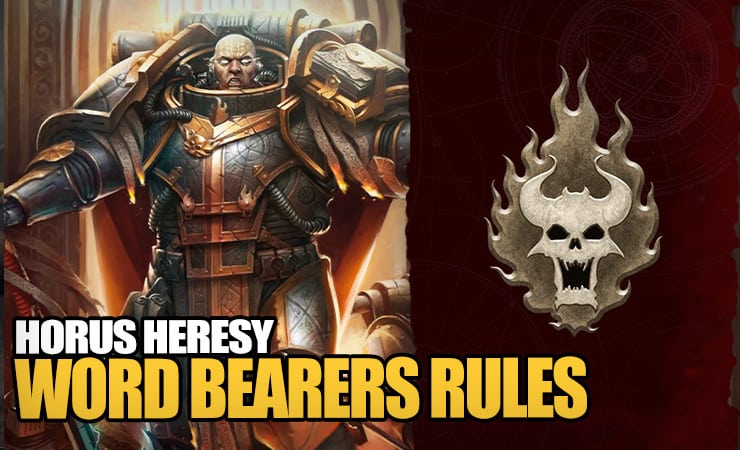
With the release of the starter and new edition imminent, it’s time for GW to start revealing new HH rules. This time around, they are focusing on a legion known for its tendency to bend a few rules…
Warhammer Community showed off some new legion-specific rules; let’s check them out!
The Horus Heresy Word Bearers Rules Will Cleanse the Galaxy!
Their iron-clad faith gives the XVII Legion an unshakeable bravery in battle – faced with the most terrifying foes, these True Believers trust that a higher power will deliver them from doom. This infectious belief is hard to resist even for their opponents, who find themselves shouted down by Legionaries bellowing bellicose battle sermons. That’s diplomacy for you.
Winning combats is big in Horus Heresy, so counting all draws for your side will be something really sweet! Never having your LD reduced either is pretty nice as well.
Faith is its own reward, of course… but the Ruinous Powers are generous masters. The Word Bearers piled up heaps of confiscated occult lore over the Great Crusade, and not all of it was turned into kindling – while prosaic Legions waste time with technological trinkets, Lorgar’s most dedicated preachers study the Burning Lore of the empyrean, learning to command soul-scourging Hellfire. Well, mostly command it.
An S7 AP4 template is strong in itself, then when you add rending, it’s really strong. However, you have to take a psychic test every time you use it, so just hope you’ve said your prayers and you get to use this weapon without killing your own unit!
Lorgar Rules
GW didn’t show off any, but we’ve seen leaked rules, so take them with a grain of salt as they could change, but look pretty good.
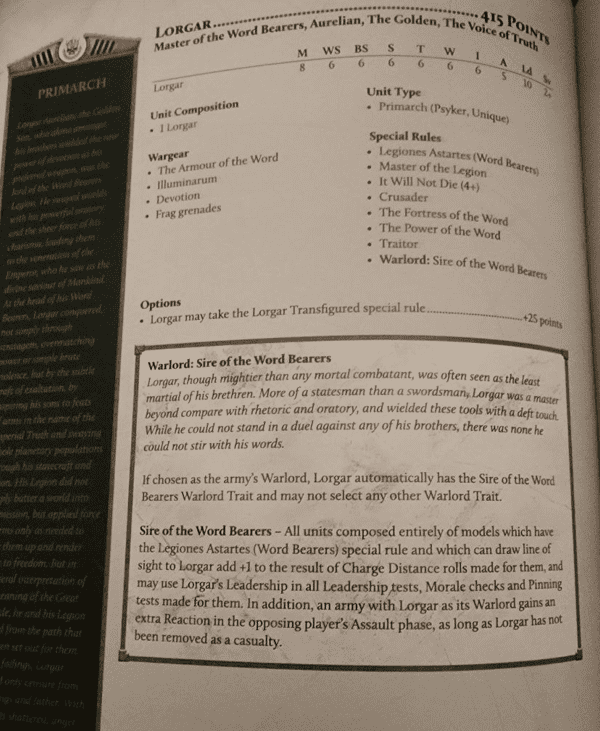
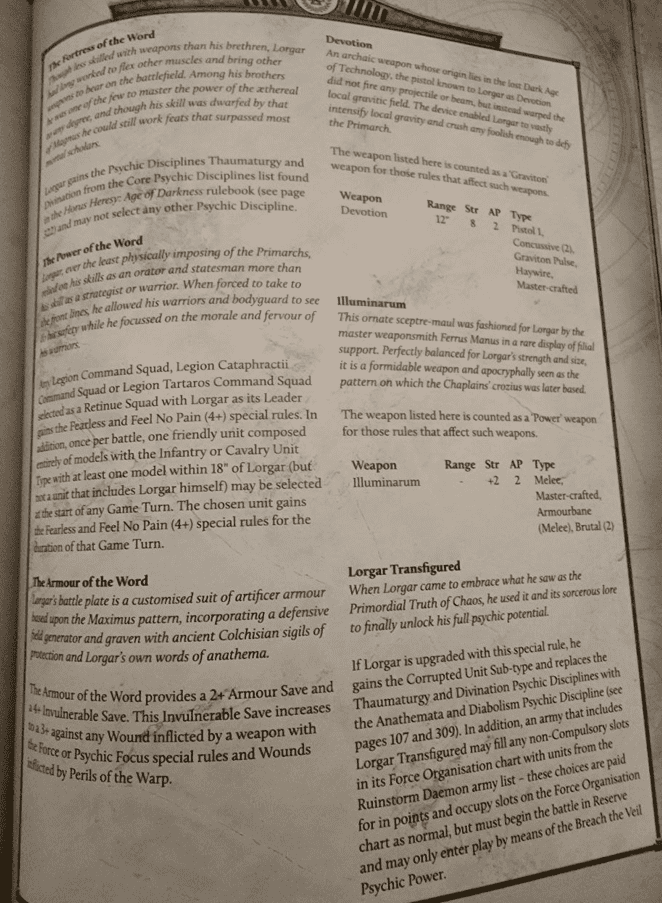
Legion Specific Rules Rumors
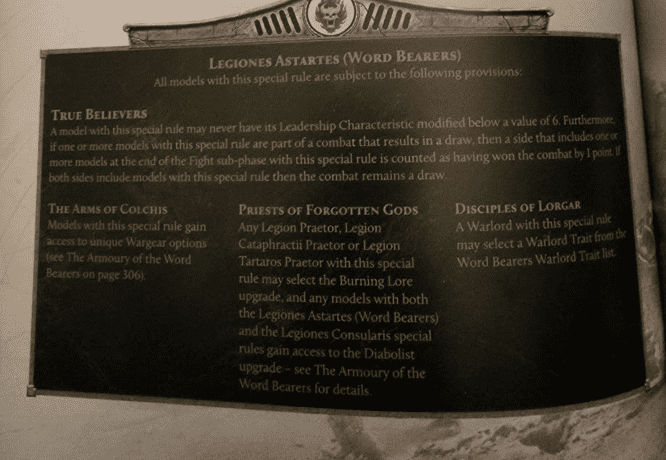


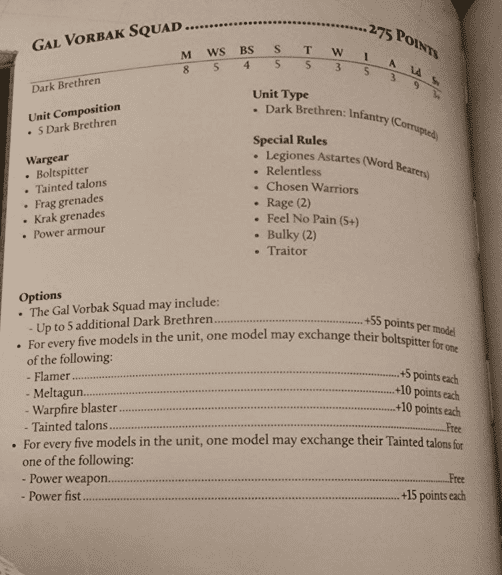
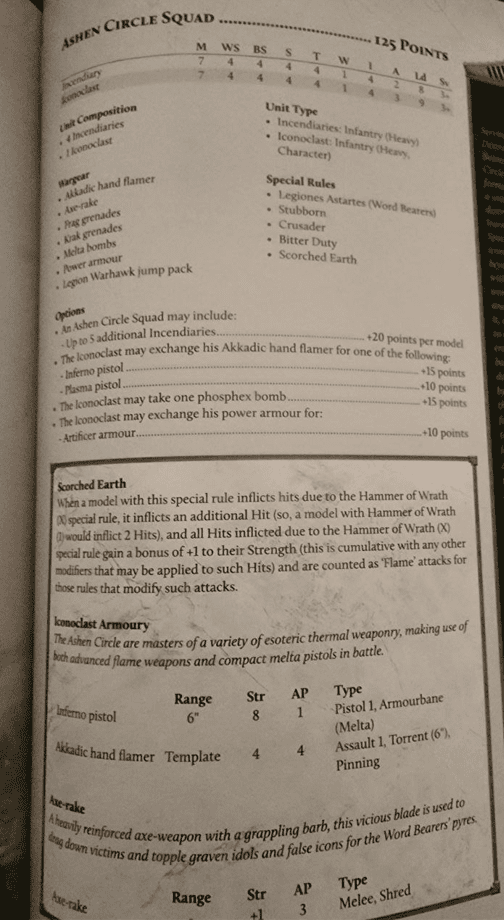
Click Gallery below for full-size images.
Here’s the most up-to-date list of new Horus Heresy Rules & Product Leaks. Click on the gallery above to see new Horus Heresy models and rules rumors!
- 4 New Plastic Horus Heresy Starter Box Sets
- All the Horus Heresy New Models & Rules
- Horus Heresy Legion Rules
- Horus Heresy Weapon & Unit Rules
All the Newest GW Model & Rules Previews
What do you think about the new rules and rumors for Horus Heresy Word Bearers so far?
Let us know in the comments of our Facebook Hobby Group, and make sure you enter the latest monthly giveaway for FREE today!
Get ad-free access to our videos, a monthly crate of miniatures, and support some of the best creators out there for as little as $6 a month on Patreon!
If you buy something from a link on our site, we may earn a commision. See our ethics statement.
If there is a hierarchy of treachery, then the Word Bearers sit in its highest circle. Once the most devoted and rigorous of warriors, it was not enough that they fell, but they pulled their brother Legions into the abyss with them.
Сортировать по:
Новинки выше
- От А до Я
- От Я до А
- Дешевые выше
- Дорогие выше
- Популярные выше
12 На страницу
- 24 На страницу
- 48 На страницу
- 96 На страницу
Показывать товары, которых нет в наличии
- Скрыть товары, которых нет в наличии
Zardu Layak and Blade-slaves Bodyguard
ID:
FW_99560102229
Once a devout believer in all that the Imperium stood for, at the Battle of Calth it was clear to those who witnessed the atrocities he masterminded that Zardu Layak, the Crimson Apostle, had fallen completely into darkness along with the rest of the Word Bearers Legion. Suffused in dark powers…
12,380 руб
Нет в наличии
Предзаказ
+
−
WORD BEARERS LEGION GAL VORBAK
ID:
FW_99590102168_mail
The Gal Vorbak is built upon the remnants of the Serrated Sun Chapter of the Word Bearers Legion, the conquerors of the primitive world of Cadia who looked into the depths of the Eye of Terror itself and in doing so were changed for all time. Their psyches infiltrated by creatures from the…
10,900 руб
Нет в наличии
Предзаказ
+
−
“Come to me and answer for your madness!”
The Word Bearers are a fun, flavorful faction with a lot of deck-building options and synergies. They can play aggro, control, and everything in between. They have enticing options for both new players and those ready to put a growing collection to use. As an added bonus, they also have some of the best voice lines in the game.
Editor’s note: After a couple months of funemployment it looks like I’ll be working at my dream job soon, so I’ll have way less time for these sorts of posts.
Strengths
Daemonhost. Word Bearers have lots of ways to generate daemonhost buffs on infantry and astartes, which often is their path to victory. A troop given daemonhost gains the following:
-
One of the following buffs until they have all four from stacking daemonhost: Ward (immunity to targeted tactics), Survivor 3, Terror, Cleave 2, or Unstoppable+Flank.
-
If they have all the above bonuses already, they instead gain +2/+2. With the right cards it can be easy to set up stacked daemonhost buffs and end games with chaos dunks.
-
They are treated as daemons for purposes of mechanical effects, which can be important. They don’t lose their other troop type, but they are no longer affected by things that affect only non-daemons, like, ironically, marks of chaos. You can mark a troop before giving it daemonhost, however.
There’s a degree of RNG here, but all of the buffs are useful. I find myself hoping for Ward or Survivor 3, but the others can make a big difference as well.
Chaos Synergy. Word Bearers love chaos cards, particularly infantry and daemons, but sometimes the chaos damage tactics as well. No other faction has synergy with neutral cards in the way Word Bearers do with chaos.
Many Word Bearers cards create random chaos cultists and daemons, often sacrificing the cultists with other triggered effects to create daemons or other buffs.
It gives you a huge amount of depth for alternate cards if you are missing certain Word Bearers cards or want to create a themed deck. Your junky chaos cultists are notes in a larger symphony.
This synergy lets you do several possible things:
-
Go “wide” with your board and overwhelm the opponent with more troops than they can handle.
-
Create situations where your opponent must deal with your weak cultist cards first so they can’t be used as fuel for much bigger plays next turn, leaving your other key troops intact to cause more trouble.
Removals/damage bombs. Using their tactics, a few key troops, and sometimes their warlord, the Word Bearers are efficient at clearing the board, removing big threats, and screwing up the opponent’s troop flow.
Weaknesses
Precarious combos. I find Word Bearer players must be more careful than most.
-
Often you are playing stuff to board on the idea that some of what you drop will stick to your next turn. If your opponent has board control and you need to battle back, you sometimes must take selective shots and wait for the right situation. The right counter at the wrong time can be worse than doing nothing at all, because then you don’t have the counter when you really need it.
-
There are several Word Bearer cards that are great, but are also useless if they are played on curve when you have nothing else out, so you need ways to reliably build board early.
These problems make Word Bearers somewhat predictable, so it’s sometimes a matter of whether your opponent can efficiently counter wide boards and negate big troops. You’re vulnerable to jams and reactive play, so Sisters of Silence and Custodes are big trouble spots, and there are lots of neutral jam cards now.
Unbuffed troops don’t trade hits well. If you can’t get a buff on your troop, or the right buff, it’s often going to have a hard time winning a shooting war with an enemy troop of similar energy value. You’re reliant on the boons that chaos chooses to give you, through RNG daemonhost buffs or your card draws.
Some underwhelming troops without immediate impact. Your high-level deckbuilding is going to feel predictable the more you stay in-faction, because the list of Word Bearer cards you are likely to take is short. There’s a ton of dead weight troops and bad buff tactics in this legion.
Warlords
Argel Tal was recently buffed to deal 2 damage instead of 1, which gives him more utility, though whether it lifts him from just being a semi-joke option compared to Just Play Raum is another issue. Act again is cool and punishes your opponent for using low-health troops.
It’s worth noting that Argel Tal can:
-
Target his own units with his 2E, which can also trigger other “my troop dies, so this happens” mechanics you have active on board.
-
Gain the -2 cost to Blessed Son whether he uses his 2E or smacks a troop to death, as it’s not battle honour.
Argel Tal’s good friend, who is probably the strongest 30-health warlord in the entire game, a regular feature of meta reports. He’s amazing:
-
3 damage all the time, no berzerk, no -1 damage off-turn or when you have troops out, just 3 damage.
-
Remove troops at 3 health or under and regain 2 health, while spending no energy. You need a strong control deck to survive Raum’s onslaught when he’s going pure aggro.
-
Unstoppable, so front lines don’t much matter unless they’re in the way of other troops.
-
High initiative, so you often go first and set the tone.
The “drawback” here is the 15 chaos cards. That’s not such a drawback if your goal is to climb to Terra, because chaos cards have lots of aggro synergy. It’s how I did it. I would get spanked by Gabriel Santar and tactics Angron, but not so much that I wasn’t climbing. He’s also a convincing cultist deck choice.
As opposed to Raum’s blazing speed, Erebus is very slow. The general chain of events to his 2E:
-
Create a 3/3 summoning circle, which is immune to everything and does not count as a troop, so it can’t be killed, yanked back to hand, further buffed, or anything.
-
If Erebus spends 2E on his next turn, the daemon-in-waiting gains +2/+2 and a random daemonhost buff (everything except flank). This can extend infinitely upward if you’re just trying to make a point that chaos reigns supreme, but the daemon doesn’t get the extra +2/+2 from having all the daemonhost buffs.
-
If Erebus doesn’t spend the 2E, the daemon appears at the end of Erebus’ turn, so it only matters on the next turn.
Despite his role as the self-described true mastermind of the entire heresy (always the tools of chaos believe themselves the masters), he’s underwhelming in most situations.
Zardu is a potent warlord if you want a mix of buff potential and always-available board clearing, as well as a little less RNG on your daemonhosting. I’ve been embarrassed a few times by Zardu—you end up in a situation where you’d better clear everything he drops before its next turn.
These days, with so many jams floating around out there, the Anakatis Blade risks becoming a lost turn, even if the buffed troop becomes warded (shakes fist at Watchers in the Dark).
Note that the Anakatis can only be placed on astartes.
The new Galaxy in Flames warlord, Kor has long been awaited by Word Bearers fans after being teased as a possible addition during PVP events. His main advantage is that you don’t need to put any chaos cultists in your deck to gain the benefit of the faction’s many «destroy this troop» combos. You can focus your deck more on astartes and throw in some troops that you ordinarily don’t have room for. He’s going to maximize the value of Malnor Veterans.
You can also just mainline chaos cult decks more successfully than most warlords and tick down the cost of Summoning Ritual or Mass Offering much faster, if that’s a style you’re looking into. Some of the 2E chaos cultists, particularly Signus Fanatic, Horsa Cultists, or even Righteous Zealot, are quite handy.
Bearer of not just the Word but the best voice lines in the game, Lorgar is an intriguing support warlord who I find fun to play. His early game is slow, but like Zardu, if he is allowed to build board or spend any spare actions on creating daemonhost cards, he becomes a menace.
“Friendly daemon in play” includes:
-
Your garden variety chaos daemons from the neutral sets
-
Troops with daemonhost
-
Troops marked as astartes/daemon in their description, whether or not they have daemonhost
Between these three types, you have a lot of ways to make a triple word score. Transfigured Lorgar is very powerful and has to be put away quickly once he emerges, because your opponent will struggle to have any board from then on.
Lorgar also has enhanced synergy with daemons out of the gate, so anything with maintenance 1 is effectively no maintenance. After he achieves whispers or just plays Book of Lorgar, everything’s no maintenance.
Cards
You should favor troops that create cultists, daemons, or daemonhost buffs, rather than tactics that do so. Your tactics should be focused on offense. As usual for most factions, your most impactful stuff is typically between 3-7E.
S-Tier
Architect of Heresy. A removal and a reversal of fortune that you can then beef up with daemonhosts, ending a game.
Ashen Circle. Your mid-game response troop.
Dagotal Bikes. Cannot over-emphasize how important this card is to an early game that can be somewhat shaky, and trolling Night Lords/Raven Guard.
Dark Blessing. The essential “win the game at 9E or 10E if you have any astartes out” card. Simple.
Diabolist Vhol. Probably your strongest 5E play. His text is worded strangely, because by the time he procs his effect, he’s always a daemon, so he gets that +1/0 too.
Jadimas Squad. Just craps out value and must be dealt with immediately.
Kamiel. This is likely going to be important to maintaining a competitive game.
Sor Bakhpal. Not a guy you should play on curve, but rather something you build momentum with.
Xesugal Squad. It’s near impossible for an opponent to get rid of everything this guy produces before your next turn.
A-Tier
Balthamir’s Sword. I’m never going to shy away from a removal, even an expensive one. The stun can help you maintain your board.
Captain-Apostle. No immediate value besides “is a daemon,” but if he gets a hit off you probably have Lorgar’s whispers.
Dark Brethren. Sort of a reverse Diabolist Vhol, and just about as dangerous, but not quite as reliable for immediate value.
Dark Martyr. An upscale version of Possessed Marine. I think the Possessed is slightly better because it comes out earlier and the relentless doesn’t matter that much, but this guy’s good too.
Destiny’s Hand. This will come in handy to swing the board, kill jaegers, mess up stealth units, create Lorgar whispers, etc.
Gorlem Squad. A reliable 3E curve play to keep your opponent distracted.
Kurtha Sedd. Sedd is a big threat with or without survivor. Every greater daemon is a huge problem, most being game enders.
Possessed Marine. No immediate value, but if you have any daemonhost bonuses lined up, you can use him to smash the board.
Tear in Reality. Your opponent gets a big threat out, and then that threat and a random cultist have an adventure in the Warp together.
B-Tier
Bargotal Squad. Likely to be Melgator’d. 6 health is OK, you’re not required to use his ability.
Book of Lorgar. A situational card for when you want to build a daemon deck, but a good card in that use case. Daemon decks are fun, if not hyper-competitive.
Boradol Squad. A sleeper choice for aggro decks.
Chosen of the Gods. I don’t hate this card as much as I do other missions, but it feels a little overkill compared to just playing regular Lorgar and will still cock up your early progression.
Gallek Squad. This guy’s art is cool as hell. Sneak attack also good. Ward is neat. No immediate value on a 3 health troop is not that exciting.
Heralds of Truth. If you’re obsessed with daemons and want to combo quickly off bikes or Ashen Circle, sure.
Kalim of the Annunake. OK so the potential of a 9/11 front-line dreadnought is not nothing, but I feel you need earlier plays and more daemonhost synergy than this.
Khoura Squad. It bears mentioning that Righteous Zealot is pseudo-sticky and could provide you two cult sacrifices.
Kohlek Squad. That’s a lot of damage that you’re pretty much never going to proc, in a situation where you probably want to damage troops more. 3/3 front line is not complete crap, though.
Malnor Squad. Potentially a very annoying troop for your opponent if you are going heavy cultists.
Mhara Gal Dreadnought. Incredibly strong vehicle that is a brick until late and provides no immediate value on drop. Much more exciting when I get him off Summoning Ritual.
Rongar Squad. Tied with Bargotal Squad for your least impressive 5-drops. I haven’t dropped them into Meh category because if you need bodies, you need bodies, but I’d be unlikely to rely on them.
Sor Talgron. Talgron is basically a Host of Devils card who can generate a board suddenly. The problem is how long you think your warlord is going to hold out for this guy to get out and matter.
Torgal Squad. Very occasionally I’ve gone ham with this guy in the right setup, but it’s fairly unlikely he’ll live to see battle honour.
Vhandrax Squad. Potentially very good in the right setup.
Meh
Arthustra. I am a big fan of resolution troops, but this is a little underwhelming in a faction where you usually want more astartes synergy. It is all things considered your worst 7-drop.
Dark Channeling. Overcosted, given that at this phase of the game you need more impact.
Dark Oratory. Again, I feel this is overcosted and too situational.
Derenoth Squad. I’m not convinced this is an efficient use of your cultists compared to the more impactful Ashen Circle.
Dorboral Squad. This is definitely a dude who is 2/3. Bikes, Xesugal, or even Khoura I think are a lot better.
Fanatical Zeal. Heal 3 is unlikely to get you out of a lot of trouble, and heal 3 and then… One 2E cultist is underwhelming.
Harbingers of Chaos. I suppose you could do something clever like a combo with Ornatov’s Barge or Taghmata Formation, but that’s just so specific and so 10E.
Mutant Astartes. I hate this card, he doesn’t have a stat line that suggests I want him out there borking up my board in a legion that is about establishing board control if I am going this late in my deckbuild.
Primordial Calling. Lame, again I am just thinking about my other 3E options, which are mostly better.
Razing of Monarchia. These types of deck buff cards are momentum killers.
Secret Devotion. Overcosted. You have so many other more productive ways to make cultists with your troops, and you don’t have enough energy left to do something nifty like move into Destiny’s Hand.
Sethilon Squad. Like a worse Jadimas Squad, that is somehow supposed to competitive with your other very good 4E troop options.
Testamentum Veritas. Pretty boring, your output here is a 3/3 daemon that may cost you 1 maintenance if you are not Lorgar, or at least booked up.
Zealous Pawn. I don’t see a tremendous amount of utility here compared to other uses for sacrifices. You are not going to ever out-beef an opposing control warlord, you need to build board.
Other Cards
Chaos Cultists: I could write a whole post about chaos cultists and assorted chaos infantry who don’t have the cultist tag, and maybe I will, but I believe the best are:
Aklion, Wordsinger
Cultist Brute
Cultist Sorcerer
Dark Retinue
Insurgent Leader
Priest of Old Faiths
Signus Demagogue
Signus Fanatic
The Brotherhood
Daemons: Khazdrak, Father Decay, and Yria are the standouts, but pretty much all are at least useful.
The Best Card Choices by Energy Level
0-1E: Boradol Squad
2E: Dagotal Bikes, Dark Blessing, Tear in Reality, Xesugal Squad
3E: Gorlem Squad, Sor Bakhpal
4E: Ashen Circle, Jadimas Squad
5E: Dark Brethren, Diabolist Vhol, Kamiel, Kurtha Sedd
6E: Destiny’s Hand, Possessed Marine
7E: Architect of Heresy, Balthamir’s Sword, Captain-Apostle, Dark Martyr
8E: Kalim of the Annunake (if I had to pick one)
9E: Sor Talgron
10E: Mhara Gal Dreadnought
Deck Ideas
Argel Tal
The Trooper
Go wide early and often.
* 2x Boradol Squad
* 2x Khoura Squad
* 2x Xesugal Squad
* 2x Testamentum Veritas
* 2x Fanatical Zeal
* 2x Gorlem Squad
* 1x Sor Bakhpal
* 2x Kohlek Support
* 2x Jadimas Squad
* 2x Sethilon Squad
* 2x Ashen Circle
* 2x Derenoth Squad
* 1x Kurtha Sedd
* 2x Rongar Squad
* 2x Secret Devotion
* 2x Destiny’s Hand
Raum
Raum Beginner
I would struggle to tell people to run Argel Tal in non-Raum form as a beginner deck with a straight face. Raum is just much easier with a limited collection and will remain strong. You can play to 2500 with commons.
* 2x Seek and Destroy
* 2x Horsa Cultists
* 2x Fire Cultist
* 2x Informant Network
* 2x Krak Grenade
* 2x Lasrifle Section
* 2x The Trap
* 2x Supply Lines
* 2x Artillery Strike
* 2x Sagitarii Squad
* 2x Mortar Strike
* 2x Volcanic Instability
* 2x Defence Satellites
* 2x Hanun’s Mortars
* 2x Helios Mortar Carrier
Dread Cult
Make the most of cult synergy with Raum, keeping things at a low curve so you’ve always got plays.
* 2x Signus Disciple
* 2x Signus Fanatic
* 2x Dark Blessing
* 2x Horsa Cultists
* 2x Righteous Zealot
* 1x Sor Bakhpal
* 2x Jadimas Squad
* 2x Ashen Circle
* 2x Aklion, Wordsinger
* 2x The Eightfold Brand
* 1x Kurtha Sedd
* 2x Rongar Squad
* 2x Signus Demagogue
* 2x Diabolist Vhol
* 2x Kamiel
* 2x Khazdrak
Erebus
Floods of Chaos
A mix of troops that specialize in putting more troops in play, and troops that like when you do that. Quickly draw your removals.
* 2x Boradol Squad
* 2x Signus Acolyte
* 2x Signus Fanatic
* 2x Khoura Squad
* 2x Xesugal Squad
* 1x Command Bridge
* 2x Gorlem Squad
* 2x Jadimas Squad
* 2x Dark Retinue
* 2x Signus Demagogue
* 2x Rongar Squad
* 2x Malnor Veterans
* 2x Insurgent Leader
* 2x Corrupted Arcology
* 2x Balthamir’s Sword
* 1x Architect of Heresy
Zardu Layak
Awakened Astartes
Heavy on astartes, not so much on cultists.
* 2x Drilling Site
* 2x Dark Blessing
* 2x Dorboral Squad
* 2x Xesugal Squad
* 1x Sor Bakhpal
* 2x Gorlem Squad
* 2x Torgal Squad
* 2x Jadimas Squad
* 2x Dark Brethren
* 2x Diabolist Vhol
* 1x Kurtha Sedd
* 2x Kamiel
* 2x Possessed Marine
* 2x Dark Martyr
* 1x Architect of Heresy
* 2x Balthamir’s Sword
* 1x Father Decay
Kor Phaeron
Master of Faith
Trying for Chosen of the Gods. Trying really hard.
* 2x Drilling Site
* 1x Chosen of the Gods
* 2x Gorlem Squad
* 2x Kohlek Support
* 1x Sor Bakhpal
* 2x Ashen Circle
* 2x Derenoth Squad
* 2x Gallek Squad
* 1x Book of Lorgar
* 1x Kurtha Sedd
* 2x Vhandrax Squad
* 2x Malnor Veterans
* 2x Kenrich
* 1x Architect of Heresy
* 2x Kalim of the Annunake
* 2x Mass Offering
* 2x Summoning Ritual
* 1x Slayer of Worlds
Lorgar
General Recommended
* 2x Command Bridge
* 2x Dark Blessing
* 2x Dagotal Bikes
* 2x Xesugal Squad
* 2x Gorlem Squad
* 1x Sor Bakhpal
* 2x Ashen Circle
* 2x Jadimas Squad
* 2x Diabolist Vhol
* 2x Kamiel
* 1x Kurtha Sedd
* 2x Destiny’s Hand
* 2x Possessed Marine
* 1x Architect of Heresy
* 2x Balthamir’s Sword
* 2x Dark Martyr
* 2x Captain-Apostle
Minister of Chaos Absolute
The Baleful Assembly whale deck.
* 2x Nurglings
* 1x Command Bridge
* 2x Terror Hounds
* 2x Screamers
* 2x Priest of Old Faiths
* 1x Book of Lorgar
* 2x Battle Flies
* 2x Beast of Phyra
* 2x Ti’Lath’s Changers
* 2x Khazdrak
* 1x Ti’Lath
* 2x Dark Channelling
* 1x Abyssa
* 1x Soh’f’epok
* 2x Balthamir’s Sword
* 1x Architect of Heresy
* 1x Yria the Seducer
* 1x Father Decay
* 1x Baleful Assembly
* 1x Slayer of Worlds
Lambs to Slaughter
Sacrificial troops that you can easily trigger the effects on, with lots of tactics-based damage.
* 2x Nurglings
* 2x Heralds of Truth
* 2x Khoura Squad
* 2x Cultist Acolyte
* 2x Dark Blessing
* 2x Orbital Siege
* 2x Cultist Sorcerer
* 2x Ashen Circle
* 1x Kurtha Sedd
* 2x Rongar Squad
* 2x Volcanic Instability
* 2x Kamiel
* 2x Destiny’s Hand
* 1x Architect of Heresy
* 2x Mutant Astartes
* 2x Mass Offering
Other Guides
Mr. Midnight
Raum https://youtu.be/dJsdC-qRDs0
Lorgar https://youtu.be/gJ1gHAsI6sU
Pirate Lahaie
Raum https://youtu.be/atSsLtvNUTI
Sir Eisenstein
Lorgar https://www.youtube.com/watch?v=NvlC9F8tj_M
Vapix
Erebus https://youtu.be/k3idvy-OeQs?t=1
My Other Faction Focus Posts
Alpha Legion
Emperor’s Children
Iron Hands
Night Lords
Ruinstorm
Sons of Horus
Ultramarines
World Eaters
My Other PVE Guide Posts
The Fires of Nocturne (Salamanders vs. Thousand Sons)
Burning of Prospero (Thousand Sons vs. Space Wolves)
Signus Prime (Blood Angels vs. Ruinstorm)
Isstvan III (World Eaters vs. Anybody They See)
Ravendelve (Raven Guard vs. Alpha Legion)
Shadow Crusade (Word Bearers vs. Ultramarines)
Blighting of Terra (Death Guard vs. White Scars)
Battle for Lion’s Gate (Iron Warriors vs. Imperial Fists)
I hear the music of eternity.
Lorgar Aurelian, Primarch of the Word Bearers, XVII Legion
The Horus Heresy: Legions begins its fourth major content expansion, The Battle of Calth. The Word Bearers march to battle first. Are you ready to become a weapon of the Ruinous Powers?
New Legion: Word Bearers
Imbued by unshakeable faith in the Ruinous Powers, the XVII Legion has desecrated the Emperor’s great design and allowed Daemons to possess their Space Marines. As they march for Calth, millions of fanatic cultists follow them to die fighting for their masters in battle or to become sacrifices for their unholy rituals.
New Event: ‘The First Heretic’
Return to Isstvan V and betray your former brothers during their misguided assault against Horus. The Word Bearers unleash their recent warp-tainted forces on the Raven Guard, When Corax begins slaughtering them, Lorgar steps in to save them.
Three collectable Warlords lead the masses of believers and warriors against the forces of the False Emperor:
● Argel Tal: Lord of the Gal Vorbak, and host of the Daemon Raum, who possessed him during his pilgrimage into the Eye of Terror. Embittered by the horrors of the warp, he nonetheless serves the holy purpose of the Chaos gods.
● Erebus: The self-proclaimed Hand of Destiny and architect of the Horus Heresy. A worshiper of Chaos whose power and dark knowledge has grown so large he can summon Daemons into realspace… if enough blood is spilled.
● Lorgar Aurelian: The Primarch of the XVII Legion believed the Emperor to be a god once, and was punished for it. Now he comes back, transfigured by the Primordial Truth and gifted by the Ruinous Powers with a new faith.
New Trait: Daemonhost
Troops bearing this trait receive a random buff out of a selection of five and add ‘Daemon’ to their unit type, becoming a hybrid troop– for better and for worse. Daemonhost buffs stack just like Marks of Chaos but, after receiving all five, your unit will get a unique 6th buff that makes it stronger with every further Daemonhost stack.
Speaking of traits, Cleave and Sacrifice now have new icons!
How to Get Word Bearers Cards
You can collect the XVII Legion’s cards in several ways:
● Each reward crate in the ‘The First Heretic’ event has at least 1 Word Bearers card.
● Word Bearers crates in the shop have at least 3 Word Bearers cards, 1 of them rare of better.
● A constructed deck in the shop, with Argel Tal as warlord and an exclusive card back. Any duplicates you receive are converted into gems.
● Cards for sale with gems in the Daily Shop.
The Word Bearers are now live. May the Primordial Truth reign supreme!
The Horus Heresy: Legions is available on Steam, iOS and Android.
ABOUT EVERGUILD
Everguild Ltd. is an independent game studio operating from the UK and Spain, committed to making deep and polished games with a never-seen-before twist. Everguild is pushing the boundaries of the CCG genre on mobile, with its acclaimed first title, ‘Drakenlords: CCG Card Duels’, and the more recent ‘The Horus Heresy: Legions’, based on Games Workshop®’s renowned setting, The Horus Heresy®. More information about Everguild can be found at everguild.com/press
ABOUT GAMES WORKSHOP
Games Workshop® Group PLC (LSE:GAW.L), based in Nottingham, UK, produces the best fantasy miniatures in the world. Games Workshop designs, manufactures, retails, and distributes its range of Warhammer®: Age of Sigmar® and Warhammer® 40,000® games, miniature soldiers, novels and model kits through more than 500 of its own stores (branded Games Workshop® or Warhammer®), the www.games-workshop.com web store and independent retail channels in more than 50 countries worldwide. More information about Games Workshop and its other, related, brands and product ranges (including its publishing division ‘Black Library’ and its special resin miniatures studio ‘Forge World’) can be found at www.games-workshop.com.
The Horus Heresy: Legions© Copyright Games Workshop Limited 2020. The Horus Heresy, The Horus Heresy Eye logo, GW, Games Workshop, Space Marine, 40K, Warhammer, Warhammer 40,000, 40,000, the ‘Aquila’ Double-headed Eagle logo, and all associated logos, illustrations, images, names, creatures, races, vehicles, locations, weapons, characters, and the distinctive likeness thereof, are either ® or TM, and/or © Games Workshop Limited, variably registered around the world, and used under licence. Drakenlords and Everguild are registered trademarks of Everguild Ltd. All rights reserved to their respective owners.
Followers
Disclaimer
This blog is in no way official or endorsed by Games Workshop Limited. Nor is it official or endorsed by any other company that may be mentioned. All photographs, images and paint-work that are posted are originals by the author unless indicated otherwise. The miniatures, subject matter and sculpts used are copyrighted by Games Workshop Limited and other companies. The full disclaimer is here.
Contact
To get in contact with the authors of Warpstone Flux, please email directly to:
warpstoneflux@gmail.com .
We will try to get back to you as soon as possible — usually within 48(ish) hours. But at busy times, it might be a bit longer for us to get back to you.
Privacy Policy
The Privacy Policy of this blog extends and incorporates Google’s own Privacy Policy.
Details of said policy can be found here: http://www.google.com/policies/privacy/
In addition to this, for people wanting to comment on the blog, you are more than welcome to do so! But please note, the blog does not allow anonymous commenting due to earlier issues with this (i.e. spam). Jabberjabber will try to respond to most genuine questions posted in the comments, depending on his real life time commitments. Which is to say, he’s a busy chap and might not always be able to get back to you immediately!
Labels
-
2eHHReview
(229) -
6th
(27) -
6thdaemonsreview
(42) -
7th
(4) -
8th
(14) -
alpha legion
(109) -
anvilindustry
(19) -
aos
(24) -
apocalypse
(58) -
army lists
(54) -
Astulae
(5) -
basing
(34) -
battle report
(38) -
black legion
(9) -
black templars
(12) -
blackshields
(6) -
blood angels
(28) -
blood ravens
(12) -
bloodletters
(25) -
board games
(13) -
carcharodons
(4) -
challenges
(114) -
chaos space marines
(340) -
CNC
(11) -
comparisons
(9) -
contemptor
(7) -
conversions
(163) -
craters
(10) -
crimson fists
(6) -
CSM6thReviews
(51) -
custodes
(18) -
daemon princes
(31) -
daemonettes
(22) -
daemons
(311) -
DAin6thReviews
(34) -
dark angels
(83) -
dark eldar
(15) -
darksun
(24) -
death guard
(94) -
dornian heresy
(6) -
dreadnought
(35) -
dungeons and dragons
(33) -
eldar
(25) -
elites
(185) -
emperors children
(40) -
fast attack
(125) -
forge world
(203) -
fortifications
(13) -
gaming
(82) -
genestealercultsreview
(17) -
genestealers
(29) -
greater daemons
(31) -
grey knights
(35) -
GT2007
(8) -
GT2008
(12) -
GT2009
(16) -
Gt7Tournament
(2) -
heavy support
(123) -
HHReview
(408) -
horrors
(38) -
horus heresy
(29) -
hq
(291) -
imperial fists
(28) -
imperial guard
(13) -
imperialis militia
(23) -
Inquisition
(1) -
iron hands
(35) -
iron warriors
(30) -
khorne
(71) -
khorne berzerkers
(24) -
killteam
(5) -
knight-errant
(5) -
knights
(12) -
lesser daemons
(88) -
Lords of War
(55) -
lotr
(5) -
luna wolves
(2) -
malal
(6) -
mantic
(2) -
maxmini
(4) -
mechanicum
(44) -
misc
(216) -
name generation
(9) -
necrons
(37) -
night lords
(31) -
noise marines
(7) -
nurgle
(127) -
orks
(20) -
painting
(318) -
perennia
(37) -
plague marines
(57) -
plague zombies
(3) -
plaguebearers
(38) -
planetary and mighty empires
(34) -
planetstrike
(7) -
primarch
(49) -
quantum gothic
(10) -
questoris knights
(17) -
raptors
(16) -
raven guard
(50) -
ReckoningTournament
(3) -
rpg
(43) -
rules
(63) -
salamanders
(43) -
scenarios
(25) -
scenery
(145) -
scibor
(5) -
screamers
(12) -
sequestered industries
(6) -
sisters of battle
(14) -
sisters of silence
(11) -
slaanesh
(50) -
solar auxillia
(29) -
sons of horus
(24) -
sons of malice
(10) -
space hulk
(9) -
space marines
(176) -
space wolves
(42) -
statistics
(34) -
stormcast
(1) -
super heavy
(37) -
tactics
(27) -
tanks
(85) -
tau
(13) -
technology
(6) -
terminators
(81) -
thousand sons
(33) -
titan
(43) -
transports
(13) -
troops
(182) -
truescale
(9) -
ttcombat
(1) -
tyranids
(21) -
tzeentch
(74) -
ultramarines
(24) -
unbrokenchain
(124) -
undivided chaos
(9) -
wargames gallery
(122) -
WarhammerWorld
(51) -
Wasp Campaign
(30) -
wfb
(55) -
white dwarf
(10) -
white scars
(21) -
white wolf
(1) -
word bearers
(32) -
world eaters
(40)
Word Bearers Diabolists «You need not fear the darkness, for you are the darkness» — Sor Talgron «The Warmonger»
Space Marine Terminator (Word Bearers) This is Brother Vardox of the traitorous Word Bearers Legion, ready to desecrate imperial worlds in the…
A Word Bearer is summoning a demon. GW later asked me to change the demon to a more specific one – a pink horror of Tzeentch. The working title…
Brother Caerus. I wanted to pay tribute to the incredible comic strip made by @chillstrand. I hope you will enjoy this…
Warhammer 40000. Word Bearers
Reverberate Magic The Gathering — Universes Beyond: Warhammer 40000 AD: Colin Boyer
Lorgar Aurelian. Warhammer 40k. FanArt.
The Horus Heresy Primarchs and some other of my favorite characters from the Horus Heresy Book Series Lorgar — World Bearer Gold…
Erebus Card illustration for Horus Heresy: Legions.
Word Bearers Close up of an old commission I did that I forgot to post , new stuff will come soon
Heresy Era Word Bearers Legionnaire
Prophet of Damnation This veteran Word Bearer had seen a thousand wars. Enslaved dozens of weaker souls, wrecked havoc on the weakining,…
This is the result of applying all the realism stuff I been working on lately to some 40k.

